
Meaningful and Spiritual Travel Experiences Worldwide


12 Stunning Pilgrimage Sites in France
Last Updated on: 29th December 2023, 01:06 pm
A Pilgrimage to France is a must-do for Christians interested in the history of their faith. France is home to some of the world’s most beautiful cathedrals , monasteries , and shrines. A Catholic pilgrimage to France allows the pilgrim to visit a huge variety of sites with spiritual meaning from antiquity through to those with connection to quite modern Saints.
The Best Pilgrimage Sites in France
France is home to more than 100 cathedrals and large abbeys. While perhaps the most famous churches in France are the churches of Paris – there are many more!
Pilgrimage sites in France are all over the country, with many in Paris – which is a great place to stay in France to start your pilgrimage , but most of France’s pilgrimage sites rise out of France’s glorious countryside. From the West coast in Normandy, to the South of France filled with Lavender fields, these French pilgrimage sites provide both natural beauty and architectural beauty, not to mention spiritual insight to all travelers. When you plan your pilgrimage to France, take stock of these diverse, spiritually powerful, and beautiful pilgrimage sites in France!
Where to Stay for Pilgrimage Sites in France
Most pilgrimages to France will start in Paris, which has so many beautiful (and affordable) hotel options! A few of the sites below are accessible as a day-trip to Paris, but most will require seperate accomodation. For each pilgrimage site I’ll suggest a well-reviewed hotel or one I’ve personally stayed in. A few of these sites may even have a local monastery that you can stay in if that’s of interest (often best for single women or men traveling alone, but occassionally good for couples.)
✈︎ Do not forget to purchase comprehensive travel insurance before you leave for your Pilgrimage to France! France is a safe country but an unexpected accident can ruin your trip and you don’t want it to ruin you financially, too. Always travel fully insured in case of any problems (and to get reimbursed for any expenses for delays and cancellations – something I use often!) I use SafetyWing Travel Insurance and have always been very happy with their service and pricing!

Recommended accomodation: Hotel Eliseo is located less than 100m from the main pilgrim area in Lourdes and the Grotto. It’s well rated and a great price. For something a bit less expensive, Hotel du Commerce et du Navarre is a great choice for pilgrims, serving breakfast each day.
France’s famous shrine, perhaps the greatest and most popular of all pilgrimage sites in France, is Lourdes . Reputed as a place of healing and wholeness, pilgrims flock to Lourdes each year to touch and even bathe in its waters and find solace.
In 1858 a peasant girl named Bernadette saw a vision of the Virgin Mary at Lourdes. In the vision she was told that a spring would appear and in it people would be healed.
Today the original spring is still flowing and water from Lourdes is considered extremely sacred and wonderful for all who need healing. Alongside the original grotto where Saint Bernadette saw her vision is the Basilica and facilities for pilgrims to take baths in the holy spring water. Spring water is an important souvenir at Lourdes, and is available for you to purchase in large and small amounts – even inside Rosary beads.
Lourdes lies in the South of France, near the border with Spain. The countryside is beautiful and any trip to Lourdes, no matter your religion or spiritual background, is a beautiful one and sure to inspire reflection. No pilgrimage to France should miss it. Each day at the shrine is a procession to honor Saint Bernadette and her vision and at 9 p.m. a torchlight procession lights up the entire shrine.

Mont St. Odile
Contribute by Mark Wyld of Wyld Family Travel
Nestled high in the hills of the Vosges mountains, not far from Strasbourg in the Alsace region of France is Mont Sainte-Odile, one of France’s best pilgrimage sites.
It’s a beautiful but solitary place as you wind your way through trees and dark forests to reach Mont Sainte Odile. Set in an awe-inspiring location, perched on a sheer cliff face. Just the sort of place for a saint to be buried.
Odile was blind but regained her eyesight after SaintErhard of Regensburg baptized her, thus bringing her eyesight back. Her father Adalrich, the Duke of Alsace tried to marry her off and Odile escaped into the mountains being chased by her father. A cliff face opened up to protect her and her father then agreed to build her monastery in this position.
This beautiful pilgrimage site in France was originally built sometime in the early 7th century, but has been destroyed and rebuilt many times over the years. Visit the tomb of St Odile, the Chapel of Tears and the Chapel of Angels. A walk along the cliff face provides inspiring views looking north towards Strasbourg and south towards Colmar. Today there is a Church, chapels, hotels, cafe and gift shop for pilgrims and visitors alike. Mont Sainte Odile is one of the most beautiful spots in all of the Alsace to visit.

Submitted by Pierre from French Moments
There are a number of popular pilgrimage sites in the Southwest of France that are crossed by the St. James’ Way pilgrimage to Santiago de Compostela.
Rocamadour is one of them. Situated in the old province of Quercy, the village of Rocamadour is arguably one of the most impressive pilgrimage sites in France and perhaps one of the best pilgrimage sites in Europe! Rocamadour is a fantastic Citadel of Faith clung precariously against the cliff above the Alzou valley.
Already in the 12th century, 30,000 pilgrims came to Rocamadour on days of atonement to pay tribute to the Black Virgin, including the kings of France and England.
You can start the visit from l’Hospitalet, founded in the 11th century. This is where pilgrims on their way to Santiago de Compostela were offered assistance. Walk down along the “Sacred Way” (Voie Sainte) towards the medieval site of Rocamadour.
You will discover the old picturesque village by passing through the Fig Tree and Salmon Gates. From the village centre, the Great Staircase (l’Escalier des Pèlerins) leads to the shrine of Rocamadour. Pilgrims used to climb its 216 steps on their knees in penance.
The actual shrine comprises of eight sanctuaries: one church (a Basilica), six chapels, and a crypt. Don’t miss visiting the Saint-Sauveur Basilica, Rocamadour’s largest sanctuary which dates back to the 13th century.
The final stage of the pilgrimage is the Notre-Dame chapel which contains the shrine’s most valuable item: the Black Virgin of Rocamadour . The Romanesque statue in walnut wood has been revered by pilgrims since the 12th century.
You can end your visit to Rocamadour by climbing to the castle at the very top of the cliff. From there you’ll enjoy a fine view over the roofs of the village and the Alzou canyon before you continue on with your pilgrimage to France.

Saint-Jean-Pied-de-Port
Submitted by Alya Campbell of the Stingy Nomads
A small town of Saint-Jean-Pied-de-Port in the south of France for the last 10 centuries has been an important place for European pilgrims on their way to Santiago de Compostela. Thousands of pilgrims come here every year to start their pilgrimage following one of the to this pilgrimage site in France, along one of the most popular pilgrimage routes in the world the French Camino of St.James .
In fact, Saint-Jean-Pied-de-Port is a meeting point of two pilgrimage routes: the Via Podiensis and the Camino de Santiago. The first route starts in Le Puy and finishes in St.Jean, the second route starts in St.Jean and finishes in Santiago de Compostela, Spain. Due to its proximity to the pass over the Pyrenees Saint-Jean-Pied-de-Port became a gateway for pilgrims walking from different parts of Europe to Spain. It’s the last stop on their way over the mountains.
The pilgrimage from St.Jean can be done by anybody there are no rules or requirements. It’s not compulsory to complete the entire route you can walk just as far and as long as you want. The way from Saint-Jean-Pied-de-Port to Santiago de Compostela is marked with traditional yellow arrows and shells. A visit to St.Jean will be interesting even if you’re not planning to do the pilgrimage. The Camino spirit and special atmosphere might inspire you to do it in the future.
There is a regular train service from Biarritz to Saint-Jean-Pied-de-Port, the journey takes 1 hour.

Basilique Notre-Dame de Fourvière
Explored by Phil from JOURNICATION travel blog
One of the most striking landmarks in Lyon is without question the Fourvière Hill with its magnificent basilica. The tall sacred building can be seen from afar, which has been enthroning the old quarter of Vieux Lyon since 1872. Especially if you only have one day in Lyon , a trip up the hill is an absolute must. The basilica at Fourvière is one of the best France pilgrimage sites.
You can either go up the stairs or take the funicular, a train connected to the city’s metro.
Particularly worth seeing for visitors is the Basilique Notre-Dame, which, along with other historical sights of the city, is a UNESCO World Heritage Site.
The Roman Catholic pilgrimage church was built near the old chapel in the center of Roman Lugdunum. The magnificent furnishings with countless mosaics, figures of saints and huge stained glass windows are remarkable.
In addition to the basilica, there are many other churches, chapels and religious sights on the “praying hill” of Fourvière.
The view over Lyon from the viewpoint is unbeatable, you can see far beyond Vieux Lyon, the island between the Saône and Rhone rivers and the Part-Dieu business district. In good weather you can even see as far as the Alps – including the mighty Montblanc, the highest mountain in Europe.
Another tip: the viewing platform is still open in the evening and the view over the illuminated Lyon is simply outstanding!

Chartres Cathedral
Contributed by Norbert from France Bucket List
Chartres is a beautiful town located in central France, not far from the best Loire Valley Castles . Chartres is one of the best-known pilgrimage sites in France. Chartres is 80 km southwest of Paris, very easy to reach from the French capital by train on a day trip. However, I recommend spending more time in the area – perhaps on a road trip – also visiting some of the most beautiful Loire Castles.
Chartres is home to a beautiful 13th-century Gothic cathedral dedicated to the Virgin Mary. This is one of the Grandes Cathédrales in France and a major pilgrimage site in the country. Every year, there’s a popular pilgrimage from Notre Dame of Paris to Notre Dame of Chartres that attracts thousands of pilgrims from all around the world.
The Cathedral of Chartres hosts a beautiful labyrinth carved on the pavement. Most of the time this labyrinth is covered by the chairs inside the cathedral but on Fridays, the chairs and other furniture are moved apart and pilgrims can step into the labyrinth and walk through it whilst praying. This is definitely a special moment, that’s why we always recommend visiting Chartres on Friday if you can.
Apart from the impressive Cathedral, Chartres is a lovely place to visit, with some beautiful medieval architecture, narrow cobbled streets and a picturesque area crossed by little canals.

Abbey Notre-Dame de Senanque
Contributed by Nadine of Le Long Weekend
Senanque Abbey is one of the most famous historical sites in Provence and a must-see pilgrimage site in France. Located very near the beautiful hilltop village of Gorges, it’s tucked away in a peaceful valley in the heart of the Luberon.
Founded in the 11th century, the Cistercian Abbey was first established by monks from the monastery of Mazan, in nearby Ardèche. Today it is still inhabited by monks, who gather to pray in the abbey church seven times a day. In between prayers, the monks silently and dutifully care for the lavender, beehives and olive trees that surround the abbey. The fruits of their labour are turned into delicious honey, olive oil and lavender products that are sold in the abbey gift store.
The public can experience the magic of this sacred site in many ways. You can simply come to enjoy the gardens and view some of the most famous lavender fields of the Luberon , visit the gift store, and admire the abbey’s exterior, or you can take a tour of the interior. Unfortunately guided tours are only available in French, but Histopads are available in several languages so you can take a self-guided tour and discover what life would have been like at the abbey in the summer of 1230.
For those looking for a spiritual retreat, it is possible to stay at the abbey and immerse yourself in the daily life of prayer, silence and contemplation.
[ A note from Cate: I stayed at Senanque Abbey for a spiritual retreat in 2012. It was one of the best retreats I’ve made – and one of the few where retreatants were encouraged to go to prayer at 4 am with the monks. There was something incredibly meaningful and magical about being in a Romanesque abbey church at 4 in the morning, with the most amazing acoustics to take in the monks’ singing.]

Contributed by Pauline of BeeLovedCity
When it comes to pilgrimage sites in France, Conques sets the bar! This small village, lost in the countryside, is one of the most important stops on the route to Santiago de Compostela. Thousands of pilgrims stop by every year and rightly so! Not only is the village itself beautiful but it’s also home to one of the most sacred sites in South West France .
The romanesque Abbey of Sainte-Foy features an incredibly beautiful facade. The tympanum above the door is a true masterpiece! Scenes of the bible were carved by hand! They are amazingly detailed and well-preserved. It’s been an UNESCO World heritage site since 1998.
You can also visit the Sanctuary of Sainte Foy and discover the other treasures in the abbey. One of the most famous is the “A” of Charlemagne. Although the inside of the abbey is gorgeous, make sure to also walk around and visit the cloister for the full experience.
If you’d like to know more about the history of Conques and why it became such an important pilgrimage site, make sure to stop by the tourist centre. They organise guided tours and will be more than happy to give you more information.
The rest of the village is also worth visiting. Conques is full of beautiful medieval houses. There are loads of shops selling local products and a few restaurants. If you’d like to try the local dishes such as duck confit or foie gras, it’s a great place to do so.

Basilica of Sacré-Cœur
Contributed by Rai of A Rai of Light
The Basilica of the Sacré-Cœur, also affectionately called the Sacred Heart of Paris , is a Roman Catholic Church dedicated to the heart of Jesus. This minor basilica, located in the 18th arrondissement of the Montmartre neighbourhood, has a long and complex history as both a religious as well as a political monument, existing since pagan times through the Middle Ages and the French Revolution. A staple of the Parisian skyline and one of the most-visited pilgrimage sites in France the Basilica of the Sacré-Coeur should be on all pilgrim’s bucket lists. The Basilica of Sacré-Coeur is most certainly one of the best churches in Paris …if not all of France!
This area in which the late-nineteenth century basilica is found is a historic pilgrimage site. Under the rule of Saint Genevieve, the city became a major Christian pilgrimage site and a chapel was built in Montmartre in honor of Saint Denis. It is open all year-round, with free entry to all. Mass takes place every day of the week with the 3 pm Friday mass followed by a period of adulation and a Way of the Cross prayer.
There are both daytime and nighttime pilgrimage options. The daytime pilgrimage starts at 10 am with a talk, followed by mass, sext, and a sanctuary time of prayer before the Blessed Sacrament while the nighttime pilgrimage starts at 8:30 pm finishing at 8 am the following day.

Brantôme Abbey
Hannah from Nouvelle Aquitaine Travel
Deep in the lush Dordogne area of south-west France, on the pilgrimage route to Santiago de Compostela, lies the village of Brantôme. The centrepiece to this idyllic river town is the Abbey of Saint-Pierre and the Troglodyte Caves, which monks once occupied. This pilgrimage site in France is a wonderful stop for pilgrims along the Camino and worth visiting of its own accord.
It is believed that the abbey was founded by Charlemagne in 769AD. Charlemagne, or Charles the Great, was King of the Franks and united much of Western Europe during his reign. After his visit to Brantôme, the abbey was built around the caves.
The sacred relics donated by Charlemagne have brought pilgrims to this site for hundreds of years – and are still on display in the cloister. Into the hillside behind the abbey is the Grotto of Brantôme, the walls are covered in a beautiful bas-relief depicting the Last Judgement. The other point of historical significance is the gorgeous Romanesque bell tower, built in the 11 th century, it is said to be one of the oldest in France.
There are two tours on offer at the Abbey in Brantôme – the caves and museum on one ticket, and the cloister, church and bell tower on the other. Or you can combine the two and receive a discount. You will need 2 hours to see both parts of this incredible site.

Mont St. Michel
Contributed by Elisa from World in Paris
Mont St Michel is one of the most important pilgrimage sites in France since medieval times and also one of the top tourist attractions in the country. Its beauty and religious importance make it one of the best day trips from Paris by train + bus or guided tour but we recommend spending at least a night on-site for the full experience.
Mont St Michel is located on a rocky island at the mouth of the Couesnon River, in Normandy Western France.
The Abbey of Mont St Michel is dedicated to the archangel St Michel, who crowns the religious building eternally fighting against the devil. There was a chapel dedicated to the archangel since the 8th century which replaced an ancient pagan construction. Over the centuries, that little chapel evolved into the beautiful Gothic construction that we can see today. Due to its setting, on a rocky island, this is not a standard Gothic building, but a construction adapted to its particular topography. The result is wonderful.
Mont St Michel is inhabited by a small community of monks and nuns who meet four times a day to recite the liturgical office in the abbey itself (or in the crypt in winter). Pilgrims can participate in these prayers and for many, this is the highlight of the pilgrimage.
The area of St Michel is well known for its high tides, the highest in Europe which isolates the abbey from the mainland for a few hours and gives the place a picturesque setting.

Lisieux is the second most popular pilgrimage site in France . A pilgrimage to Lisieux is a truly special opportunity to remember that the “little things” we do add up to a life of faithfulness.
Lisieux is made famous by St. Therese of Lisieux, a nun who lived for only 24 years in the late 1800’s but whose life has had a rippling impact. Saint Therese entered the convent after a profound conversion and healing experience at age 15 and throughout her life as a religious sister wrote about her desire to follow Jesus in “the little way” — doing small things, always with love, for God’s glory. After her death at a young age from Tuberculosis, one of her sisters gathered her writing into what is now a famous book, “The Story of a Soul.”
In 1925, the Pope canonized Saint Therese, and in 1997 she was declared a Doctor of the Church. In Lisieux, a grand basilica that can hold up to 3000 pilgrims was erected. It is one of the most beautifully painted churches in all of France and is not to be missed on your pilgrimage to France.
Follow Sacred Wanderings on Social Media!
Flights and Trains – I know everyone recommends SkyScanner…but I’ve never loved it. I simply use Google Flights for most of my searches and set alerts for routes I’m interested in to nab cheap flights. Travel Insurance – It’s so important to have peace of mind that you are covered for any health needs, accidents, or even travel delays when you are on a trip. I recommend: – Safety Wing insurance . It’s great for short trips and for digital nomads traveling for months or years at a time. Their rates are seriously affordable. I simply wont leave home these days without a Safety Wing Travel Insurance policy. Credit Cards – I am a big fan of the American Expresss Platinum Card and have used them for over 6 years now. It offers 5x points on all flights (any airline!) and hotels booked through Amex Travel, built-in travel insurance , access to the biggest network of airport lounges – it’s a no-brainer despite the annual fee! Apply for the American Express Platinum Card here and for a limitied time get 80,000 bonus points (that’s easily enough for a round-trip flight to Europe from the USA!) on signup. Language Learning – Want to brush up on your French, Spanish or another language before traveling? I’ve made huge progress (and had a lot of fun) using private tutors through italki . With rates as low as $8 per hour (seriously!) and friendly, highly experienced tutors you can make quick progress and have fun while doing it. Sign up for italki here to check out their teachers.
This post may contain affiliate links. That means I earn a small commission for products or services mentioned on this site. As always, all opinions remain my own.

One Day in Coimbra, Portugal: 10 Amazing Things To Do

Planning A Fabulous Pilgrimage to France: The Ultimate Guide
You may also like.

La Communauté de Grandchamp Switzerland

4 Beautiful Churches in Verona Italy

Visiting Amsterdam’s Churches & Cathedrals
Joy fati idoko.
Am overwhelmed with the stories of the 12 Stunning Pilgrimage sites in France. Am planning to also visit some of the sites by God’s grace. Thanks for the insights.
Thank you, Cate, for compiling and sharing the information.
While Saint Bernadette is mentioned in the very first listing – Lourdes, her current resting place in Nevers isn’t. I think the readers might also be interested in visiting the sanctuary in Nevers where the Saint sleeps in the chapel ( https://www.sainte-bernadette-soubirous-nevers.com/en/le-sanctuaire/ ).
dr mehrdad kesiri
ـThe sun was thousands of billions of years ago in the form of a cloud like a nebula.Most of the nuclei of atoms of various elements are 10 to 100 thousand times smaller than the atoms themselves.The core of the very old sun is so denseand compact that the gravitational power of the sun cannot be imagined by humans and it is unbelievable that there is nothing in the core of the sun.There is no perfect atom in the core of the sun, no electron revolves around the proton!From thedistance between the stars, we can calculate the magnitude of the stars and the age of the stars.I calculated the magnitude and the age of the sun when it was cloudy and nebula.It is directly related to the distance between the stars.The sunis in the last minutes of its life and the earth was formed in the last hours of the sun’s life.At this time, there was no big bang.If all the galaxies and hundreds of billions of galaxies are placed in a black hole, anexplosion may occur.But stars will never be born after the explosion, because no atom remains intact in a very large black hole.More than trillions of years have passed since the age of the sun.God told me through his messenger that exactly trillions ofyears have passed since the age of the sun.Dr.Kathiri from Tehran.I am waiting for your messages.My email is blocked on my mobile phone.You can send short messages.God is a structure that humans built hundreds of millions of years ago, when they had hundreds of thousands of years or millionsof years of history on the earth.God built the earth more than forty times in I have seen the images that God had made with clouds in the sky.I myself had asked the Gods of the earth to create those images with clouds.Your Godsmay be our Gods.He promises heaven for good work and hell for bad work.Look for work and effort.Look for religion when you are over 30 years old.Whenever you have no financial problems, help others yourself so that God will help you.I am a special servant of God and I am not very happy about this because God has chosen me to eliminate those who are trying to stop Islam and interfere in the work of the Gods of Iran and the earth, but this is a very difficulttaskand great powers are needed.The world should help the Iranian nation, the earth, even the mullahs who killed the people and took freedom from Iranian men and women, those clerics who went in the clothes of religion and all the authority of the people fellinto the hands of the religiousclerics, America should destroy the criminal regime of the Islamic Republic, freedom and democracy.establish in Iran
dr mehrdad kesiri | December 3, 2023 at 10:10 am | Reply
America should overthrow the criminal regime of the Islamic Republic and establish freedom and democracy in Iran.England, America and France supported Khomeini in Iran.Khomeini was a moron than himself, not his grandfather.God said this because he is good in his grandfather.God said, we didn’t want Khomeini to shoot the soldiers, we helped Khomeini to become a leader, but we didn’t know that he is an extremist and has a grudge against the imperial army.Khomeini was a rebel and at the timewhen Reza Shah had ordered the rebels to surrender, we would give them an F degree, but Seyyed Mustafa Khomeini, the father of Rooh and Lah Khomeini, did not surrender, and several civilians were killed in theclash at the Bazgan border with the gendarmes forthe arrest of Seyyed Mustafa Khomeini.and they were wounded, and the gendarmerie officers gave Khomeini’s father a field trial in the same village of Lab Marz where they had arrested him, and Khomeini’s father was shot in front of Khomeini’s eyes.Khomeini, who sawthe scene of his father being shot, became an enemy of the imperial army from then on.Vokina took a liking to Reza Shah and was thinking of revenge and fought against the Shah and behind Reza Shah’s back he was slandering the believers that his father wasinnocently killed by the order of Reza Shah.When everyone voted for the Islamic Republic on the 12th of Farvardin 1358, the day after the voting, he came by plane from France, the capital city of Paris, to Tehran’s Mehrabad Airport and went straight toBehesht Zahra and insulted the government in his speechesand said, “I will decide the government.”I slap this government in the mouth and it said that there should be free water and electricity.Khomeini told a lot of lies and did not fulfill any ofthe promises he made.Khomeini was a moron.His father extorted souls from caravans.Ruholah Khomeini was a religious fanatic and extremist in religion and religion.Islam was one of his slogans, Islam must survive, and when Iran came, it chanted neither eastnor west, but now the Islamic Republic has a contract with eastern China and Russia.Khomeini was a liar, he did not fulfill the promises he made to the people, he saw families whose children were They were martyred by the illegitimate and illegitimate regime ofthe Islamic Republic on the street in 1401, 1400 and 1488. They chant this slogan, they say the death of Khamenei is cursed by Khomeini.When he became famous as the great leader of the revolution, he declared the activities of all parties illegal andsaid that the party was only Hezbollah after Khomeini’s speech on Friday in the Friday prayer of 1360, which was held at the University of Tehran, Khomeini’spro-Khomeini guards attacked the team houses of the People’s Mojahedin and some members of the Mojahedin organization,girls and boys, were arrested by Khomeini’s troops and guards and imprisoned for 7 years.More than three thousand political prisoners were massacred and executed by order of Khomeini in Shahid Rajaei Prison, Shahid Kajoyi Prison, Vakil Abad Prison, Mashhad and other large prisons ofthe country in 1367. This was the biggest horrible crime in history. Dr kesiri mehrdad of the iran in tehran staronomy and dentistory
Leave a Reply Cancel reply
Your email address will not be published. Required fields are marked *
Yes, add me to your newsletter with exclusive photos and spiritual travel narratives!
Pin It on Pinterest

17 Most Popular Catholic France Pilgrimage Sites You Should Visit
Are you curious about the most popular Catholic France pilgrimage sites ? If so, this post is for you!
From the stunning Notre-Dame de Paris to the iconic Lourdes Grotto in the Pyrenees, France is home to some of the best pilgrimage sites in the world . Whether you’re a devout Catholic or simply a traveler looking to explore the culture and history of France, these Christian pilgrimage sites offer a unique and unforgettable experience.
From the breathtaking architecture to the spiritual atmosphere, these sacred sites are sure to leave a lasting impression on all who visit. Explore the rich Catholic history and culture of France through these popular pilgrimage routes!
17 Most Popular Catholic France Pilgrimage Sites
Some of the items on the list I was privileged to visit when I was still single and one site I came back with my husband and kids. And hopefully, we will be able to visit the other France pilgrimage sites in the future.
Here’s a list of some of the most important pilgrimage places that you should visit when having a pilgrimage to France:
1. Sanctuary of Our Lady of Lourdes
The Sanctuary of Our Lady of Lourdes in the French Pyrenees is one of the best pilgrimage destinations for Catholics worldwide and also my family’s favorite place to visit in France (we love to go atleast once a year). It’s a great place that I won’t mind visiting many times a year.
It is renowned for the miraculous healing spring and cave, where devotees believe the Virgin Mary appeared to St. Bernadette in 1858. The sanctuary features numerous chapels and basilicas dedicated to the apparitions of the Blessed Virgin.

Million visitors per year travel to France just to visit Lourdes to participate in various spiritual activities, including the Rosary, adoration of the Blessed Sacrament, confession, and Masses. The sanctuary offers a serene and peaceful environment for people to connect with their faith and seek blessings from the Mother of God.
Start your pilgrimage planning to Lourdes with this guide: Pilgrimage to Lourdes, France with Kids
BOOK LOURDES TOURS HERE
2. Chartres Cathedral
The Chartres Cathedral is located in the town of Chartres, about 48 miles (78 kilometers) southwest of Paris. It is a masterpiece of Gothic architecture and is considered one of the most beautiful and well-preserved churches in the world.
It is home to numerous religious treasures, including the Veil of the Holy Mother, also known as Sancta Camisa , which is said to have been worn by Mary at the birth of Jesus. It also features stunning stained glass windows, including the famous Blue Virgin window , which depicts the Blessed Virgin holding the infant Jesus.
It has been a popular Catholic destination in France for centuries and attracts thousands of visitors each year. Pilgrims come to the cathedral to pray, attend Mass, and visit the many chapels and shrines dedicated to various saints and martyrs.
3. Sainte-Chapelle
Sainte-Chapelle (Holy Chapel in English) is a stunning Gothic royal chapel located in the heart of Paris. It was built in the 13th century by King Louis IX to house his collection of holy relics, including the Crown of Thorns.
What sets Sainte-Chapelle apart is its exceptional colored glass windows, which cover nearly 75% of the chapel’s surface area. The windows depict scenes from the Old and New Testaments and are considered among the finest examples of medieval stained glass art in the world.
Visitors to Sainte-Chapelle can marvel at the intricate details of the colored glass, which creates a kaleidoscope of colors throughout the chapel. The upper chapel, where the most impressive windows are located, can be accessed via a narrow spiral staircase and offers breathtaking views of the city.
Sainte-Chapelle is located just a short walk from Notre Dame Cathedral, and visitors often visit both sites on the same day. The chapel is located on the Île de la Cité, the historic center of Paris, and is easily accessible by public transportation or on foot.
From the year 1248, the Crown of Thorns was safely held in Sainte-Chapelle until the French Revolution. Then, it was transferred to Notre-Dame de Paris in 1806 until 2019. It was rescued from the fire that destroyed part of the Cathedral and was moved to the Louvre Museum.
4. Notre Dame Cathedral
For any traveler seeking to delve into the history and culture of the Catholic Church, a visit to Notre-Dame de Paris (also known as Our Lady of Paris ) in Central France is a must. This grand Gothic cathedral has reigned over Paris for more than eight centuries, earning it the title of the city’s most popular monument. Guests come from far and wide to admire the intricately crafted stained-glass windows, explore the tombs of French royalty, and appreciate the renowned bell towers which house the bells of Notre-Dame.
Apart from its architectural grandeur, the grand church is also home to many religious and historical artifacts. The Crown of Thorns, which is believed to have been worn by Jesus Christ during his crucifixion, is among the most important artifacts housed at Notre Dame.

A visit to this iconic shrine is a spiritual expedition that promises an unforgettable experience. It is also an excellent opportunity to learn more about the Catholic faith and the rich history of Paris.
I was able to visit this beautiful, famous church when I was still an au pair in Denmark and hope to be back one day with my family.
BOOK YOUR NOTRE DAME CATHEDRAL TOUR HERE
5. Mont-Saint-Michel
Saint Michael’s Mount in English is an abbey, located on a small island off the coast of Normandy.
Mont-Saint-Michel has been a sacred spot for over a thousand years and is considered one of the most iconic landmarks in France. The abbey is perched atop a rocky island in the middle of a bay, and it is surrounded by a medieval village that is home to numerous shops selling local specialties such as cider, salt, and seafood, as well as museums and restaurants.
The history of Mont-Saint-Michel dates back to the 8th century when it was a small hermitage dedicated to Saint Michael the Archangel. Over the centuries, the abbey grew in size and importance, and it became a major pilgrimage area during the Middle Ages. Today, it is a UNESCO World Heritage Site and attracts millions of visitors each year.
One of the most interesting facts about Mont-Saint-Michel is that it is surrounded by quicksand. The bay around the island has some of the highest tides in Europe, and the water rushes in and out at an astonishing speed. This has created a unique ecosystem where quicksand is formed, and visitors are advised to stay on the designated paths to avoid getting stuck.
Another fascinating fact about Mont-Saint-Michel is that it was used as a prison during the French Revolution (it became France’s version of Alcatraz). The abbey was turned into a prison in 1793, and it remained so for over a century. Today, visitors can see the prison cells and learn about the history of this unusual use of the abbey.
Visitors to Mont-Saint-Michel can tour the abbey, climb to the top of the tower for stunning views of the surrounding landscape, and explore the medieval village that surrounds the abbey.
Mont-Saint-Michel is a unique and fascinating pilgrimage location that offers visitors a glimpse into the history and culture of France. With its stunning Gothic architecture, breathtaking views, and rich history, it is a must-visit destination for anyone interested in the Catholic faith and the history of France.
6. Basilica of Saint-Denis
The Basilica of Saint-Denis is a historic church located in the northern suburbs of Paris, France. It is considered to be the first Gothic church ever built, and it was constructed in the 12th century under the patronage of the French kings.
It is also the burial place of many French monarchs, including King Louis XVI and Marie Antoinette. It is also known for its stunning colored glass windows and intricate stone carvings that decorate its walls and ceilings.
This stunning Gothic church is also home to the tomb of Saint-Denis, the patron saint of France and the first bishop of Paris.
7. Sanctuary of Our Lady of La Salette
The Sanctuary of Our Lady of La Salette is another pilgrimage destination in France located in the French Alps – in the village of La Salette-Fallavaux, close to Corps, France. It is dedicated to a Marian apparition that occurred on September 19, 1846, in which Our Lady appeared to two young shepherds: Maximin Giraud and Melanie Calvat.
The apparition conveyed a message of repentance and conversion, and it has since become a popular site of devotion for Catholics around the world. The sanctuary features a beautiful church, a chapel where the apparition took place, and numerous outdoor spaces for prayer and reflection. Visitors can also explore the nearby mountains and hiking trails.
8. The Sacre-Coeur Basilica
The full name of the Sacre-Coeur Basilica is the Basilica of Sacre-Coeur de Montmartre and it’s dedicated to the Sacred Heart of Jesus . It is located on top of Montmartre neighborhood in Paris and is the second most popular tourist destination of the city after the Eiffel Tower.
It was built in the late 19th and early 20th centuries as a symbol of the Universal Church’s victory over the secular ideals of the Revolution. Its striking white dome and Neo-Byzantine-Romanesque architecture make it a unique addition to the Parisian skyline.
The interior features beautiful mosaics, stained glass windows, and a massive organ. Visitors can also climb to the top of the dome for panoramic views of the city.

The Sacre-Coeur Basilica is a popular spot for Catholics and a significant tourist destination in Paris. It is open to visitors every day and offers regular Masses and other religious services.
This is another Roman Catholic Church in France that I visited when I was still an au pair in Denmark and would like to visit once again with my family, hopefully soon.
Book Your Montmartre & Sacre Coeur Walking Tour Here
9. Basilica of Sainte-Thérèse of Lisieux
The Basilica of Sainte-Therese of Lisieux is probably one of the best holy locations in France located in the town of Lisieux, France. It is dedicated to Saint Therese of Lisieux, also known as “The Little Flower,” who was a French Carmelite nun and a Doctor of the Church. The saint is known for her devotion to God, her simple and childlike faith, and her “little way” of spiritual humility and trust in God’s love.
Her autobiography, “ Story of a Soul ,” has become a beloved spiritual classic and has inspired countless people around the world. It features stunning architecture, beautiful mosaics, and numerous chapels dedicated to various saints and religious themes. It attracts millions of visitors each year who come to pray, reflect, and learn more about the life and teachings of Saint Therese.
10. Chapel of Our Lady of the Miraculous Medal
Another pilgrimage location in Paris, France is the Chapel of Our Lady of the Miraculous Medal .
The Chapel is where Saint Catherine Labouré, a French nun, received visions of the Blessed Virgin in 1830. The Holy Mother instructed her to create a medal that would become known as the Miraculous Medal.
The medal features the image of the Virgin Mary with the words “O Mary, conceived without sin, pray for us who have recourse to thee.”
The Shrine of the Miraculous Medal attracts millions of visitors each year who come to pray, light candles, and venerate the medal. Saint Catherine Labouré’s life and devotion to the Blessed Virgin continue to inspire Catholics around the world.
Among the places listed, this is one on the priority list of popular pilgrimage sites to visit in France because I only recently learned about the Miraculous Medal and its story, and would really like to visit this Chapel in the future with my family. My husband and I wear Miraculous Medals after learning about it from Heather, my favorite Catholic YouTuber .
Book Your Chapel of Our Lady of the Miraculous Medal Tours and Tickets Here
11. Basilica of Saint-Sernin
Located in the city of Toulouse, this shrine is one of the largest Romanesque churches in Europe. It is dedicated to Saint Saturnin, the first bishop of Toulouse.
The Basilica of Saint-Sernin is also a UNESCO Heritage site and is considered to be one of the greatest examples of Romanesque architecture in the world. It was built in the 11th and 12th centuries and is famous for its massive size, intricate carvings, and stunning colored glass windows.
It is named after Saint Saturnin, also known as Saint Sernin, who was martyred in Toulouse in the 3rd century for his Christian faith. It is believed that his tomb was located on the site where the church now stands, and his relics were a major draw for pilgrims in the Middle Ages.
One of the most famous features of the shrine is its ambulatory, which is a circular path that runs behind the altar and is lined with chapels. These chapels are dedicated to various saints and feature exquisite sculptures and artwork. It continues to be an important site of pilgrimage for Catholics from around the world and is a must-see destination for anyone interested in medieval architecture and religious history.
It was included in the UNESCO World Heritage Sites in 1998, specifically as part of the World Heritage Sites of the Routes of Santiago de Compostela in France , and it is also said that the Santiago de Compostela Cathedral in Spain (the final destination of the world-famous Camino de Santiago) was built following the same plan as Saint-Sernin’s.
If you are planning a pilgrimage to Santiago with your family, make sure to read this post: Santiago de Compostela with Kids .
12. Church of the Jacobins
Another Catholic place in France located in Toulouse is the Church of the Jacobins . It was built in the 13th century and is famous for its stunning architecture and historical significance. The church is named after the Dominican order of friars, also known as the Jacobins, who were known for their preaching and teaching.
The relics of Saint Thomas Aquinas can also be found in the Church of the Jacobins, one of the most famous historical figures from the Dominican Order of Friars.
Saint Thomas Aquinas is known for his influential writings on philosophy and theology, including his famous work, Summa Theologiae . He spent some time at the Church of the Jacobins while he was studying theology and is believed to have written some of his most important works there.
The Church of the Jacobins is also home to some beautiful artwork and architecture. One of the most famous features of the church is the palm tree-shaped pillar in the nave, which is said to represent the Tree of Life. The church also features several beautiful colored glass windows and sculptures.
Today, the Church of the Jacobins continues to be an important site for religious pilgrimage and is open to visitors who want to learn more about its history and significance.
13. Saint Gildard Convent
Saint Gildard Convent is a Catholic pilgrimage spot located in Nevers, France. It is known for being the final resting place of Saint Bernadette Soubirous, who is a beloved saint in the Universal Church. The saint was born in Lourdes, France, and she is known for her visions of the Virgin Mary in the Grotto of Massabielle.
After the saint’s death in 1879, her body was buried in the Saint Gildard Convent cemetery. In 1909, her body was exhumed, as well as in 1919 and 1925, for the process of beatification and canonization, and on all three occasions, the incorrupt body was found – meaning that it had not decayed despite being buried for 30 years. Her body was then placed in a glass reliquary for public veneration at the convent chapel and it has become a popular site of devotion for Catholics around the world.
This is definitely another site in France after Lourdes that I wouldn’t mind visiting many times. It also features a museum dedicated to the saint’s life and legacy. Visitors can see personal items that belonged to Saint Bernadette, including her rosary and clothing. The museum also has displays that explain the history and significance of the saint’s visions and her impact on the Universal Church.

In addition to the museum, visitors can also tour the convent and see the room where the saint lived during her time in Nevers. It features beautiful gardens and chapels, and it is a peaceful and serene place for prayer and reflection.
It also has an accommodation called Espace Bernadette that can accommodate 200 people and catering facilities that are open 24/7 to the public.
Learn more about the Convent of Saint Gildard at their official website: https://www.sainte-bernadette-soubirous-nevers.com
This is the second pilgrimage place in France (after the Chapel of The Miraculous Medal) that is also on the priority list because I really like to visit the tomb of St. Bernadette and see her incorrupt body.
It would be a dream come true for me since growing up I have already heard about Lourdes and St. Bernadette because I was part of the Confraternity of Our Lady of Lourdes (COLL) in our village.
14. Basilica of Saint-Martin
The Basilica of Saint-Martin is located in Tours, France, and is dedicated to Saint Martin of Tours. Saint Martin was a Roman soldier who became a Christian and later became a bishop. He is known for his acts of kindness and charity, including cutting his cloak in half to give to a beggar.
It was built in the 19th century on the site of an earlier church that was destroyed during the revolution. The architecture of the church is a mixture of Romanesque and Byzantine styles, also known as neo-byzantine, with a stunning facade featuring intricate carvings and sculptures.
It is also home to some important artifacts related to Saint Martin, including his tomb, which is located in the crypt beneath the church. Visitors can also see several beautiful colored glass windows and frescoes that depict scenes from Saint Martin’s life.
In addition to its religious significance, it is also an important cultural site. It is home to a museum that showcases the history and art of the shrine, as well as a collection of artifacts related to Saint Martin and the history of Tours.
15. Basilica of Saint-Remi
This beautiful Basilica of Saint-Remi is a UNESCO World Heritage Site located in the city of Reims and is considered one of the most important examples of Romanesque architecture in the country and the largest Romanesque church in northern France.
It is dedicated to Saint Remi (also known as “Apostle of the Franks”) the bishop who baptized Clovis, the first Christian king of the Franks, in the 5th century. Inside the church, you’ll find stunning colored glass windows, intricate carvings, and beautiful frescoes that date back to the 12th century.
The church also houses the relics of Saint Remi, which are kept in a magnificent gold and silver shrine. It was severely damaged during World War I, and fortunately, it was restored to its former glory and is now a must-see attraction for anyone visiting Reims.
16. Sanctuary of Ars
The Sanctuary of Ars is a pilgrimage place located in the small town of Ars-sur-Formans in eastern France. It is dedicated to Saint John Vianney, who served as the parish priest of Ars for over 40 years in the 19th century. Saint John Vianney is known for his devotion to God and his service to his parishioners, many of whom traveled from far and wide to seek his counsel and hear his sermons.
Saint John Vianney is also known as the Curé d’Ars or the Parish Priest of Ars. He was given this title in recognition of his remarkable service to his community and his spiritual leadership. He is considered the patron saint of parish priests.

The Sanctuary of Ars includes a number of important sites related to Saint John Vianney, including his former home, the church where he preached, and his tomb. Visitors can also see a number of artifacts related to his life, including his personal effects and religious items.
Today, the Sanctuary of Ars continues to be an important site of pilgrimage for Catholics from around the world. It is a place of prayer, reflection, and spiritual renewal, and a testament to the legacy of Saint John Vianney and his remarkable life of service to others.
17. Le Puy Cathedral
Le Puy Cathedral, also known as the Cathedral of Notre-Dame du Puy , is a Romanesque-style cathedral located in the city of Le Puy-en-Velay, an Auvergne-Rhône-Alpes region of south-central France.
It was built between the 11th century and 12th and is characterized by its unique shape, with two bell towers that are very different in height, as well as its ornate façade decorated with intricate carvings and sculptures. The interior of the cathedral is equally impressive, with a magnificent nave supported by columns topped with Corinthian capitals.
One of the highlights of the cathedral is the Black Madonna statue, which is made of blackened wood and is said to date back to the 10th century. This statue is believed to have healing powers and is revered by pilgrims who come to the cathedral to pay their respects.
The cathedral is also significant as it is the starting point for one of the most popular pilgrimage routes in France, the Way of St. James, which has been designated a UNESCO Heritage Site.
Final Thoughts On The Best Pilgrimage Sites in France
France has numerous pilgrimage sites that attract Christians from all over the world. Some of the best pilgrimage sites in France include Lourdes, Chartres Cathedral, Mont Saint Michel, and Basilica of St. Thérèse of Lisieux. These sites offer a unique experience to visitors seeking spiritual renewal, healing, and a deeper connection with their faith.
Pilgrims can spend hours in prayer and reflection, attend mass, or partake in sacraments. May parts of France also offer numerous opportunities for sightseeing, listening to choir performances, or attending processions, depending on the site.
Whether your family is a devout Catholic or simply interested in exploring the beauty and history of these magnificent churches, a Catholic pilgrimage to France will surely be an experience not to be missed.
Have you been to some of the Catholic pilgrimage sites in France, which ones did you visit? Or are you still planning your very first pilgrimages to France, which ones are you planning to go to? Feel free to share them in the comments below.
Before You Go…
These posts might also interest you:
17 Top Catholic Pilgrimage Sites In Europe
15 Most Popular Catholic Pilgrimage Sites in Spain
Visiting the Beautiful Sanctuary of Our Lady of Meritxell in Andorra
Looking to book your next family adventure? Feel free to use these resources that are tried and tested by my family.
If you book your next family, solo, or couple trip anywhere via the link below or with any of the hotel/travel links on the website, you’ll get the best deal available and I will get a small commission ( without any extra cost to you – the prices direct to the websites and via the links here are the same) which will help me in maintaining this site.
Book your accommodation: You can find the best prices on hotels with these two providers: Booking.com (my favorite) if you are located in Europe, and TripAdvisor if you are anywhere else. If you prefer apartment rentals, find the cheapest prices with VRBO .
Book your entrances: Book your tickets to museums and other attractions and avoid the long queue with Tiqets.com .
Book your excursions: Save time and enjoy a hassle-free excursion by hiring professional guides thru GetYourGuide and Viator .
Book your car: Get the best car rental deals by booking at least one month in advance with DiscoverCars .
If you have any questions, feel free to contact me .
is the mama behind Caballe Family . She is a cradle Catholic who loves learning more about the Catholic faith and she also loves visiting Catholic destinations and exploring Spain with her family. She used to be an au-pair/househelp in Europe for 12 years and now turned stay-at-home mama & wife, living with her family in a little village in sunny Barcelona, Spain.
Leave a Reply Cancel reply
Your email address will not be published. Required fields are marked *
Save my name, email, and website in this browser for the next time I comment.

The Catholic Travel Guide
Catholic Churches, Shrines and Sites of Interest in France
The rich Catholic history of France is reflected in the many shrines throughout the country. Known as Gaul during the time of Roman rule, Christianity came to France in the early 2nd Century and took root despite persecution. Much of the great architecture and learning of the middle ages took place in France under the auspices of the Catholic Church. The French revolution unfortunately brought much of that to a halt with the desecration of churches, execution of priests and religious and general disdain for all things that pertained to the Catholic Church. It was allegedly the “age of reason” that saw no place for belief in God.
Fortunately, once that madness passed, many churches were restored to their natural beauty or else re-built. Today many of them reflect the original beauty that they possessed before the revolution. And, despite what you might think, there is a growing traditionalist trend among Catholics in France, especially among young Catholics.
France is the most-visited country in Europe for foreign tourists.
And France is both geographically beautiful and diverse-a country, roughly the size of Texas. Traveling through the countryside you will find quaint villages, vineyards, the majestic French Alps, the Pyrenees mountains, the rugged cliffs of the Atlantic as well as the sunlit beaches of the Mediterranean. You will find each region of France offers its own special attractions for Catholic travelers both for organized groups and independent travelers.
And most of these locations offer special festivals and feast day celebrations throughout the year.
Here are just a few of the many sites of interest to Catholics:
Amboise: Residence and tomb of Leonardo da Vinci
Amiens: Cathedral of Notre Dame de Amiens & head of John the Baptist
Annecy: Basilica of the Visitation (relics of St. Francis de Sales & St. Jane de Chantal)
Ars: Saint John Vianney
Avignon: Papal Residence and home to a Eucharistic Miracle
Bargemon: Shrine of Our Lady of Bargemon
Bar-sur-Seine: Our Lady of the Oak
Bayeux: The Bayeux Tapestry and Museums
Bordeaux: Route of St. James, burial site of Fr. William Joseph Chaminade, Eucharistic Miracle
Cannes: Notre Dame de Bon Voyage (Our Lady of Good Voyage)
Chalo-Saint-Mars: grave of Servant-of-God Jérôme Lejeune, Catholic scientist who discovered the cause of Down Syndrome
Chartres: Chartres Cathedral
Chateauneuf-de-Galaure: The Home of Venerable Marthe Robin
Citeaux: Abbay Notre-Dame de Citeaux …birthplace of the Cistercian Order
Colmar: The Unterlinden Museum and the Insenheim Altarpiece
Compiegne: Capture of Joan of Arc
Conques: The Abbey of Saint Foy
Cotignac: Our Lady of Graces & Monastery of Saint Joseph
Corsica: Several Catholic shrines on this island
Dardilly: Birthplace of Saint John Vianney
Dijon: Our Lady of Hope
Île Saint-Honorat: Lerins Abbey
La Garde Freinet: Our Lady of Miremer
La Louvesc: Basilica of Saint Francis Regis
La Salette: Apparitions of Our Lady of La Salette
La Trinite: Sanctuary of Our Lady of Laghet (Healing Shrine)
Laus: Our Lady of Laus
Le Barroux: Abbey of Saint Madeleine & Papal Vineyard
Le Plan-d’Aups-Ste. Baume: Saint Mary Magdaline
LeBlanc: Priory of the Little Sisters of the Disciples of the Lamb (Down Syndrome nuns)
Le Puy-en-Velay: Sanctuary of Our Lady of Le Puy
L’Ile-Bouchard: Apparitions of Our Lady of Prayer
Lisieux: St. Therese of Lisieux
Lourdes: Saint Bernadette & Our Lady of Lourdes
Lyon: Our Lady of Fourviere
Marseille: Our Lady of the Guard & the Abbey of Saint Victor
Martinique: Overseas region of France (Caribbean)
Meaux: Meaux Cathedral Saint Etienne de Meaux & tomb of Saint Fiacre
Mont St. Michel: Saint Michael’s Mountain
Montfort sur Meu: Birthplace of St. Louis de Montfort
Nancy: Cathedral of Our Lady of the Annunciation
Nevers: Incorrupt body of Saint Bernadette
Noirtable: Notre-Dame de l’Hermitage
Normandy Coast: D-Day beaches, American Cemetery
Orcival: Baslica of Our Lady of Orcival
Paray le Monial: Saint Margaret Mary Alacoque

New! River cruises for Catholics…get $100 discoount when you mention code CT Guide
Paris: Catholic churches, shrines & places of interest
Pellevoison : Our Lady of Mercy and the White Scapular
Pibrac: Shrine of Saint Germain Cousin
Poitiers: Several places of interest
Pontigny: Pontigny Cistercian Abbey
Pontmain: Our Lady of Pontmain
Prouilhe (Prouille) : Our Lady of Prouilhe Monastery….first Monastery established by Saint Dominic
Querrien, La Prénessaye: Apparition of Our Lady of Eternal Aid
Reims: Cathedral of Reims…site of the crowning of 33 Kings of France
Rocamadour: Our Lady of Rocamadour
Rouen : Saint Joan of Arc
Saint Anne d’Auray: Basilica of Saint Anne
Saint-Laurent sur Severes: St. Louis de Montfort & Blessed Marie Louise Trichet
Saint-Honorat: Lérins Abbey Cistercian monastery
Saint Maximin-le-Sainte-Baume Shrine of St, Mary Magdeline
Saint-Pern: burial place of Saint Jeanne Jugan, Saint Mary of the Cross
Tarascon: The Collegiate Church of Saint Martha & The Abbey of Saint Michael of Frigolet
Toulouse: Interesting churches including the tomb of St. Thomas Aquinas
Tours: Saint Martin of Tours
Troyes: Cathedral of Saints Peter & Paul, tomb of St. Bernard of Clairvaux
Vence: The Rosary Chapel by Henri Matisse
Verdelaise: Basilica of Our Lady of the Afflicted
6 thoughts on “France”
Is June 29, the feast of Sts. Peter & Paul, a holy day of obligation in France?
No, it is not a Holy Day of Obligation in France….or in any other country of which we are aware.
It is a holy day of obligation if your country / diocese has a public holiday on that day. If your country / diocese does not have a public holiday on that day, it is usually celebrated on Sunday.
Hi, On the coverage of the Tour de France last night from Gap and somewhere near Serres the commentator mentioned an apparition of Mary to a person at a village whose name I didn’t get. I can’t find information on your map. Can you tell me the village referred to, please? Thanks, Brian.
Hello, I am looking for any information of NUESTRA SENORA DE REFUGIO – OUR LADY OF REFUGE and I can not find any thing…..I have looked all over the world. Can anyone help me? anything will help.
Leave a Comment Cancel reply
You must be logged in to post a comment.
- 0 Favorites
Normandy Tourism, France
- Active & outdoor
- Lifestyle & Wellness
- Discover Normandy
- Plan your trip
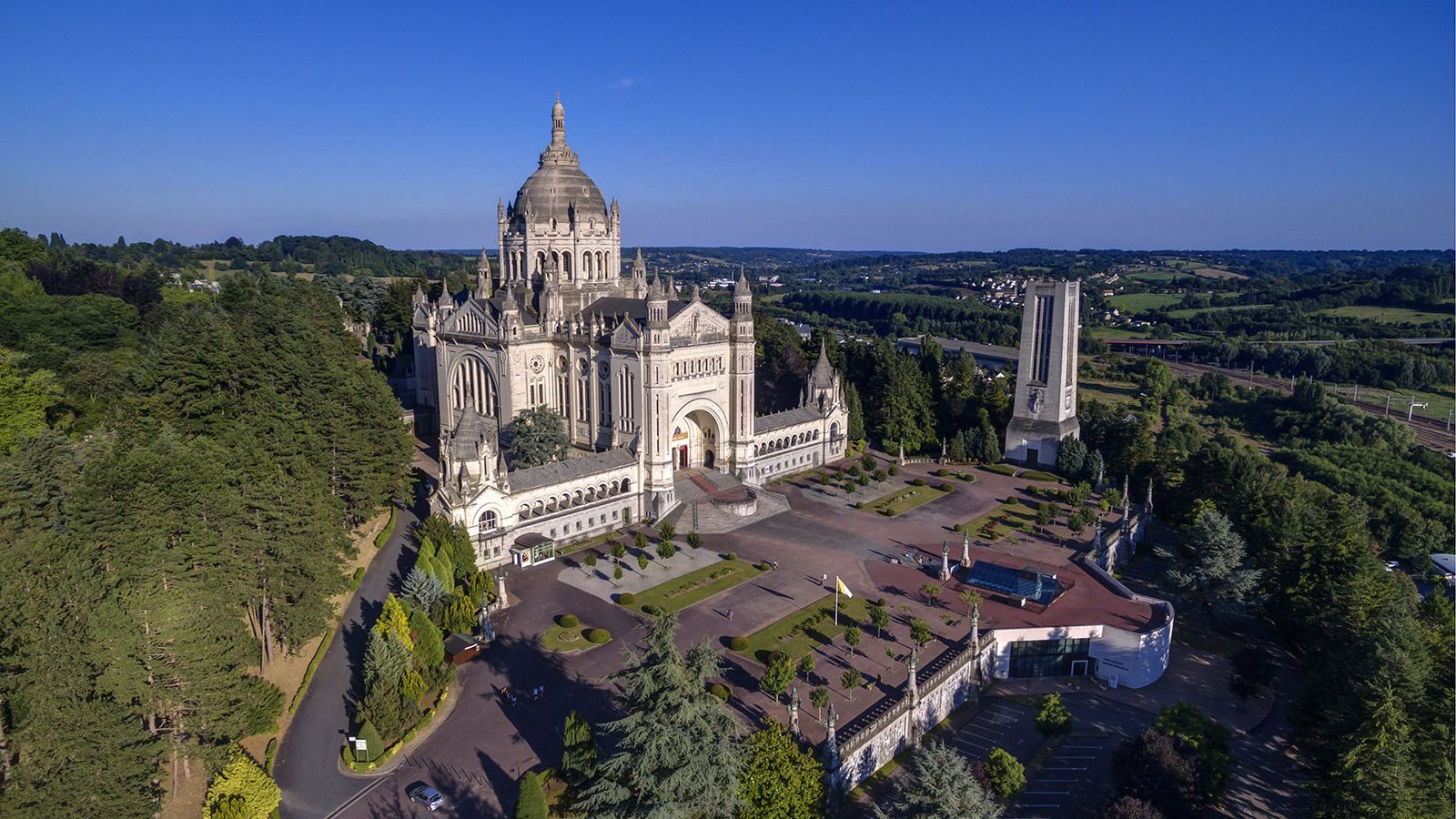
© F. Godard
Find out more
Updated on 9 June 2021
Reading time: 5 minutes
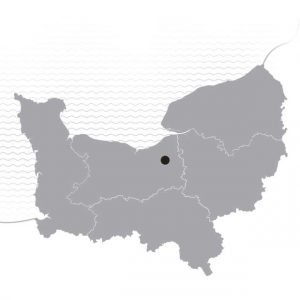
The religious city of Lisieux draws vast numbers of Catholic visitors. In fact, it is considered the second most important pilgrimage site in France, thanks to its 19th-century saint, Thérèse Martin. Thérèse’s popularity also explains Lisieux’s extravagant 20th-century hillside basilica, which outdoes its medieval cathedral and is often compared to the basilica of Sacré-Cœur de Montmartre in Paris.
A BISHOP’S PALACE
For Catholics, Lisieux is synonymous with the young Thérèse Martin , a model of 19th-century piety. However, Lisieux has a much longer history, going back to Roman times. Then, with the establishment of the duchy of Normandy in medieval times, it became the seat of a bishop’s palace , with a cathedral. The bishop-counts of Lisieux were forceful figures in Norman events. In town, the neighbourhood around the cathedral known as the Quartier Canonial has retained a number of impressive buildings once associated with the important religious administration based here, run in part by canons. Religion has long been a powerful force in Lisieux.
The Second most important pilgrimage site in france

Tragically, a major part of the historic town was destroyed in World War II bombings. However, many of the places associated with the greatest figure of 19th-century Lisieux, Thérèse Martin , survived. Born in Alençon in the south of Normandy, Thérèse moved with her family to Lisieux when she was four. Following the example of her older sisters, she became fascinated with religious life from an early age. She joined the Carmelite nunnery in Lisieux at the exceptionally tender age of 15, by special dispensation. Not just because of her exemplary pious life, but also because of her clear writings on faith, she became one of the best-loved Catholic figures of her century . She died young, having achieved a great deal. In the 1920s, she was made a saint, as Sainte-Thérèse de l’Enfant Jésus . In 1997, Pope John Paul II declared her just the 33rd Doctor of the Catholic Church because of her spiritual writings – at the time, she was the only woman to be given this exceptional title. Some 700,000 pilgrims visit Lisieux every year, making it the second most important pilgrimage site in France .
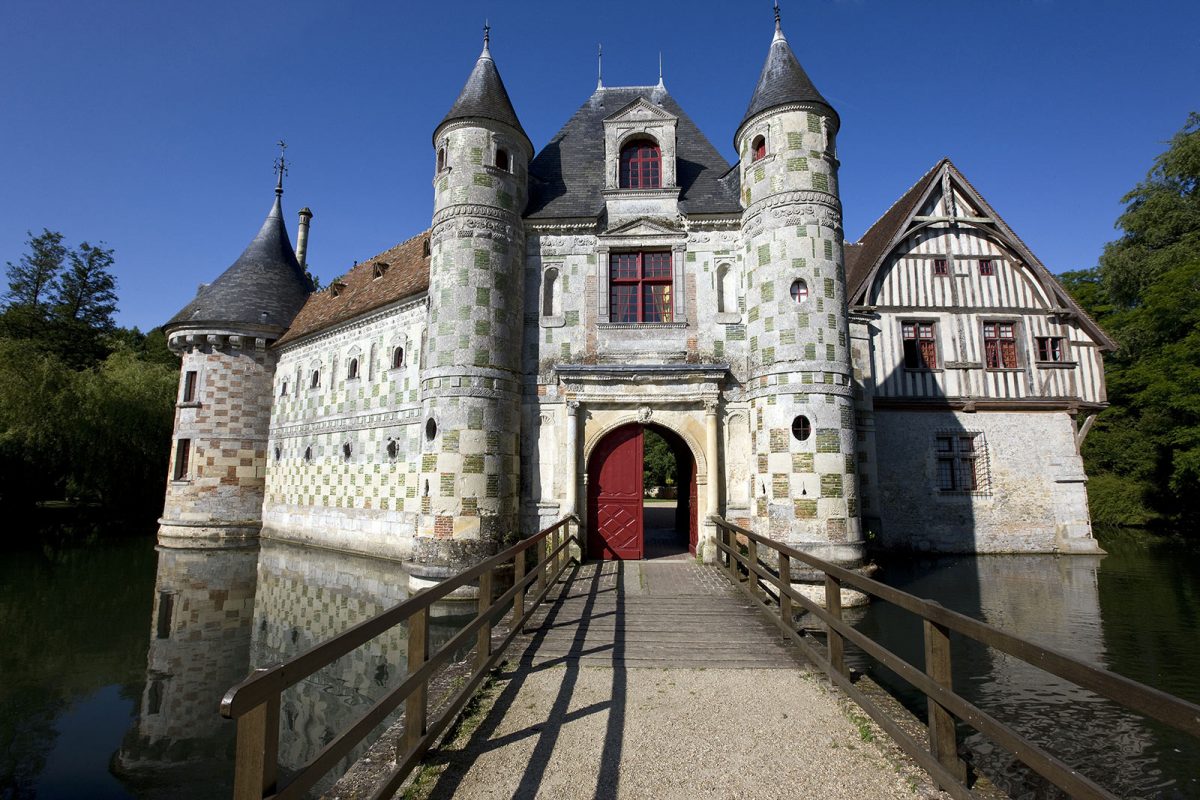
Don’t miss
Follow in the footsteps of Sainte-Thérèse . Born in Alençon on 2nd January 1873, Thérèse lived in Les Buissonnets when her mother died. This house – where she lived from the age of four to the age of 15 (the age at which she entered the convent) – holds the memories of Thérèse’s childhood. The Carmelite Chapel houses the Shrine of the Saint and the Hall of Relics contains souvenirs relating to Thérèse’s daily life. The Diorama of Sainte-Thérèse’s retraces, through a gallery of wax figures, the main stages of Therese’s life.
Basilica of Sainte-Thérèse : The largest church built in France in the 20th century, this enormous 93m-high domed edifice stands out on the hillside above Lisieux. The interiors, visited by hundreds of thousands of pilgrims every year, are dazzlingly ornate, decorated in neo-Byzantine style. An exhibition presents Sainte-Thérèse’s life and the Carmelite Order.
Just like Pope Jean-Paul II, who made a pilgrimage to Lisieux on 2 June 1980, follow in the footsteps of Sainte-Thérèse of Lisieux and of her parents Louis and Zélie Martin, canonised in 2015. The ‘In the footsteps of Saint Thérèse’ walking trail, marked on the ground with a blue line, invites you to discover the main places associated with the saint.
Cathedral of Saint-Pierre : Down in the town centre of Lisieux, this cathedral was built in the 12th and 13th centuries in early Gothic style. It holds the tomb of Bishop Cauchon, who tried Joan of Arc. Thérèse Martin went to Mass in this cathedral.
Maison des Buissonnets : This was the pretty townhouse where the Martin family moved from Alençon when Thérèse Martin was four. She lived here until she was 15 years old and entered Lisieux’s Carmelite Monastery. Walking around the rooms, you get a good idea of her early life and devotion.
Musée d’Art et d’Histoire : This art and history museum occupies one of the finest timber-framed houses left in the town centre, and displays fascinating objects reflecting the history, popular art and traditions of Lisieux and the surrounding Pays d’Auge area.
Church of Saint-Jacques : This church holds exhibitions in the summer.
Hôtel du Haut Doyenné : This fine 18th-century stone and brick building was the former residence of the Haut Doyen, the second most important religious figure in Lisieux after the bishop.
Château de Saint-Germain-de-Livet : just south of Lisieux, this chateau, known as the ‘wonder of the Pays d’Auge’, is now owned by the town of Lisieux. Situated at the bottom of a valley, it is a 16th-century architectural gem, with its coloured, patterned stones and green-varnished bricks. The interiors are embellished with 16th-century frescoes and 18th- and 19th-century furniture. Numerous drawings and paintings are on show from the Riesener Collection, one of whose representatives was a cousin of Delacroix.
Cerza Safari Park (in Hermival-les-Vaux): This safari park is home to 500 wild animals across an area of 123 acres. A safari train takes visitors on tours, and at certain times of the year, visitors can even reserve one of the safari lodges and stay the night in the park!
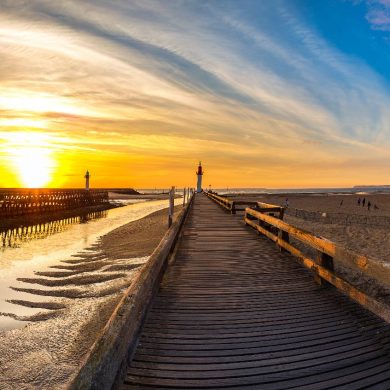
Trouville-sur-Mer

The Normandy Cider Route
Updated on 18 December 2020
Useful information
Authentic Normandy Tourist Office (Lisieux and the Pays d’Auge) authenticnormandy.fr
Plan your trip to Lisieux

Restaurants in Lisieux

Sports and leisure activities in Lisieux
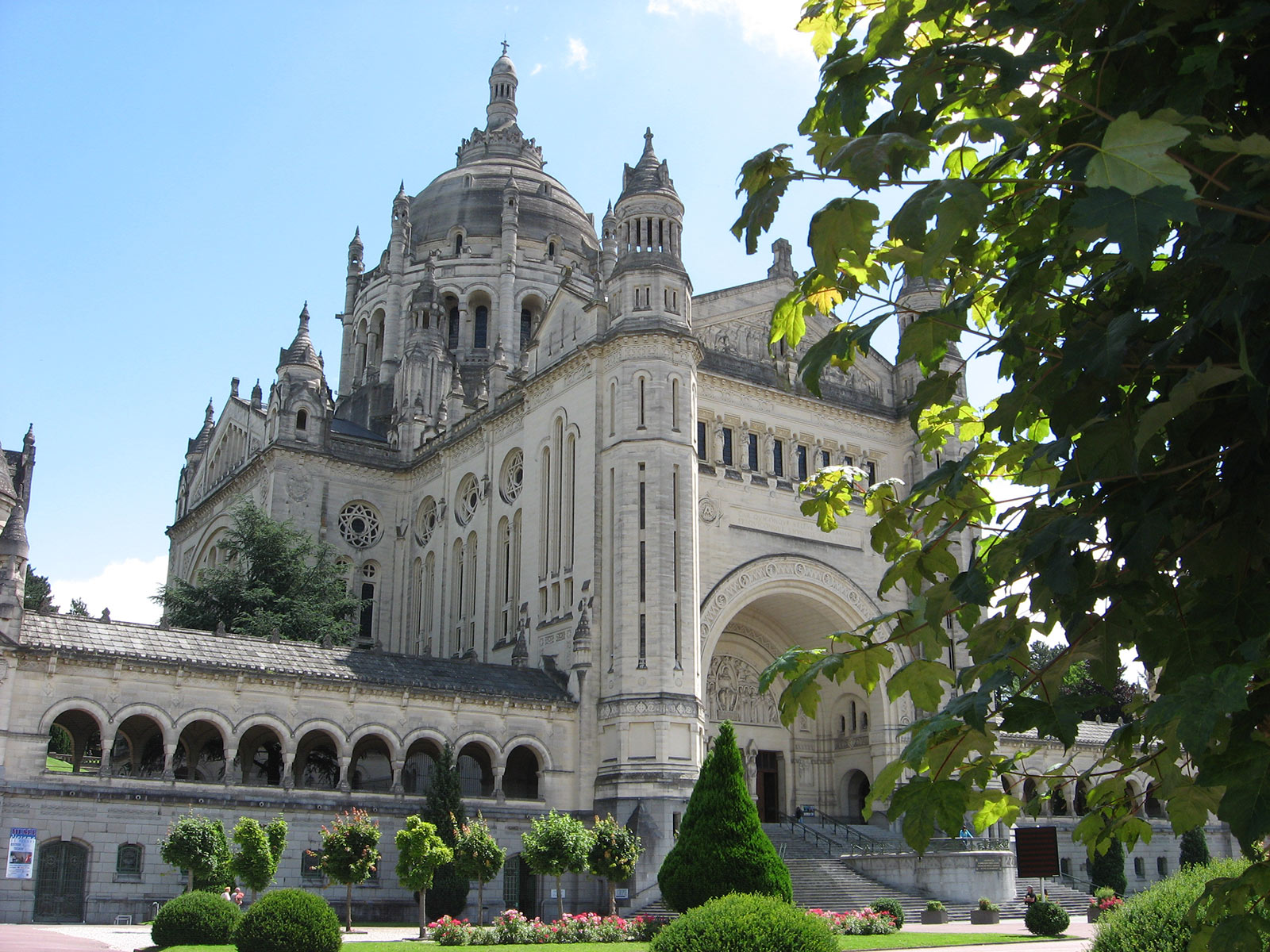
Places to visit in Lisieux
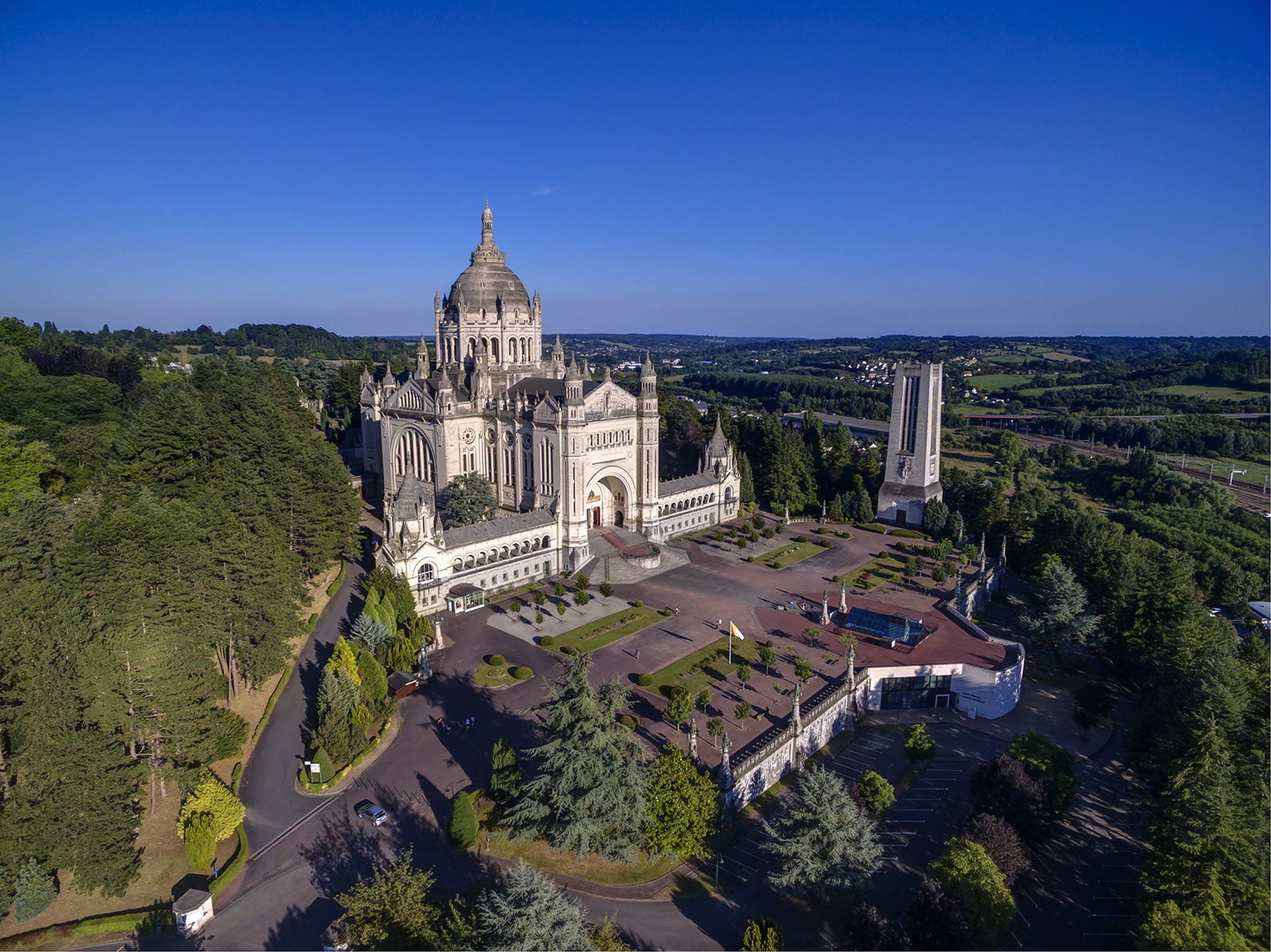
Hotels in Lisieux
Return to top
Are you already in Normandy?
Plan what to see and do while you’re here by visiting normandy-secrets.com, which lets you in on all of the local secrets and hidden gems in the immediate vicinity!
Close search box

***Some of the links below are affiliate links, meaning that at no additional cost to you, I will receive a commission if you click through and make a purchase.***
France Pilgrimage – Top Sites For The Catholic Pilgrimage To France
Table of Contents:
Nearly 50% of French claim to be Catholic. Even though the secularization of society is progressing every year, there are many amazing France pilgrimage sites that have been built in the previous centuries.
Pilgrims travel to France to pray in the churches, to heal in the miraculous water of Lourdes and to start the famous Camino de Santiago route.
One of the most important sacral buildings in the country, the Notre Dame cathedral has been partially destroyed because of the fire in April 2019. It’s currently closed for visitors. Hopefully, it will be open again in 2024.
Here’s a map of France pilgrimage sites that you can find in this post:
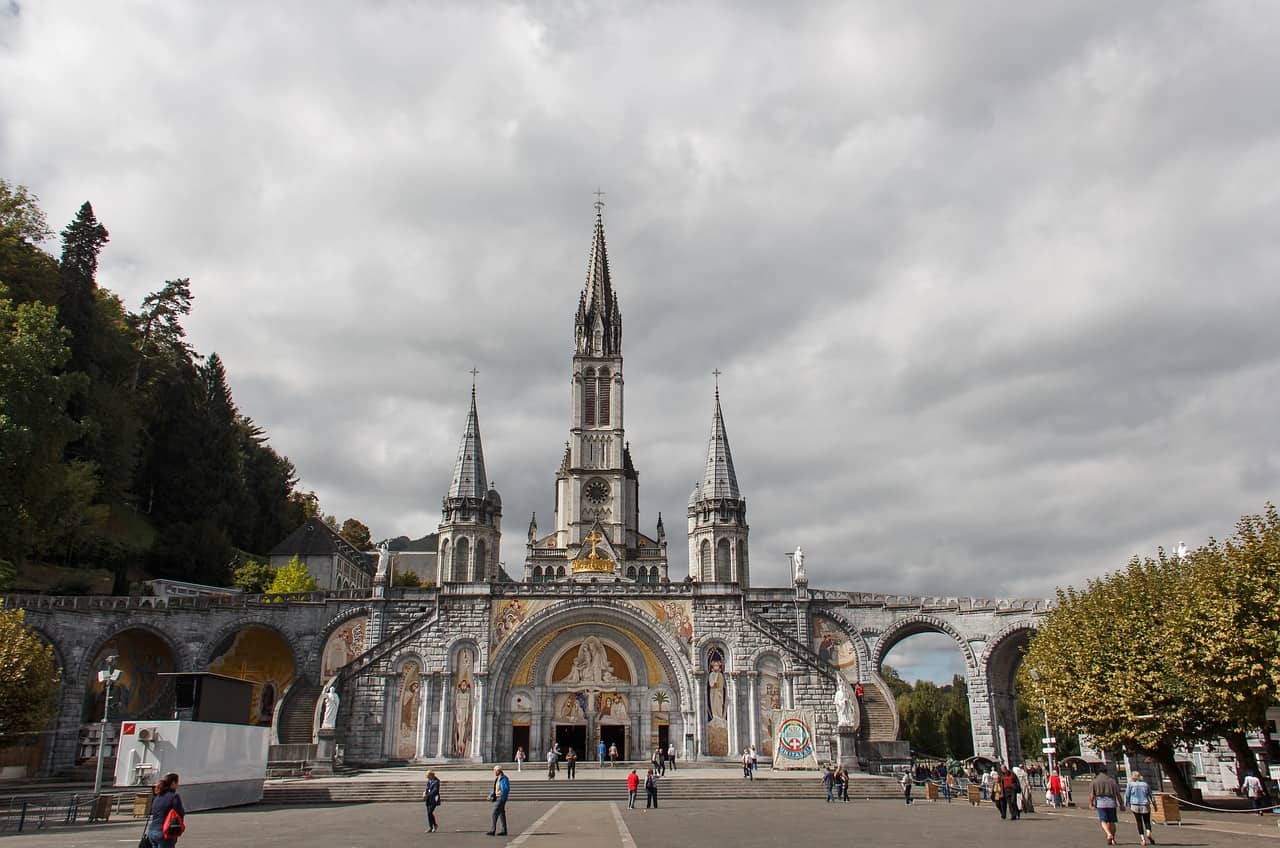
Let’s start with one of the most important sites for Catholics not only in France but in the world in general.
In the 19th century, just 4 years after the doctrine of immaculate conception was defined by Pope Pius IX, a peasant girl Bernadette Soubirous saw Virgin Mary who confirmed she had no original sin.
She asked Bernadette to tell people about the miraculous spring in the Massabielle grotto. Since that time, over 7,000 people claimed to be healed after washing or drinking this water.
Chartres Cathedral

Located 50 miles southwest of Paris, the Chartres Cathedral, also known as Cathedrale Notre-Dame de Chartres/Cathedral of our Lady in Chartres, is also another pilgrimage site in France that you should visit. It was built and inspired by Gothic architecture.
Inside the cathedral, you can see dramatic columns standing tall towards the high arches of its ceiling, and medieval stained glass windows giving its interior a splash of color while showing Christ’s life. The cathedral’s exterior is also as breathtaking as its insides where you can see statues depicting various scenes from the Old Testament and the North Testament.
Aside from its structure, another reason why Chartres Cathedral is one of the best pilgrimage sites in France is because of Sancta Camisa, the sacred tunic, that you can find here. The Sancta Camisa or Veil of the Virgin which was a gift from Charles the Bald in 876 served as the cathedral’s relic which captured the attention of a lot of Marian devotees around the world.
Since the Middle Ages, a lot of Marian pilgrimage is held in Chartres Cathedral because many believed that the veil was used by the Virgin Mary when she gave birth to Christ in Jerusalem.
If you want to visit this cathedral, Chartres is a city in North-Central France which is linked to Paris by the regional line of trains. The approximate travel time from Paris to Chartres is 1 hour and 15 minutes.
Once you arrive in Chartres, take the exit to Place Pierre Semard which will lead you to the cathedral. After paying a visit, you can also explore the Loire Valley
St. Jean Pied de Port
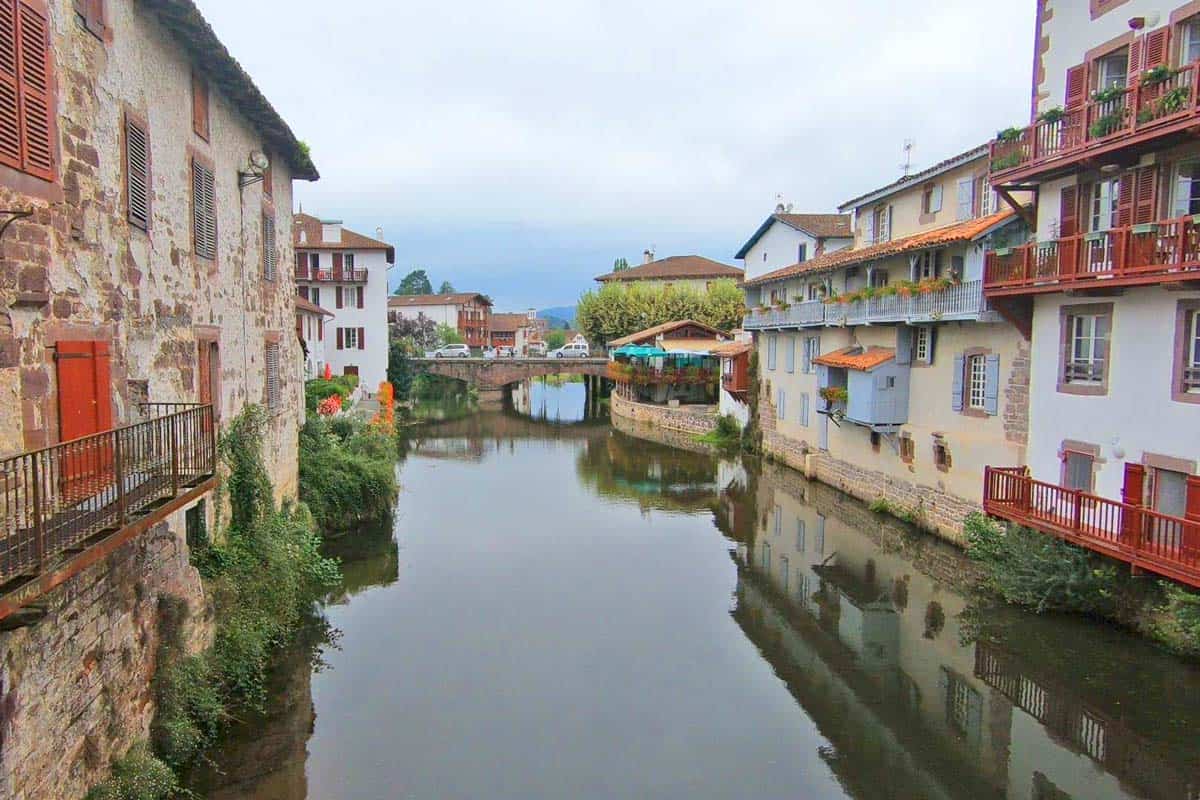
St.Jean Pied de Port is a small town in the Pyrenees on the border with Spain . It’s been an important place of European pilgrimage for many centuries.
Pilgrims coming from France, Germany , the Netherlands, and other European countries walk through the town on their way to Santiago. The main reason St.Jean Pied de Port became an important pilgrimage place is its proximity to the Roncesvalles Pass. The pass has been used for centuries to cross the Pyrenees.
For many pilgrims, St.Jean is the starting point of the Camino Frances , one of the most popular pilgrimage routes to Santiago de Compostela. Thousands of people arrive here every year to start a 700km journey across Northern Spain to the tomb of Apostle St. James.
Everything in the town is about the Camino de Santiago, the pilgrimage spirit is everywhere from the information office to restaurants and souvenir shops. Traditionally before starting the long journey to Santiago de Compostela pilgrims attend the Pilgrim’s Mass at a small Gothic church Notre-Dame-du-Bout-du-Pont.
The town is located in the picturesque valley surrounded by mountains and emerald-green fields. It’s an interesting place to visit even for those who aren’t planning to go on a pilgrimage.
The first walking day on the Camino over the Pyrenees from St.Jean Pied de Port to Roncesvalles is a real challenge. It’s considered to be the toughest day on the route due to the very long and steep ascent, 1400m up. Many pilgrims prefer to walk it over two days.
There are two ways of getting to St.James from Barcelona and from Paris. From Barcelona take a bus to Pamplona and from there another bus to St.Jean. From Paris take a train to Bayonne and from there another train to St.Jean Pied de Port. You can book your journey on Omio.
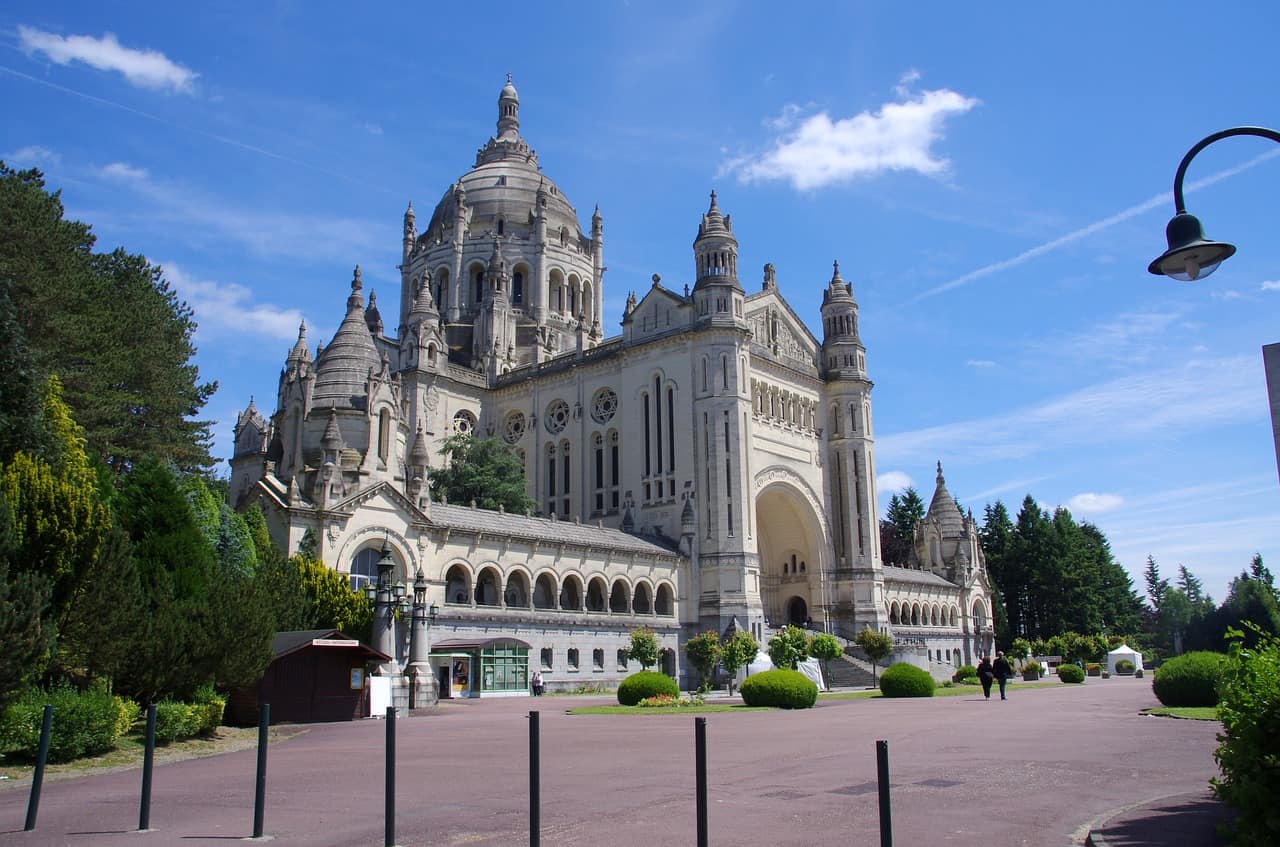
The second most important France pilgrimage site, after Lourdes, Lisieux is where The Little Flower of Jesus (Thérèse of Lisieux) has been living.
She was famous for being straightforward and explaining the complicated truths of faith in a very simple, even childish way. Even though she died at the age of 24, with little education, she has become a doctor of the church .
The pilgrims from all over the world travel to Lisieux to pray to The Little Flower’s relics in the Basilica of St. Thérèse in Lisieux.
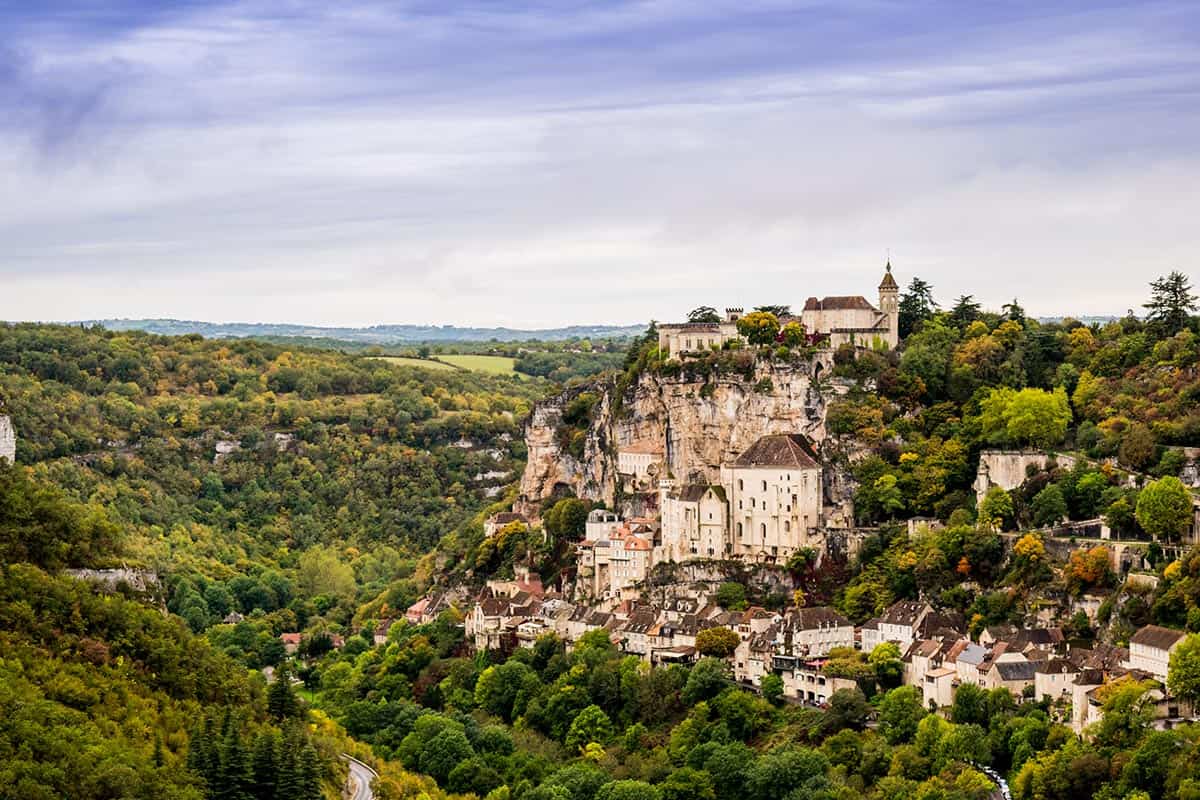
Mont Sainte-Odile

Nestled high in the hills of the Vosges mountains in the Alsace region of France is Mont Sainte-Odile.
It’s a beautiful but solitary place sounded by tall trees and dark forests forest of the region. Set in an awe-inspiring location, perched on a sheer cliff face. Just the sort of place for a saint to be buried. Odile was blind but regained her eyesight after Saint Erhard of Regensburg baptized her, thus bringing her eyesight back.
Her father tried to marry her off and Odile escaped into the mountains being chased by her father. A cliff face opened up to protect her and her father then agreed to build her monastery in this position.
The Monastery was originally built sometime in the early 7th century, but has been destroyed and rebuilt many times over the years. Visit the tomb of St Odile, the Chapel of Tears, and the Chapel of Angels. A
walk along the cliff face provides inspiring views looking north towards Strasbourg and south towards Colmar. Today there is a Church, chapels, hotels, cafe and gift shop. Mont Sainte Odile is one of the most beautiful spots in all of the Alsace to visit.
Basilica of the Sacré-Cœur, Montmartre
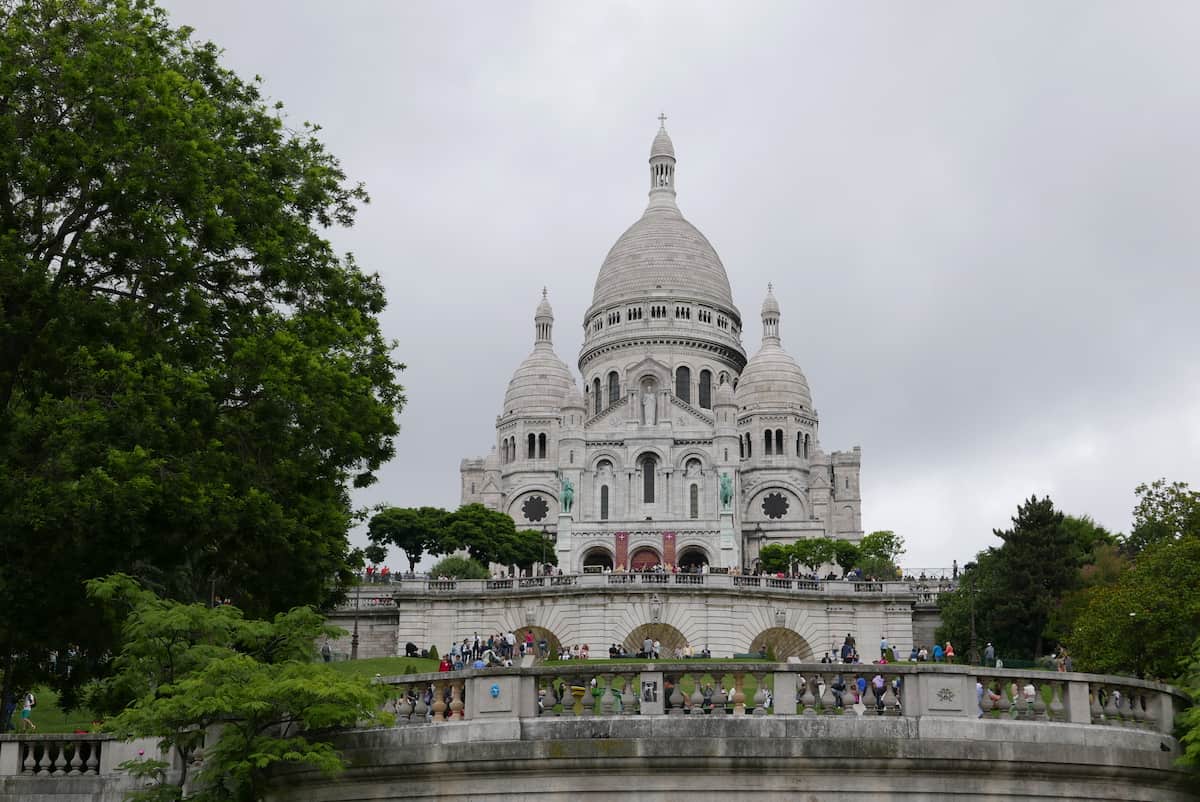
Talk about pilgrimage, there are two places in Paris that first come to mind – Notre-dame (of course), and the other one, is the Basilica of the Sacré-Cœur in Montmartre.
“Mont”, in French, means a mountain. The Basilica of the Sacré-Cœur is a white cathedral stand stop of that mountain and its iconic architectural silhouette could be seen from a lot of places in the city from different angles.
Compared with a lot of historic heritage sites in Paris, the basilica is actually very new. It is a Roman Catholic church that inaugurated as a political and cultural monument of the adoration of the Holy Eucharist. The site was officially completed in 1914, 25 years after the completion of the Eiffel Tower.
With only 130 meters in height, Montmartre is fairly accessible to worldwide tourists; it’s a great place to kick start your pilgrimage in France.
Appreciate the grand interior, pipe organ, bells, and more; but don’t miss out on taking a short walk up the staircase, or riding the funicular, to reach the open space right in front of the Cathedral.
It is one of the best viewpoints in Paris due to the direction of where the church is facing. You will have a panoramic view of the Eiffel Tower to Notre Dame and beyond.
Vèzelay Abbey
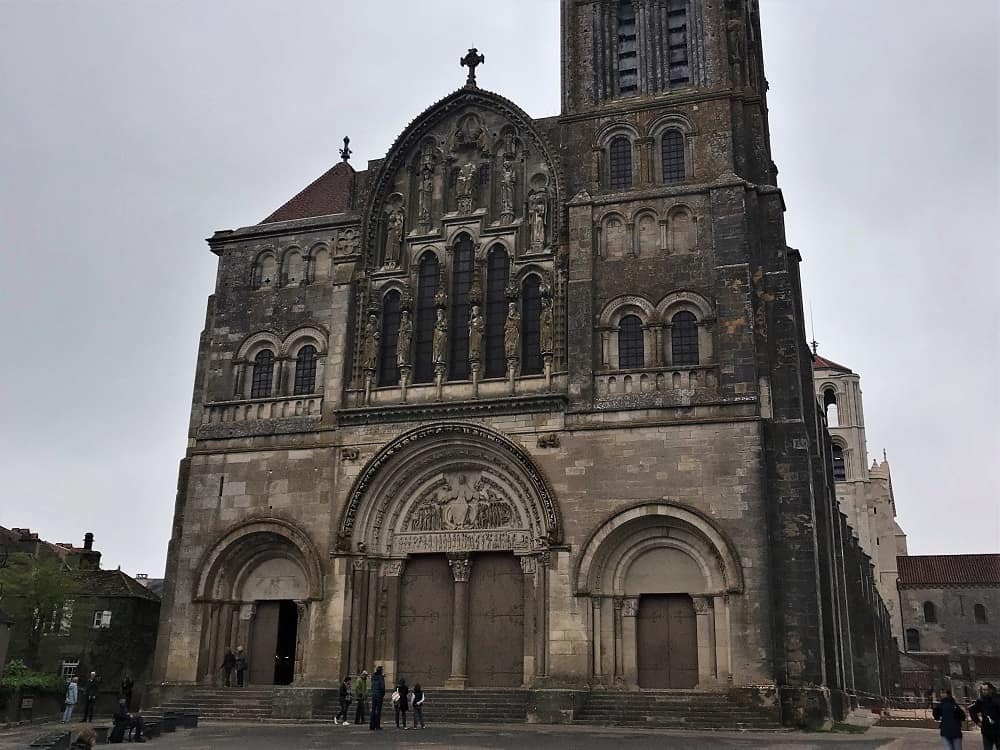
Are you looking for an authentic French village on your way to Santiago de Compostela? Conques will be the perfect stop!
Located on the Camino de Compostela that goes from Le Puy en Velay to Santiago, Conques is one of the cutest villages you will get to see in France.
This medieval village has loads to offer, but the most famous attraction is the Abbey Church of Sainte-Foy. This beautiful example of romanesque architecture is mainly known for being home to the relics of Saint Faith (Sainte Foy). The relics were brought to Conques in 883. Since then, it became one of the main stops for pilgrims in France.
Inside the abbey, you can see the treasures with the statue of Sainte-Foy and many medieval goldsmiths. Outside, you can admire the tympanum. The doorway carvings are absolutely beautiful and will blow your mind! The Abbey was added to the UNESCO World Heritage Sites in 1998.
Conques is a very cute and authentic place, you will love wandering the streets and discovering the local shops and bakeries. Don’t hesitate to go for a meal in one of the local restaurants. You will get a chance to discover the “cuisine du terroir” and typical dishes from southwest France . Duck confit, cassoulet, foie gras… a real treat for food lovers!
Pin For Later:

Read also our other posts:
- Best pilgrimage sites in Italy
- Best pilgrimage sites in Mexico
- Tips for planning a pilgrimage to Fatima
Did you enjoy reading this post about France pilgrimage sites? Share your thoughts in the comments!
One Response
Loved reading the post! So many religious sites here that are worth exploring.
Leave a Reply Cancel reply
Your email address will not be published. Required fields are marked *

We are Karolina, Patryk, and Mia, the lazy traveling family. After spending 5 years as digital nomads, and living in many countries in the world, we decided to make Poland our base.
Our mission is to show you safe and interesting destinations where you can travel with your family.
Join our Facebook Group
Join the Poland Travel Support Group , a group to help you plan your trip to Poland!
Subscribe and Get Updates

- Travel Blog Cooperation
- Destinations
- Privacy Policy
- Affiliate Disclosure
- Terms of Service
- Powered By:
- www.HotelMarketingBlackBook.com -
- Hotel Marketing Agency

- Foodies Tours for Catholic Pilgrims
- Holy Land Pilgrimages & Israel Tours 2024
- Italy & Rome Pilgrimage 2024 or 2025
- Europe Pilgrimage
- Marian Pilgrimages to Marian Shrines 2024
- Fatima Pilgrimage 2024
- Greece Pilgrimage in the Footsteps of St Paul
- France Pilgrimages 2024
- Medjugorje Pilgrimages 2024
- Mexico Pilgrimage to Our Lady of Guadalupe
- Pilgrimages to Spain
- Pilgrimage to Poland – Divine Mercy Pilgrimage 2024
- Asia Pilgrimage Tours
- South America Pilgrimage Tours
- Holy Land Pilgrimage 2024 with Bethlehem Stay
- Holy Land Pilgrimage with Jordan and Petra Tour – 12 day
- Holy Land & Jerusalem Pilgrimage Tour
- Holy Land Pilgrimages to Israel featuring Foodies Tours
- Pilgrimage to Our Lady of Guadalupe – Mexico City Food Tour
- Peru Food and Faith Pilgrimage Tour – Lima, Cusco & Machu Picchu
- Fatima Portugal Pilgrimage – Food, Faith & Wine Tour of Spain and Portugal
- Spain Food & Faith Pilgrimage Tour – Madrid, Pamplona, Barcelona, Avila
- Italy Food and Wine Tour – Pilgrimage to Rome, Assisi, Siena, Florence
- Greece Food Faith & Wine Pilgrimage Tour with 3 Day Greek Isle Cruise
- New Orleans Food and Faith Pilgrimage Tour – Spirits, Saints, and Shrines
- Our Lady of Guadalupe Pilgrimage Tour
- Medjugorje Pilgrimage 2024
- Medjugorje Pilgrimage 2024 & Rome Pilgrimage Tour
- Lourdes Pilgrimage 2024
- Fatima Lourdes Pilgrimage 2024
- Fatima Lourdes Rome Pilgrimage 2024
Divine Mercy Pilgrimage to Poland
- Italy Pilgrimage to Rome – Great Shrines of Italy 2024
- Pilgrimage to Greece in the Footsteps of Paul Tour 2024
France Pilgrimage – Best Shrines of France
- St Ignatius Pilgrimage visiting Ignatian Pilgrimage Sites 2024
- Holy Name Pilgrimage to Italy 2024
Vietnam Pilgrimage to Our Lady of LaVang
- Catholic Cruises
- Pilgrimage to Rome, San Giovanni, Assisi and Bagnoregio with Fr. Leon Oct 2024
- Holy Land and Jordan with Petra Fr. David Ducote November 2024
- Divine Mercy Poland Pilgrimage Tour Hotels
- Holy Land & Jerusalem Pilgrimage Tour Hotel Accommodations
- Holy Land with Bethlehem Stay Pilgrimage Hotels
- Holy Land and Jordan with Petra Pilgrimage Hotels
- Fatima Lourdes Pilgrimage Tour Hotels
- Footsteps of St. Paul Hotel and Accomodations in Greece
- Guadalupe Pilgrimage Hotels
- Great Shrines of Italy Pilgrimage Hotels
- Medjugorje Pilgrimage Tour Hotels and Accommodations with Marija
- Mexico Food and Faith Pilgrimage Hotels
- Very Best Shrines of France Pilgrimage Tour Hotels
- Hotels for Food and Faith Pilgrimage Tours in Spain and Portugal
- Peru Food and Faith Pilgrimage Hotels
- Vietnam Pilgrimage Hotels
- Holy Land Food and Faith Pilgrimage Hotels
- Fatima Lourdes Rome Pilgrimage Hotels
- Holy Name Pilgrimage to Italy Hotels
- Travel Checklist for Pilgrimage Tours
- Plan Your Own Pilgrimage Group & Travel Free!
- Hot Deals for Pilgrimage Tours – on Sale
- Airports we serve — add on fares for a few airports
- Travel Insurance Information
- Walking – Easy
- Walking – Moderate
- Walking – Moderate+ to Considerable
- Walking – Strenuous
- Our Lady of Lourdes Story, Apparitions, Pilgrimage Facts
- Divine Mercy Shrine Poland – St Faustina & JP II
- Medjugorje story – 5 Stones, Fr. Jozo, Apparitions
- Why Are Pilgrimages Important?
- Gift Certificates for Tours and Pilgrimages
- Terms and Conditions for Participation
- The Importance of a Holy Land Pilgrimage
Pilgrimage to France and Lourdes, Paris, & Mont St. Michel
France Pilgrimage – Best Shrines of France Tour visits some of the most important shrines, churches, basilicas, and religious monuments in France. Beginning in Lourdes, the great shrine known worldwide as a place for physical and spiritual healing, this France Pilgrimage allows ample time to pray at the Grotto where Our Lady appeared to St. Bernadette under the title of “the Immaculate Conception” in 1858 and to bathe in the Miraculous Water. We will visit the Boly Mill and the Cachot, the prison where Bernadette’s family once lived, and we may participate in the nightly Candlelight Processions. In Toulouse, we will visit the Eglise des Jacobins where St. Thomas Aquinas is buried, before continuing on to the clifftop shrine of Rocamadour, home of an early Christian hermit named, Zaccheus, the “tax collector” of Jericho, who had come to the land known as Gaul with St. Veronica and St. Mary Magdalen to spread the good news. Here we will have Mass and visit the Shrine of Our Lady of Rocamadour containing the miraculous statue of the Virgin Mary and the tomb of St. Zaccheus. In Paray-le-Monial, we will visit the Chapel of the Visitation where Jesus exposed His Sacred Heart to St. Margaret Mary Alacoque. In Nevers, we will visit the convent where St. Bernadette lived until her death in 1879, and see her incorrupt body, which is miraculously preserved. As you make your pilgrimage to France you will visit le Mont St. Michel which is built on the site where St. Michael the Archangel appeared three times. Originally founded as a sanctuary and consecrated in 709, it is now classified as a World Heritage Site by UNESCO , and it is said to be the most photographed monument in all of France. It is in Lisieux that the Very Best Shrines of France Pilgrimage Tour will visit the Shrine dedicated to St. Saint Therese of the Child Jesus and the Holy Face. Often referred to as “the Little Flower,” it was St. Therese who showed us the way to become a saint was to “do small things with great love.” We will visit the Basilica dedicated to the Saint whom Pope Pius X called “the greatest saint of modern times.” We will visit “the Carmel,” the Convent where she lived, “Les Buissonets,” her family home, and the Ancient Cathedral of St. Peter. In Paris, we will celebrate Mass at the Shrine of the Miraculous Medal where the incorrupt body of St. Catherine Laboure and the incorrupt heart of St. Vincent de Paul are located. We will also visit the Chapel of St. Vincent de Paul nearby which houses a magnificent reliquary with his remains. It was here her guardian angel led her to the chapel where the Blessed Virgin revealed the miraculous medal and the green scapular to her. The France Pilgrimage Tour would not be complete without a panoramic sightseeing tour of the City of Lights to see the Notre Dame Cathedral , the Eiffel Tower , L’Arc de Triomphe, and Champs Elysees. Why don’t you make your Pilgrimage to France by booking a France Pilgrimage – Best Shrines of France for 2024 or 2025 today?
Tour Details France Pilgrimage - Best Shrines of France
Departure & return location.
Your local airport of choice — Or you can choose land only and make your own flight arrangements.
Departure Time
Arrive for Check-in 3 Hours Before Flight Time
Price Includes
- Air fares - Round trip airfare listed below Airfare is included for most major airports
- 1 Checked Bag with the Airlines
- Hotel Accommodations - First Class Hotels with Porterage
- Meals - Breakfast and Dinner Daily Wine & bottled water with dinners
- All transportation in destination location
- Tour Guide - Professional English Speaking Catholic Guides
- Entrance Fees - Sightseeing and admissions fees as per itinerary Whisper Headsets where needed
- Priest with Daily Mass and Spiritual Activities Coordinated
Price Excludes
- Travel Insurance - optional but recommended
- Gratuities for Guides and Drivers
- Baggage Fees, if applicable
- Fees for Seat Assignments or upgrades, if applicable
- Private airport transfers when selecting Land Only and arranging your own flights
- Any Personal Expenses
Complementaries
- Name and Luggage tags
- Neck Wallet
Itinerary for France Pilgrimage - Best Shrines of France
Day 1 depart home.
Begin your pilgrimage to France by departing home for your overnight flight to Europe. Dinner and breakfast will be served on board.
Day 2 Arrive Lourdes
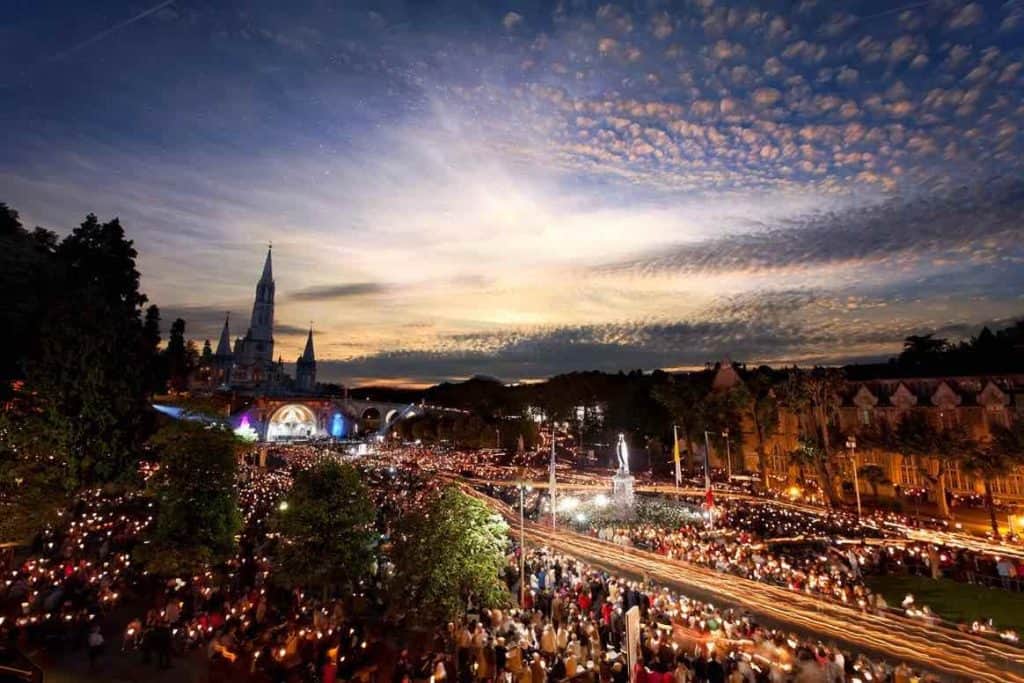
Day 3 & 4 Lourdes
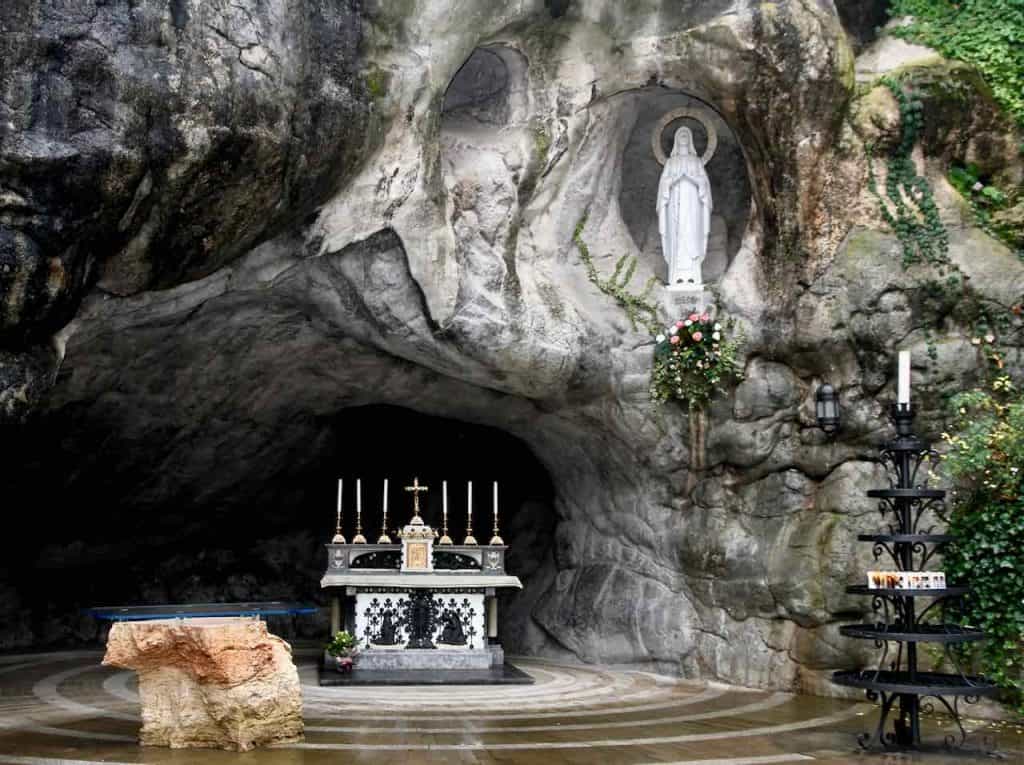
There is a daily schedule of activities at the Shrine of Lourdes in which you are welcome to participate. You can get the schedule at the Sanctuary and/ or on this website.
Day 5 Lourdes – Toulouse Basilica of St. Sernin - Eglise & Couvent des Jacobins - Shrine of Our Lady of Rocamadour
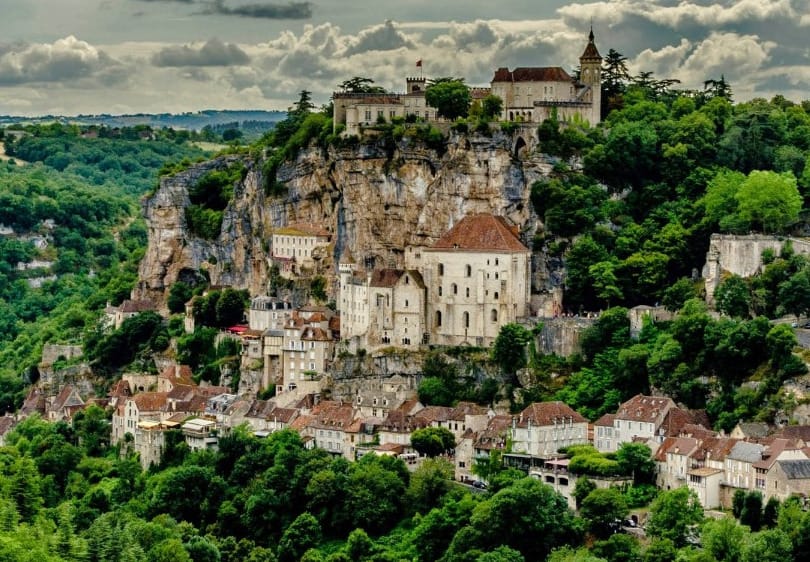
Day 6 Rocamadour – Paray Le Monial
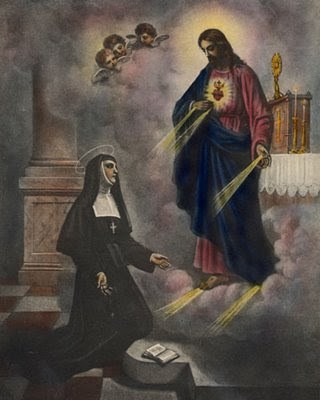
Day 7 Paray Le Monial – Nevers - St. Berndette's incorrupt body
After an early breakfast, we will depart for Nevers by way of the picturesque Loire Valley. After taking the veil in 1867, St. Bernadette lived for 12 years as a member of the Congregation of the Sisters of Nevers. At least three times during her short lifetime, she received the last Sacraments. In addition to asthma, she was gradually struck by other illnesses, among them was tuberculosis of the lung and a tubercular tumor in her right knee. St. Bernadette eventually died at the age of 35. See St. Bernadette’s incorrupt body at the convent of St. Gildard , miraculously preserved since her death in 1879. Dinner and overnight in Nevers.
Day 8 Le Mont Saint Michel Abbey
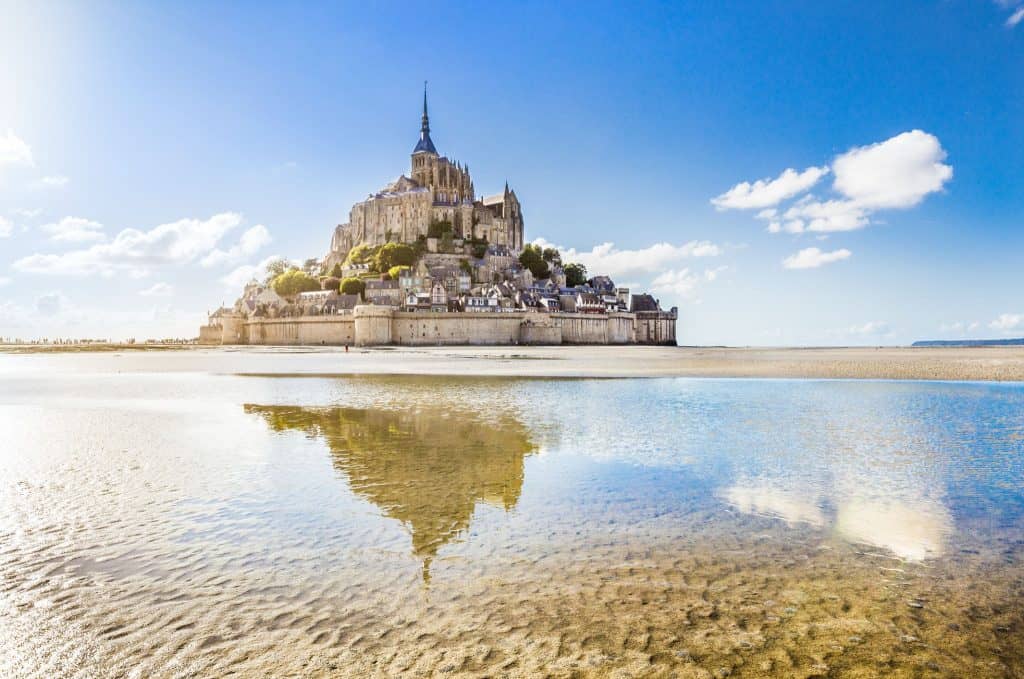
After an early breakfast, we will travel to Mont St. Michel . Upon arrival, we will spend the day touring Le Mont Saint Michel and the different stages of its construction that have now classified it as a World Heritage Site by UNESCO in 1979. It was here, Aubert, Bishop of d’Avranches, founded a sanctuary on Mont-Tombe, after 3 successive appearances by the Archangel Michael. Consecrated in 709, the church has attracted both the curious, and pilgrims from all over the world ever since.
After having been made into a prison from the time of the French Revolution up until the time of the Second Empire, the Abbey became the responsibility of the Historical Monuments Department in 1874. Since 1969 the Abbey has been home to a monastic community, ensuring the continuation of a spiritual presence. Rightly called “The Wonder of the Western World”, the Mont-Saint-Michel is surrounded by a magnificent bay, which is the theatre of the greatest tidal ranges in Europe, a wonderful view on its own. Dinner and overnight near Mont-Saint-Michel.
Day 9 Therese of Lisieux - Paris
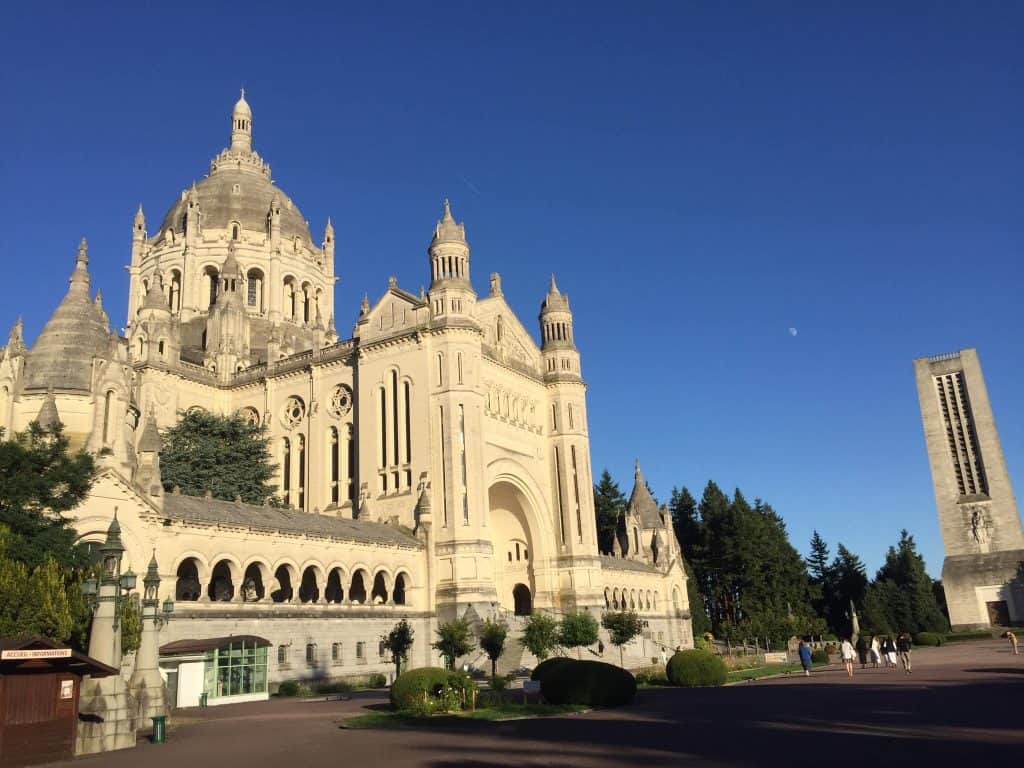
Day 10 Paris - Miraculous Medal and St. Catherine - St. Vincent de Paul - Sainte-Chapelle - Notre Dame Cathedral - Basilica of the Sacred Heart
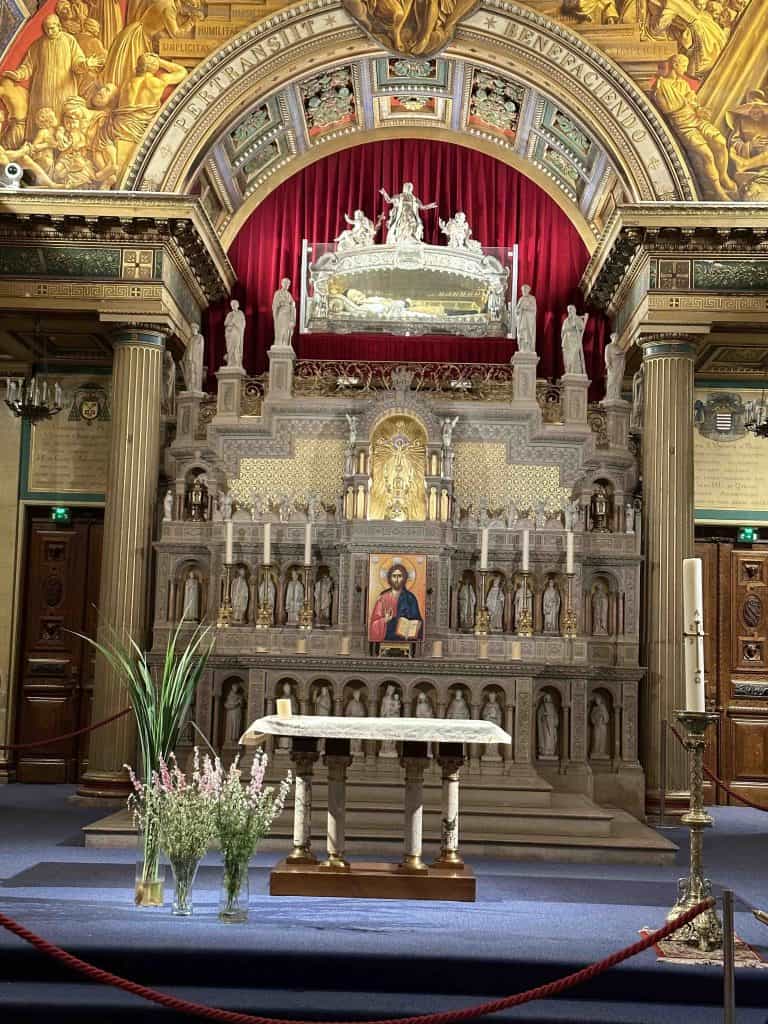
After an early breakfast, we depart for our tour of Paris. We will begin with holy Mass at the Shrine of the Miraculous Medal. View the incorrupt body of St. Catherine Laboure whose guardian angel led her to the chapel where the Blessed Virgin displayed a vision of the miraculous medal and later the green scapular. The Virgin promised bountiful graces for all who wore these. You can receive a plenary indulgence. Nearby is the chapel of St. Vincent de Paul where we will have the opportunity to pray before his relics encased in a glass coffin above the altar. Enjoy a panoramic sightseeing tour where you will see such monuments as the Notre Dame Cathedral (from the outside), the Basilica of the Sacred Heart, the Eiffel Tower, the L’Arc de Triomphe, and the Champs Elysees. Enjoy other sights on this mostly panoramic tour.
Day 11 Paris

This morning we will begin with Mass, followed by a free day to explore the neighborhoods, sights, and cafes of Paris.
We will enjoy a lovely dinner before returning to our hotel for a restful overnight.
Day 12 Paris - Home
After an early breakfast in the hotel, we transfer to Charles de Gaulle Paris Airport for our return flight home.
Map of France Pilgrimage - Best Shrines of France Tour
Photos of France Pilgrimage - Best Shrines of France Tour
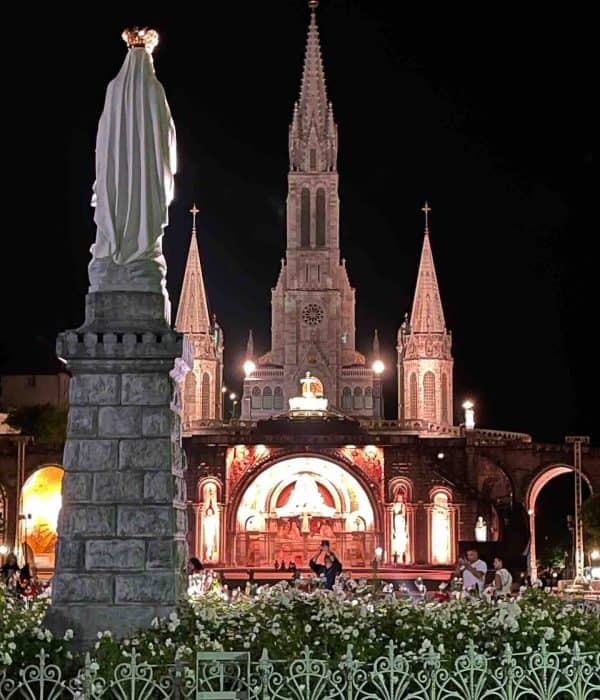
Dates, Pricing, and Booking - France Pilgrimage - Best Shrines of France Tour
Travel insurance - france pilgrimage - best shrines of france tour.
Travel Insurance is available for Pilgrimage to France and – is recommended!
Click here for information on insurance plans!

FAQ - France Pilgrimage - Best Shrines of France Tour
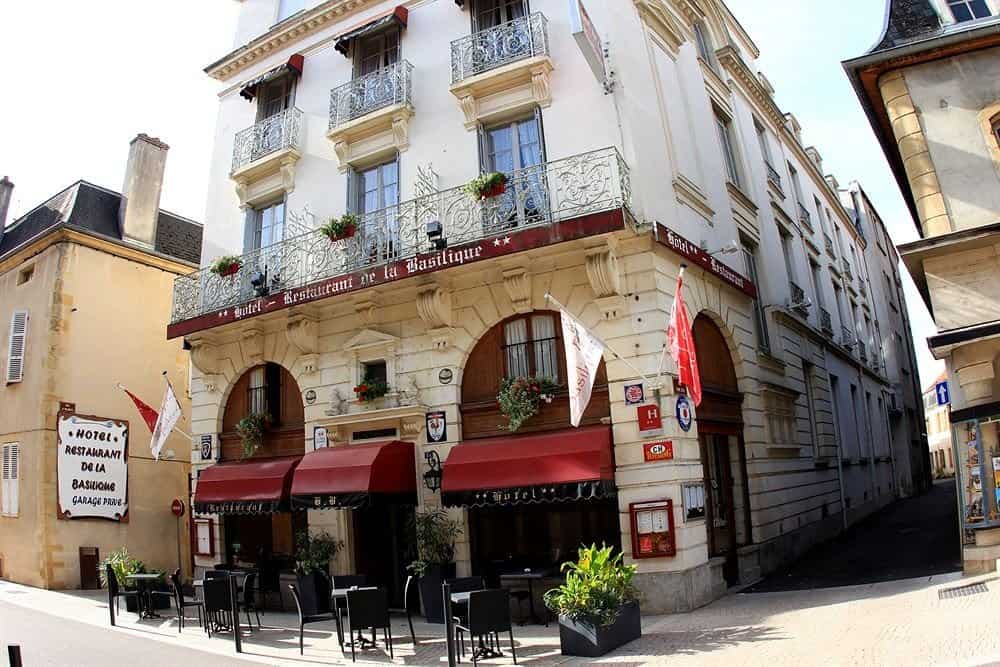
Click here for information on hotel accommodations for Pilgrimage to France.
How do I meet up with the group if I make my own flight arrangements?
Arrival times vary between dates and within pilgrimages. If you make your own flight arrangements, we can arrange a private airport transfer in Paris for $103 per person. A private transfer from Lourdes to Toulouse is $269 per person. We recommend using our transfer service because they are known and trusted drivers. As soon as you have your flight information, email Marcelle .
Will I need an electrical adapter? Yes, you will need an adapter for France.
Do I need to tip on this Pilgrimage to France? If so, how do I do this, and how much? Yes, tipping is important!
Would you like to lead your parish or group on a Pilgrimage to France? Click Here to get started.
Do you have FAQs for airlines, passports, vaccinations, travel insurance, tipping, packing, mobility, and others? Yes. FAQ for all Catholic Journeys Pilgrimage Tours
What does Mont St. Michel, one of Europe’s major pilgrimage destinations and a holy island now a UNESCO World Heritage Site, look like?
Related Tours
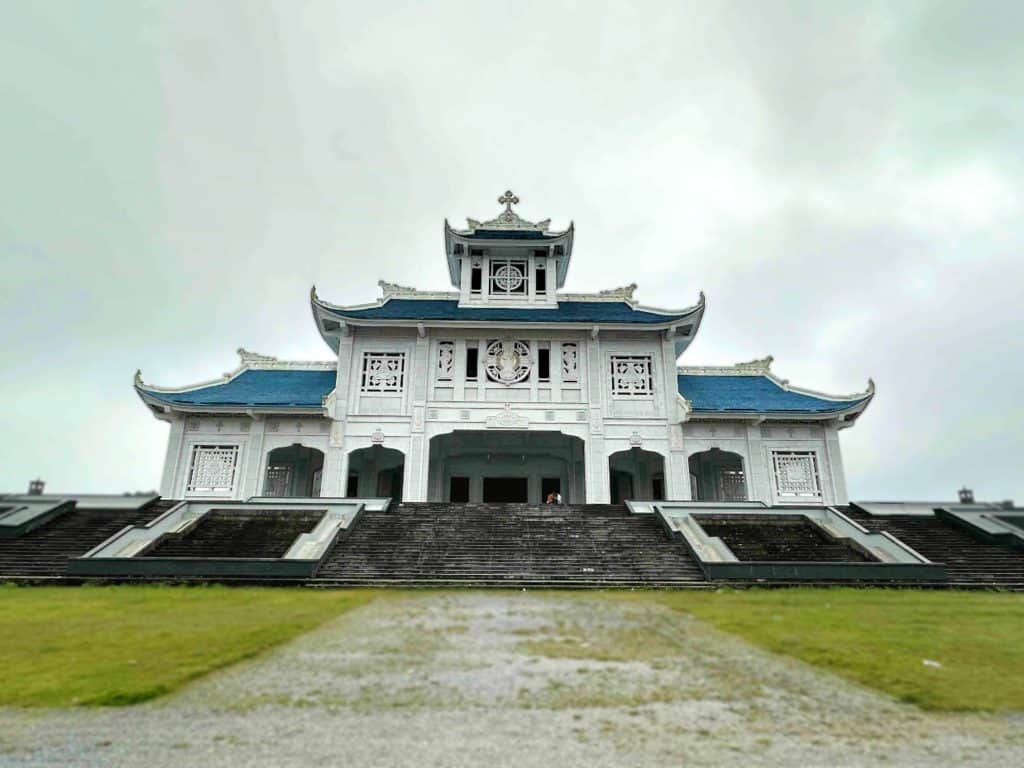
it was a superb tour of Marian shrines in France. Sandra was fantastic and knowledgeable as our tour guide…she took care of all changes in her stride!!! The Hotels had fine accommodations.
We were so blessed to have been able to join the tour group Shrines of France Pilgrimage” in May 2023. My favorite parts of the tour included the convenience of having most meals arranged for us. The breakfasts and dinners at the Mercure hotels were top notch. Their bedrooms were also very well appointed. Some meals at other hotels were less impressive but I am not going to complain about that particularly. The presence of a French tour guide was a best advantage. My husband and I had been to many parts of France several times before. We toured back then with family, and were guided pretty much by travel books. The luxury of a tour guide, Frederick who knew French history was a big plus. His English translations may be made better by classes in ‘English as a Second Language’. He was very receptive to our requests for stops (bathroom breaks) while on the road. He understood the attractions of shopping and waited patiently for those who shopped. He was polite, respectful and was very perceptive. He also remembered our names which was a feat by itself. Henry and I are very interested in the lives of saints and the quick bios we received from Frederick, Father Paul and the videos from various churches we visited were all avidly absorbed by us. I loved our time in Lourdes and though we were drenched by an evening shower, I enjoyed joining the procession on our first day. I was also very ecstatic that because of a lucky break, we were able to get a 1st row seat by the grotto in a mass that the Bishop of Lourdes officiated at. All our experiences at the various locations were positive for me and I can do them over again. My favorite place was Rocamador. There was also a High Mass that we were so blessed to have attended (Liseux). The opportunities to have our own masses at the churches we visited were all very much appreciated. Thank you to Father Paul for that. To have seen the incorrupt bodies of multiple saints were once in a lifetime gifts to myself, my husband and the other members of our group.
First of all, the trip was really a journey, my personal journey to know more and experience my myself in my faith. This is my first pilgrimage and I am glad I choose your company. I especially like that we have mass every day. I loved going to Lourdes. I really found the stations of the cross there very powerful for me. Father Paul was such an added Bonus. I enjoyed having mass every day. Lastly, Paray le Monial was beautiful but one day there is enough.. Beautiful hotel the owner is so kind and accommodating. All in all, so much so I will attempt to take my sisters on a Catholic Journeys pilgrimage to Poland next year.
I would like to express my appreciation on my memorable and unforgettable experience which Catholic Journeys made possible.
Our guide was very knowledgeable and motivated. He was very kind and considerate and very responsive to our comfort needs all throughout the pilgrimage. He is also very passionate about giving us as much background information as possible at every opportunity. He is kind, warm and funny. I never saw him get upset or lose his temper. He patiently accompanied me to get some tax free document even when I was reluctant to seek his help out of concern for delaying our schedule. He deserves an A++ rating.
I enjoyed all the Shrines especially Lourdes and Mt St Michel. Over-all, the lodgings were good. The food was good and very generous too. Thank you most kindly for making wine available (sometimes both red and white) during dinner. The food at the restaurant close to Hotel Route de Chateau in Rocamadour was excellent. I have to give special mention to Veronique, owner of Hotel de la Basilique in Paray Le Monial. She was most helpful with my roommate’s luggage. The bread she served was the best! Our room has a bathroom view of the basilica.
Our driver, Aimen, was most friendly and competent. He navigated the narrow street maneuvers and parking with utmost efficiency. In my personal opinion, I could have used a little bit of some cultural excursions or visit to some historical non-religious places to lighten up the schedule and break the monotony of visiting so many churches. That’s just me, though.
I wish you more success.
The pilgrimage was wonderful and I loved the variety of churches visited . The food was excellent except Basilique although Veronique was an all-around help for everyone. The ride was excellent too. The driver was very polite, helpful, skillful safe driver with a sense of humor. The tour guide, was very knowledgeable about the history, geography of the different towns visited. He is patient, flexible and helpful too. I just have a problem understanding him sometimes (could be the accent).
I am also happy that we have a priest to officiate mass every day . Fr Paul’s homilies are practical and in a sense that it applies to our daily life and often related the readings to our pilgrimage He too has a sense of humor. I thank Jimmy for Modifying my flight schedule so I can have a nonstop flight from Philadelphia to Paris and NOT traveling all night all day to get to Toulouse.
- Regions of France
- French Departments
- Atlantic Coast
- Centre-Val de Loire
- Champagne-Ardenne
- Loire Valley
- Midi-Pyrénées
- Nord Pas de Calais
- Poitou-Charentes
- Provence-Alpes-Côte d’Azur (PACA)
- Battlefields & Memorials
- Museums & Art Galleries
- Theme Parks
- Christmas Markets
- Cruises/Canals
- Walking & Cycling
- Towns & Cities
- Travel to & around France
- Accommodation
- Restaurants

The Great Sacred Sites of France
It’s generally agreed that the Sanctuary of Our Lady of Lourdes in south west France is one of the great sacred sites of France. But then what? How do you class a sacred site?
There are many criteria: number of pilgrims, the relics that a particular cathedral or basilica holds, or perhaps some of the Villes Sanctuaires (Sanctuary Towns) of which there are 19 listed. Or perhaps a small chapel you discovered where a sense of peace or completion flooded over you.
Many of the great sacred sites of France were part of the great pilgrim routes that criss-crossed the country. You can still walk them today from different parts of France to the Pyrenees and beyond that to the goal of St. James of Compostella in Spain.
So many of the great sacred sites of France might just be a personal choice. Some of those included here are indeed great sacred sites of France. Others are my own personal discoveries.
I have not included the great cathedrals of France; that’s another story.
Let me know of any sacred sites that you find; France is a big country!
Sanctuary of Our Lady of Lourdes, Haute-Pyrénées in Occitanie

Lourdes is in south west France, bordering on the Pyrenees . The city rose relatively late to become the second most-visited Christian pilgrimage site in Europe after Rome. Now it attracts around five million pilgrims a year and comes top of many people’s list of the great sacred sites of France.
In 1858, the peasant girl Bernadette Soubirous claimed to have seen the Virgin Mary 18 times. Mary told Bernadette to drink the water from a small spring which would cure various illnesses, and so the story goes, it came to pass. The Catholic church has officially recognized 69 miraculous healings.
Known also as the Domain, the area surrounds the catholic shrine to Our Lady of Lourdes. The site includes the grotto, churches and basilicas, Sanctuary Baths and various office.
More about Lourdes
Basilica of St. Thérèse, Lisieux, Normandy

Less well known than many religious sites, this is the second pilgrimage site in France after Lourdes, attracting over 2 million pilgrims a year.
Saint Thérèse (1873-1897), born Céline Martin, became a Carmelite nun at the age of 15, along with 2 older sisters. Her simple life was a model of 19 th -century decency and modesty, and it was the small acts of kindness that were all important. Named Thérèse of the Child Jesus, she was also called The Little Flower.
She was a prolific writer and is best known for L’histoire d’une âme ( The Story of a Soul ), a collection of autobiographical manuscripts published two years after her death. The book inspired various Popes to speed up her beatification (usually granted 50 years after death) and canonization on May 17, 1925. Though five years after France’s great heroine, Joan of Arc, was made a saint, the more popular Therese had a greater ceremony in St. Peter’s. Her Saint’s Day is October 1. She’s the patron saint of aviators, florists, illness and missions.
Saint Thérèse has particularly eclectic followers, from Edif Piaf to Delia Smith. Mother Teresa of Calcutta, originally called Agnes, explained her choice of the name Teresa: “I chose Thérèse as my namesake because she did ordinary things with extraordinary love.”
Construction of the Basilica of St. Thérèse in Lisieux started in 1929 and finished in 1954. It was consecrated on July 11 that year and became a world wide centre for pilgrims.
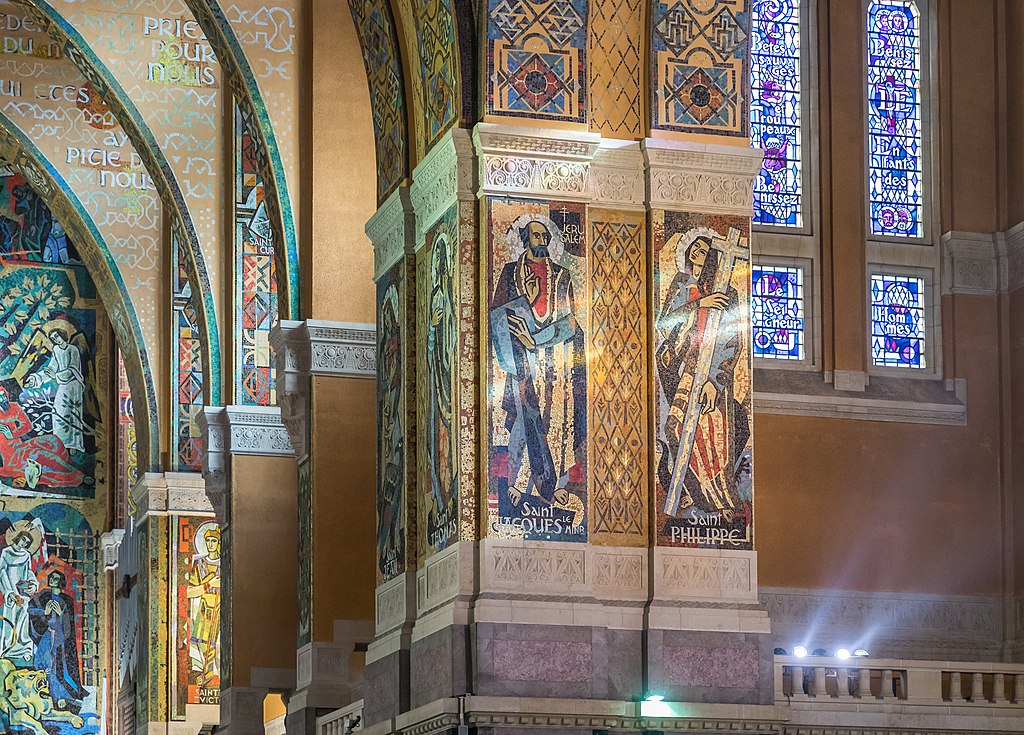
The largest church built in France in the 20 th century, it dominates Lisieux from its hillside site. It’s 90 metres high and incredibly ornate inside with neo-Byzantine style décor. There’s an exhibition inside on Sainte-Thérèse’s life and the Carmelite Order.
More about the Basilica of Saint Thérèse
Mont-Saint-Michel, Normandy

The magnificent Mont-Saint-Michel stands on an island just off the Normandy coast, the abbey a magnet for pilgrims since the Middle Ages. They called it ‘St. Michael in peril of the sea’. Easy to defend even during the Hundred Years’ War, it remains a magical rocky island topped by a great abbey.
Mont Saint Michel Abbey is one of the oldest in France. In the 8 th century the bishop of nearby Avranches claimed that the Archangel Michael had tasked him with building the abbey and the project began. From 966 onwards, the powerful Dukes of Normandy lent their considerable support and finances, and Mont St Michel grew in power and influence.
Its buildings were magnificent, climbing up the hillside to the abbey; its library full of priceless illuminated manuscripts, its buildings busy with scholars. Perched high above the pinnacles, arches and roofs, a statue of St Michael, the weigher of souls, looks down over the achievements of mankind.
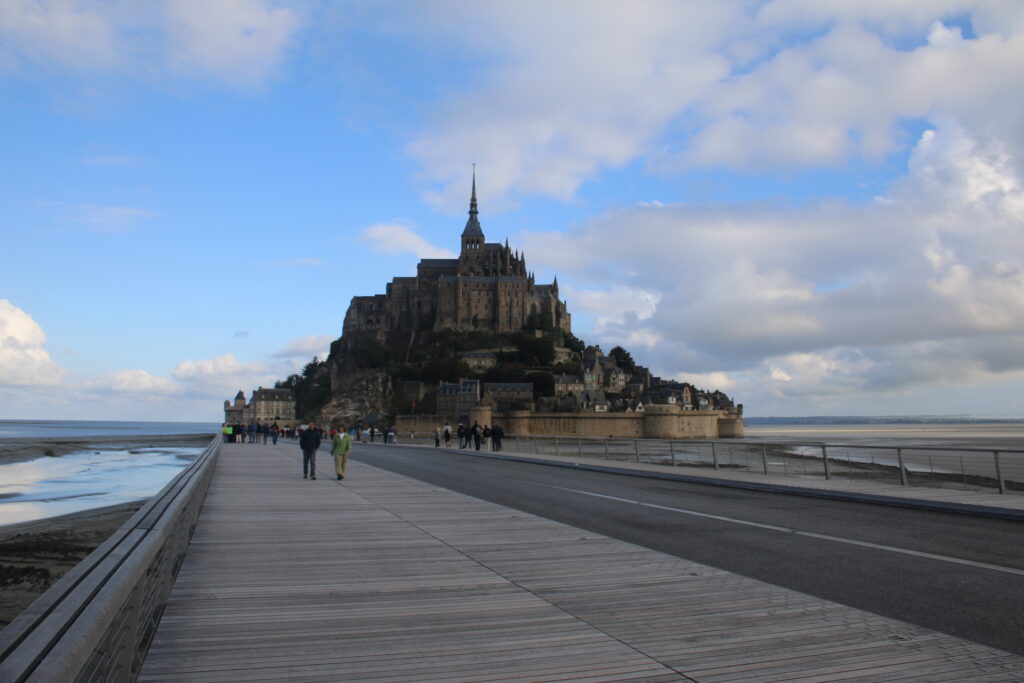
Over 3 million people visit a year and Mont St Michel is overrun in summer, so try to go out of season. It’s easy to access since a huge €209 million scheme to ease the flow of water and stop the silting up of the river that flows into the bay, take away the old causeway and create a bridge across the sea was completed in 2014. Now you park around 1.5 miles away, and take a shuttle bus to the mount. You can also walk across the bridge, or book a special horse-drawn carriage.
UNESCO World Heritage Site. More about Mont-Saint-Michel .
Rocamadour in the Lot, Occitanie
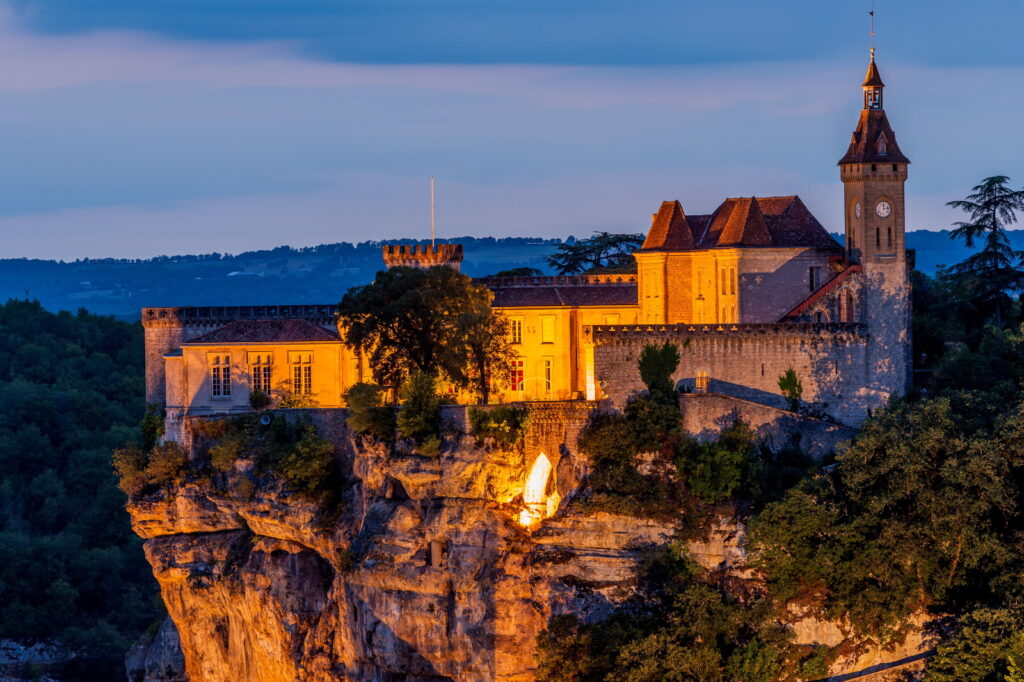
Rocamadour is a dramatic site. The sanctuary of the Blessed Virgin Mary dominates the village built on the banks of the river Alzou. Enter the village through the Figuier Gate and walk along the only street.
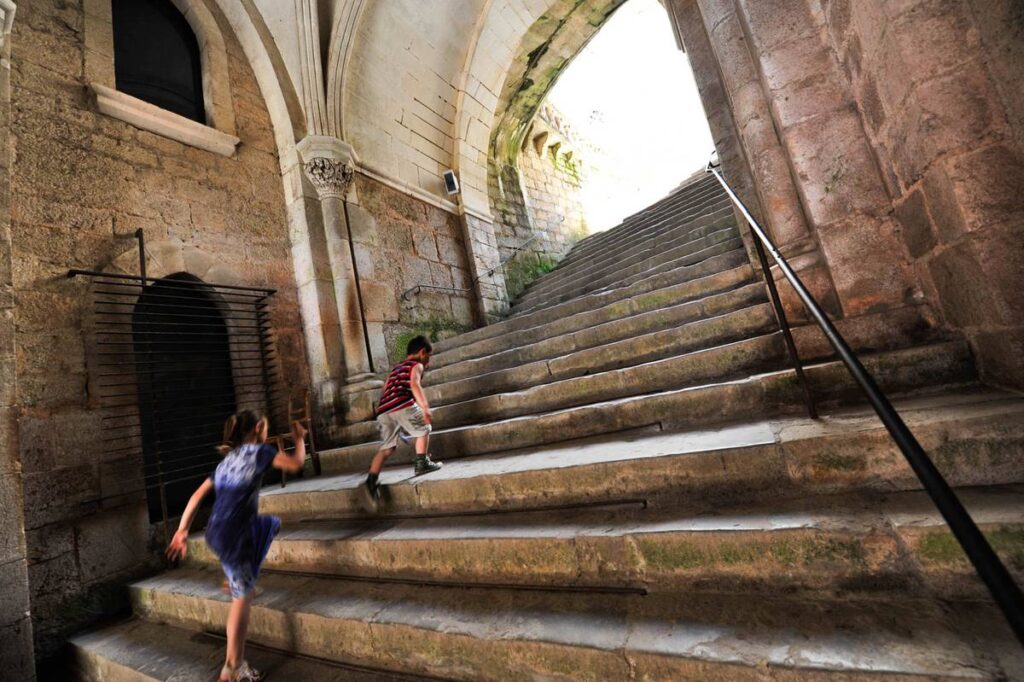
A series of 216 stone steps leads up to a small square where 8 chapels and churches make up the religious complex. The main building is the chapel of Notre Dame chapel, rebuilt in 1479. The reason for the visit? A black Madonna, carved in the 12 th century from walnut. Below the basilica lie the remains of Saint Amator (Amadour), the reason for pilgrimages from the 12 th century to today walking on the Way of St James.
More about Rocamadour
Abbaye de St. Foye, Conques in the Aveyron department of Occitanie

Conques , now a UNESCO World Heritage site was one of the main stops for medieval pilgrims on the Way of St. James.
Totally rebuilt between 1045 and 1060, the Abbaye de St. Foye is one of the oldest abbeys on the route to Santiago in Spain. It’s a remarkable building in a beautiful and very small medieval stone village, seemingly tucked away. It’s difficult to imagine the thousands of pilgrims flocking here in the Middle Ages to see the treasures.
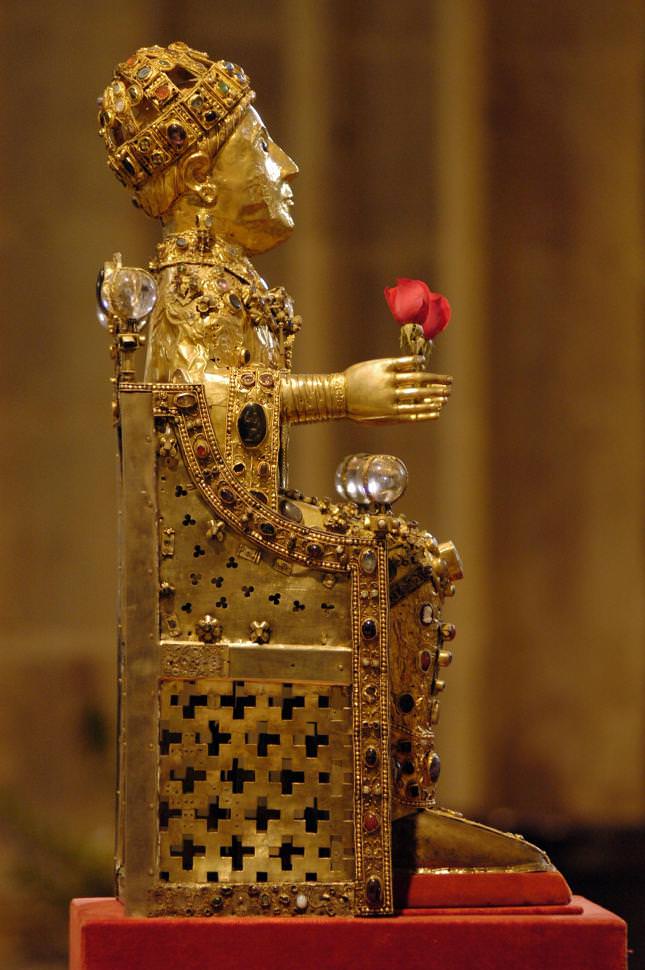
The arm of St George the Dragon Slayer might be a bit much for modern pilgrims to take seriously, but the golden reliquary of the remains of St. Foye, a young girl tortured to death for her beliefs in the fourth century is quite extraordinary.
Read more about the Abbaye and the medieval village of Conques .
St Guilhem-le-Désert in the Hérault, Occitanie

The strange name, Saint Guilhem-le-Désert , derives from the founding of an abbey in the 9 th century in the uninhabited alley of the Gellone river. Its fame as a pilgrimage site came with the belief that the Abbey of Gellone possessed a relic of the true cross. With fame came pilgrims on the Way of St James to Santiago de Compostella. A village grew up around the abbey to meet their needs with many of the old buildings still standing in one of Plus Beaux Villages de France .
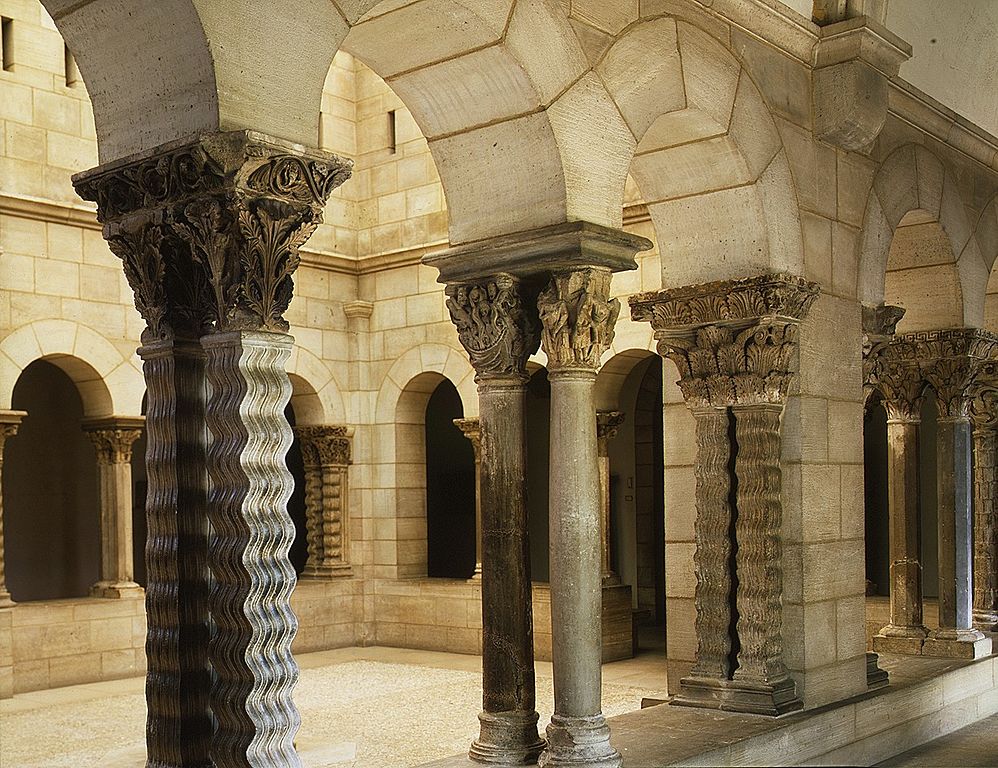
As with so many religious establishments, its downfall came with the French Revolution. Some bits survived; a large part of the 12 th -century cloister was exported to the USA. You can see it in the Met Cloisters Museum in New York when a new gallery with a protective skylight opens on October 7th, 2021.
In summer pilgrims give way to music lovers who fill the abbey and the chapel of the Penitents for some top concerts.
More about St. Guilhem-le-Désert .
Vézelay in the Yonne department in Burgundy-Franch Comté

The Romanesque Basilica of St. Mary Magdalene is one of Europe’s great abbeys. It must count in any list of great sacred site of France. It’s a huge structure, built in the 9 th century by the Benedictines and dominates the hill above the small town of Vézelay. Its fame came with the news that a monk called Baudillon had brought relics of Mary Magdalene from Saint-Maximin-la-Sainte-Baume in the Var in one of those strange medieval exchanges of relics from one church to another.
It became the starting point for one of the famous pilgrimage routes to Santiago, The Way of Vézelay ( the Via Lemovicensis ). In 1146 it became a rallying point for further sacrifices when Bernard of Clairvaux preached the Second Crusade with King Louis VII of France. Now bare and silent, it’s difficult to imagine the thousands of pilgrims who waited in the huge entrance chamber to go into the Basilica itself.
Apart from its stunning architecture, it has one further claim to fame. At midsummer the light floods through the window onto nine spots in the nave that converge onto the altar. Surely by design.
Vézelay is a UNESCO World Heritage Site. More about Vézelay here .
Les Saintes-Maries-de-la-Mer in the Camargue, Bouches-du-Rhône, PACA

Les Saintes-Maries-de-la-Mer is the capital of the Camargue, a strange, wonderful and remote part of France cut off in the Rhône delta. The name comes from the three Marys who first witnessed the empty tomb of Jesus. Mary Magdalene, Saint Mary of Jacob and Saint Mary Salome fled Palestine and landed here, the legend goes, in 45AD. There was another on the boat: Sara, sometimes called Sara-la-Kali, a servant to the other three.
Two pilgrimages celebrate the Marys in October and December. But they are relatively small. The major celebration is in May when thousands of gypsies from all over Europe come to the town to honour Sara. On May 24 and 25, they take the statue of Sara from the 12 th -century church down to the sea and bring her back again. It’s colorful and musical and quite different from most celebrations of saints.
More about Les Saintes-Maries-de-la-Mer
More Great Sacred Sites of France
Grand synagogue de lyon, auvergne-rhône-alpes.

During the early 19 th century, thousands of Jews came to France and the idea of a Grand Synagogue in Lyon was born. In October 1853 Emperor Napoleon III created a Consistory which gathered together the Jewish communities of seven departments. Various sites were looked at then in 1862 the city offered an old salt warehouse on quai Tilset. A young Jewish architect, Abraham Hirsch (1828-1913) was appointed and work began a year later. Hirsch went on to become the official architect of the city of Lyon. The synagogue opened in 1864.
The city was part of the Zone libre in World War II, and the synagogue played its part in sheltering Jews from all over France. But it didn’t escape and was attacked in 1943. On June 13, 1944, French soldiers arrested everyone in the synagogue. They were finally sent to Auschwitz on Jul 31, 1944.
Today the synagogue, a large and imposing neo-Byzantine building is the most important of five synagogues in central Lyon.
More about the Grand Synagogue of Lyon .
Grand Mosque of Paris – Mosquée de Paris

You’ll find the oldest mosque in mainland France in the Latin Quarter in Paris. The Grand Mosque was built between 1922 and 1926 after World War I to remember and commemorate around 100,000 of France’s Muslim soldiers died in the fighting. In World War II the mosque offered fake Muslim birth certificates to Algerian and European Jews to escape German persecution.
It’s a magnificent building dominated by a 33-metre high minaret, a highly decorated prayer room and a patio with sculpted arcades running around the sides. If you’ve visited the Alhambra in Granada it’ll seem quite familiar. There’s also a hamman, restaurant, tearoom and a shop which is just like entering a souk.
More about the Grand Mosque of Paris
My personal choice of the Great Sacred Sites of France
Abbey of jumièges, seine-maritime, normandy.

Normandy had a large number of the great sacred sites of France. Of over 120 abbeys in the middle ages around 60 survive today in some form. Of these, my favorite is the now ruined abbey of Jumièges on a bend on the River Seine.
Founded in 654, the Benedictine monastery was rebuilt in the 10 th century and was consecrated in 1067 in the presence of William the Conqueror who had returned from England. Fame and fortune created a centre of religion and learning producing major clerics like Robert Champart who became Bishop of London then Archbishop of Canterbury in 1051.
Jumièges survived the centuries, but fell, as so many religious institutions did, at the French Revolution. The monks were scattered and the buildings attacked. Today it’s one of the most romantic ruins in France, a peaceful place which you can walk through accompanied just by the sound of birdsong and the rustling of leaves in the trees.
I first visited on a cold November morning when the mist was rising and it was deserted. I fell in love with the place immediately. So it’s on my personal list of sacred sites.
More about Jumièges .
Read about other great sites and attractions in Normandy .
Basilica of St. Julien in Brioude, Haute-Loire, Auvergne-Rhône-Alpes
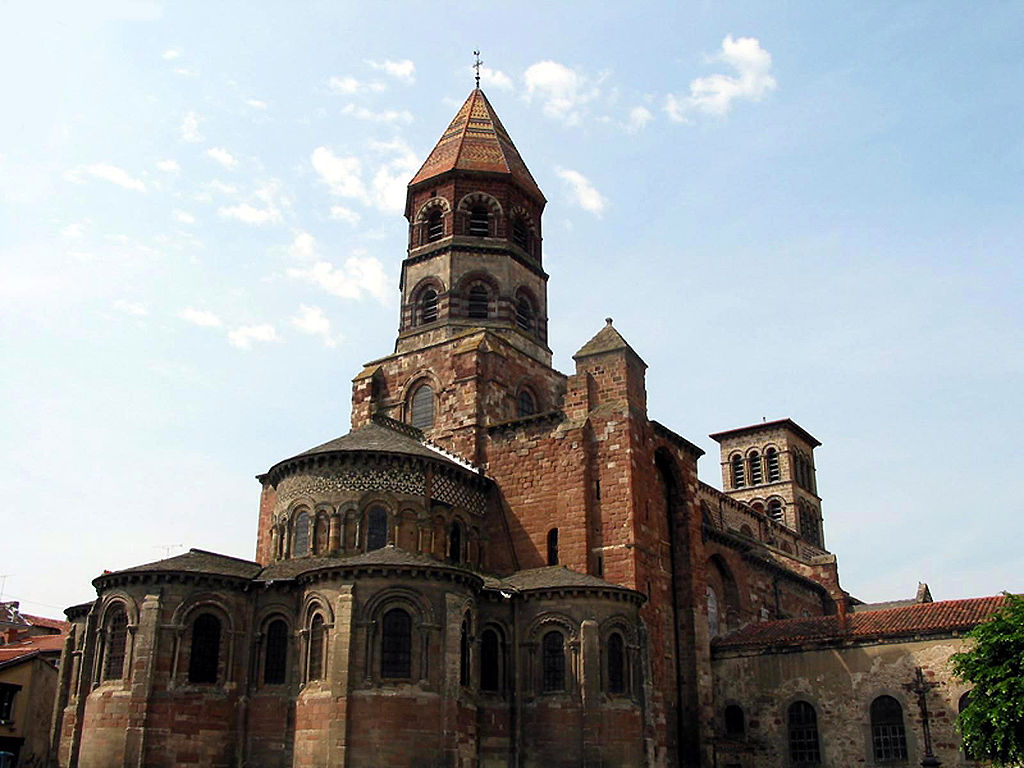
The Auvergne has some wonderful Romanesque basilicas and churches. The most striking one is the Basilique Notre Dame du Port in Clermont Ferrand. But I have included St. Julien in Brioude as it’s the nearest to my house and it’s less well known.
It was built in the 11 th century and enlarged in the 13 th on the site of a sanctuary dedicated to St. Julien. The Roman soldier converted to Christianity and was martyred as a result in 304. St. Julian has typical Auvergne Romanesque architecture: solid as the rock of ages as befits this remote, volcanic region. But inside it’s gloriously colorful. Wall paintings on the walls; a 16 th century floor of basalt and quartz stones and a superb 12 th -century frescoes in the Chapel of St. Michael. There’s a typical chevet (an arch at the eastern end of the church) and wonderful sculpted capitals.
More about Brioude .
More about the remote and beautiful Auvergne .
Here are 9 of the most famous French Gothic Cathedrals .
Privacy Preference Center
Consent management, advertising.

- Private Tours
- Customise your Tour
- Book Your Tour
Religious Tourism in Normandy, France
Normandy , located in the northwest region of France, is a destination rich in history and spirituality, offering visitors a variety of significant religious sites.
When exploring religious tourism in Normandy, pilgrims are invited to immerse themselves in centuries of tradition and devotion while witnessing the historical events that have shaped the region.
Saint Michael the Archangel: Religious Tourism at Mont Saint-Michel
Mont Saint-Michel is one of France’s most iconic and impressive sites, renowned for its spectacular architecture and religious significance.
Located in the Normandy region on the northwest coast of France, Mont Saint-Michel is a rocky island that rises majestically from the vast estuary of the Couesnon River.
Its history dates back centuries and is deeply rooted in faith and religious devotion.
History of Mont Saint-Michel :
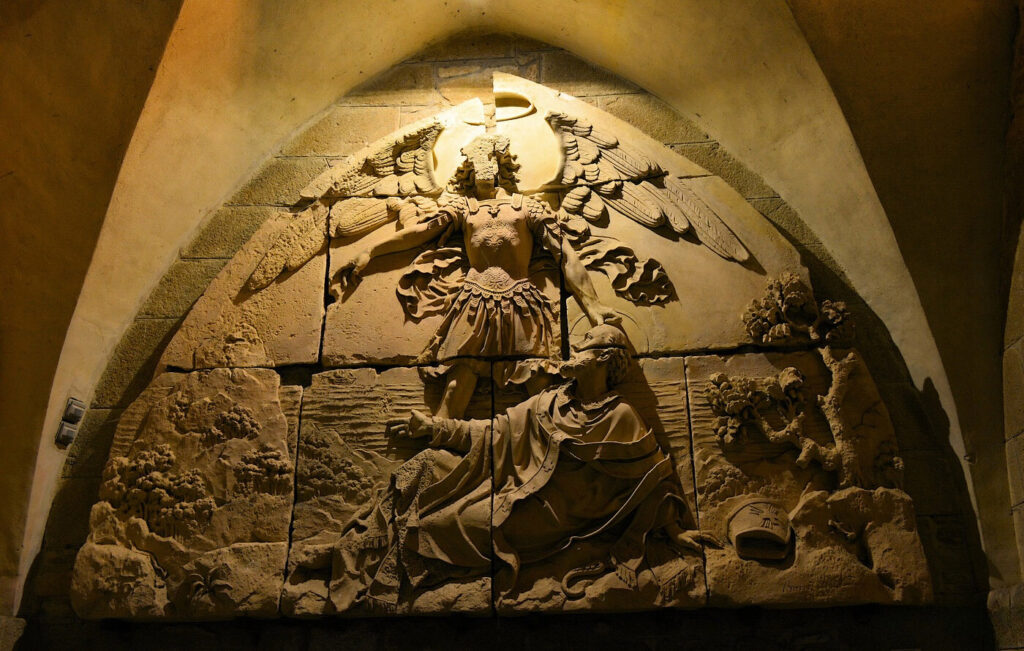
The history of Mont Saint-Michel begins in the 8th century when a sanctuary was built atop the island by order of Bishop Aubert of Avranches.
According to legend, the Archangel Michael appeared to Aubert and instructed him to build a church on the site. The initial sanctuary attracted pilgrims and monks, and over the centuries, the monastic complex was expanded to include an abbey and a village around the base of the island.
During the Middle Ages, Mont Saint-Michel became an important center of Christian pilgrimage in Europe.
Its isolated and imposing location in the middle of the sea made it a symbol of faith and divine protection for sailors and pilgrims traveling through the region’s treacherous waters.
The abbey flourished as a center of religious and cultural learning, attracting scholars and monks from across Europe.
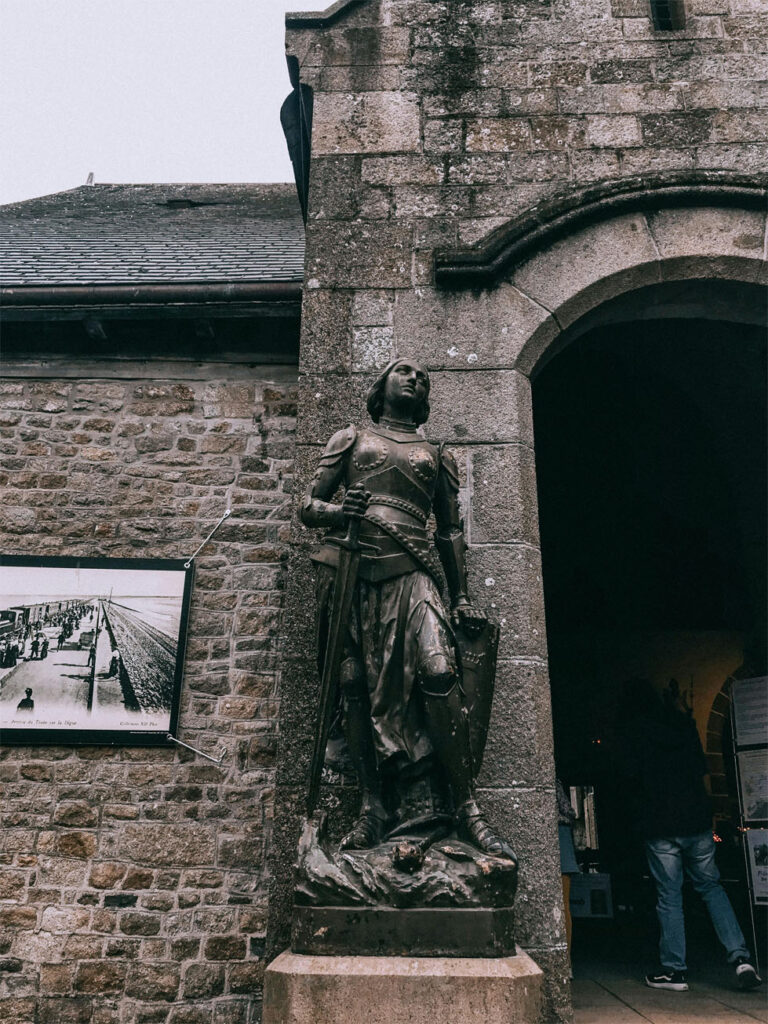
Architecture and Pilgrimage Site :
The architecture of Mont Saint-Michel is truly impressive.
At the top of the island stands the majestic Abbey of Saint-Michel, a masterpiece of Romanesque and Gothic architecture.
The abbey is adorned with towers, cloisters, and a spectacular church, offering breath-taking views of the surrounding landscape.
The labyrinth of narrow streets and alleys of the village below the abbey is equally charming, with picturesque stone houses, shops, and restaurants that maintain the medieval charm of the region.
In addition to its architectural significance, Mont Saint-Michel is revered as a sacred site for Catholic faithful.
Over the centuries, thousands of pilgrims have made the journey to the Mount in search of healing, forgiveness, and spiritual guidance. The presence of the abbey and the aura of mystery surrounding the island have contributed to its reputation as a place of connection with the divine.
Contemporary Legacy
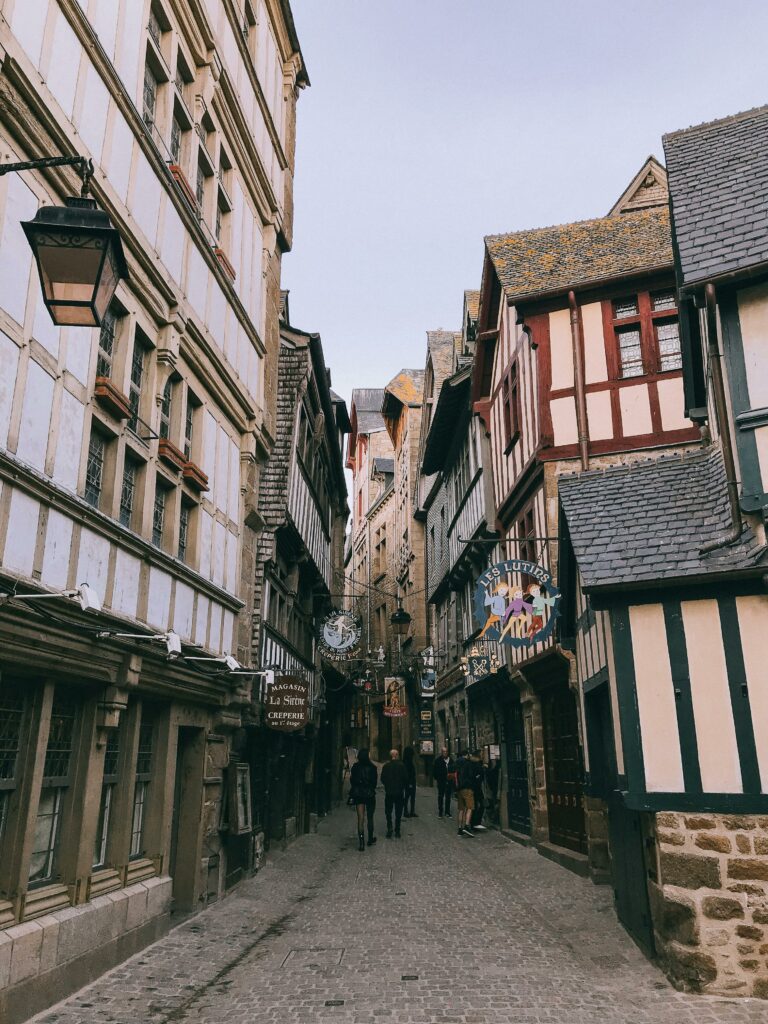
Today, Mont Saint-Michel remains a popular tourist destination, welcoming millions of visitors every year.
In addition to its religious and historical appeal, the site is recognized by UNESCO as a World Heritage Site, highlighting its cultural and architectural significance.
Although no longer an active monastic center, the abbey is still inhabited by a small community of monks and is a place of worship and devotion for Catholics.
Mont Saint-Michel is also known for its religious festivities, including processions and celebrations that attract faithful from around the world.
Rouen: Saint Joan of Arc and Religious Legacy
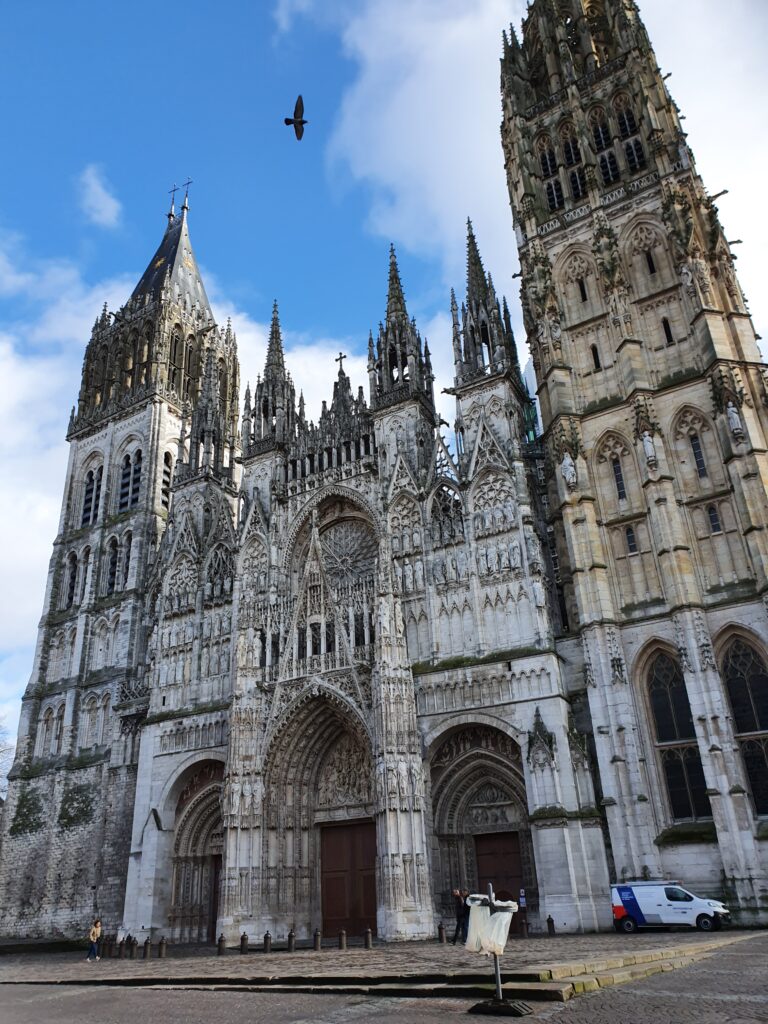
Rouen is indisputably the French city with the highest concentration of religious buildings per square meter!
The grandeur of the churches and the delicacy of the decorations are its main highlights. Let yourself be carried away by emotion as you contemplate these wonders!

Cathedral of Notre-Dame de Rouen :
The Cathedral of Notre-Dame de Rouen is a masterpiece of Gothic architecture and an emblematic landmark of the city.
Its construction began in the 12th century and continued over the following centuries, resulting in a magnificent structure with an impressive blend of architectural styles.
The cathedral is famous not only for its architectural beauty but also for its rich religious history.
It is here that Joan of Arc was tried and sentenced to death in 1431, before being burned at the stake.
The site where she was martyred is now marked by a black marble cross, attracting pilgrims and devotees who come to honor France’s national heroine.
Joan of Arc Pilgrimage Route
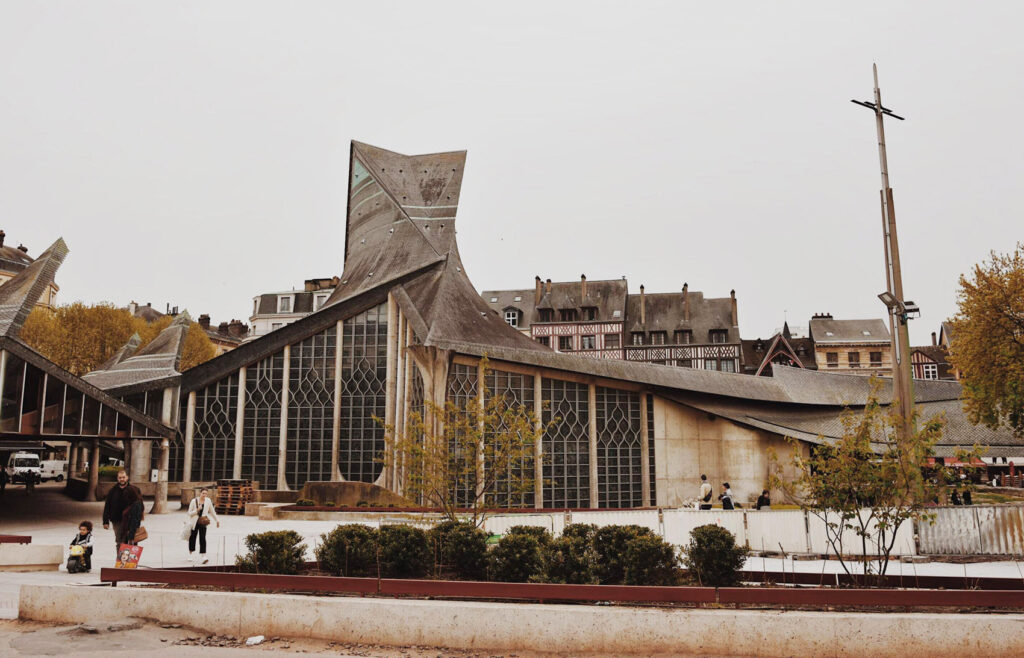
For devotees and enthusiasts of Joan of Arc’s history, Rouen offers a pilgrimage route dedicated to the French heroine.
This route takes visitors to the locations associated with Joan of Arc’s life and trial, including the Old Market Square, where she was executed, and the Church of Sainte-Jeanne-d’Arc, built in her honor.
Following in the footsteps of Joan of Arc through the city provides a unique spiritual experience, allowing visitors to connect with the history and legacy of this inspiring figure.
Saint Therese of the Child Jesus: life and work in the city of Lisieux
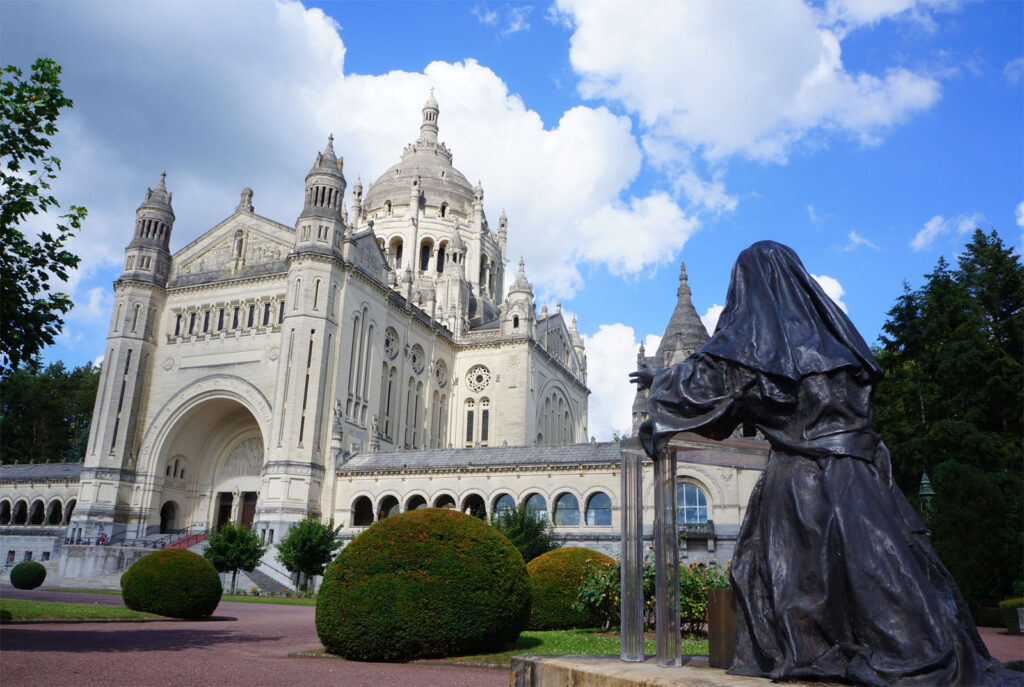
Lisieux is an important destination for religious tourism due to its connection with Saint Thérèse of the Child Jesus, one of the most popular saints of the Catholic Church.
The main points of interest in Lisieux are related to the life and legacy of Saint Thérèse, offering pilgrims and visitors the opportunity to learn more about her spirituality and devotion.
Basilica of Saint Thérèse
The Basilica of Saint Thérèse, also known as the Lisieux Basilica, is the main pilgrimage site in Lisieux.
Built in Romanesque-Byzantine style, the basilica is dedicated to Saint Thérèse of the Child Jesus and is a landmark of the city.
Its interior impresses with its colourful stained glass windows, elaborate mosaics, and a bronze statue of Saint Thérèse. Pilgrims often visit the basilica to pray and pay homage to the saint, whose relics are preserved in the main altar.
Carmel of Lisieux
The Carmel of Lisieux is a convent of the Discalced Carmelites where Saint Thérèse lived as a nun for much of her life.
Visitors can take a guided tour of the convent to see Saint Thérèse’s living quarters, her cell, the chapel where she prayed, and the garden where she spent moments of contemplation and prayer.
The Carmel of Lisieux offers an intimate view of Saint Thérèse’s spiritual life and devotion, allowing visitors to connect more deeply with her message of love and simplicity.
House of Saint Thérèse’s Parents
The House of Saint Thérèse’s Parents is another important attraction in Lisieux.
This childhood home of the saint, known as “ Les Buissonnets ” is preserved as a museum dedicated to the family life of Saint Thérèse and her parents, Louis and Zélie Martin.
Visitors can explore the rooms of the house, including Thérèse’s bedroom, recreated to reflect the environment in which she grew up.
The museum offers a unique insight into the daily life of the Martin family and how faith and devotion were central to their religious upbringing.
Saint Peter’s Cathedral
Although not directly related to Saint Thérèse, Saint Peter’s Cathedral is another important attraction in Lisieux.
This imposing Gothic cathedral is known for its stunning architecture and rich history.
Visitors can admire the elaborate stained glass windows, intricate sculptures, and impressive altar while exploring this significant place of worship in the city.
Religious Events and Festivals
“ Les Fêtes Thérésiennes ” During “Les Fêtes Thérésiennes,” the city of Lisieux is filled with religious, cultural, and festive activities.
Celebrations usually take place around October 1st, which is the date of Saint Thérèse’s death.
The events include special masses and religious ceremonies held at the Basilica of Saint Thérèse and other important places of worship in the city.
On these occasions, pilgrims and devotees from across France and the world gather to pay homage to the saint and participate in liturgical celebrations.
In addition to religious activities, “Les Fêtes Thérésiennes” also offers a variety of cultural and festive events.
Parades, theatrical performances, sacred music concerts, and art exhibitions are organized to entertain visitors and enrich the festival experience. The city comes alive with vibrant colours, music, and joy, creating a festive and spiritual atmosphere around the teachings and devotion of Saint Thérèse.
Alençon : Louis and Zélia Martin and birthplace of Saint Thérèse
The House of Saint Thérèse in Alençon holds great significance for devotees and admirers of Saint Thérèse of the Child Jesus, also known as Saint Thérèse of Lisieux.
Located in the city where Saint Thérèse’s family lived, the house is a pilgrimage site for Catholics and those seeking to learn more about the life and spirituality of the saint.
The house preserves the environment where Saint Thérèse spent part of her childhood, along with her parents, Louis and Zélia Martin, and her sisters.
Visitors can explore the rooms where the family lived, including Thérèse’s bedroom and her parents’ room, as well as personal belongings and photographs from that time. In addition to being a place of historical and religious interest, the House of Saint Thérèse also offers visitors the opportunity to reflect on the saint’s life and spirituality, marked by the “Little Way” and her devotion to simplicity, humility, and trust in God’s mercy.
Many pilgrims visit the House of Saint Thérèse in search of spiritual inspiration and to pray in front of the places that were significant in the saint’s life, such as her bedroom and the chapel where she used to pray.
The site is a living testament to the ongoing devotion to Saint Thérèse and a place where the faithful can feel closer to her, seeking her intercession and following her example of love for God and others.
Create your own review
@descobrindoanormandia
Join our growing network of explorers, wanderers, and travel enthusiasts by following us on Instagram. Stay updated with our latest travel inspirations, insider tips, and breathtaking destinations!


- Current Edition
- Edition Archive
- Religious Travel Planning Guide
- State Guides
- Theaters Guide
- Museum Guide
- Cruise Guide
- Scenic Rail Guide
- Group Itinerary Ideas
- Broadway for Groups
- Site InSpections
- Accommodations
- History & Heritage
- Food & Beverage
- Entertainment
- Outdoor & Adventure
- Industry Events
- Expert Advice
- Industry News
- Traveling Tribes Podcast
- Traveling Tribes Book
- Subscriptions
Select Page
8 Religious Sites and Churches in France
Faith Based Travel
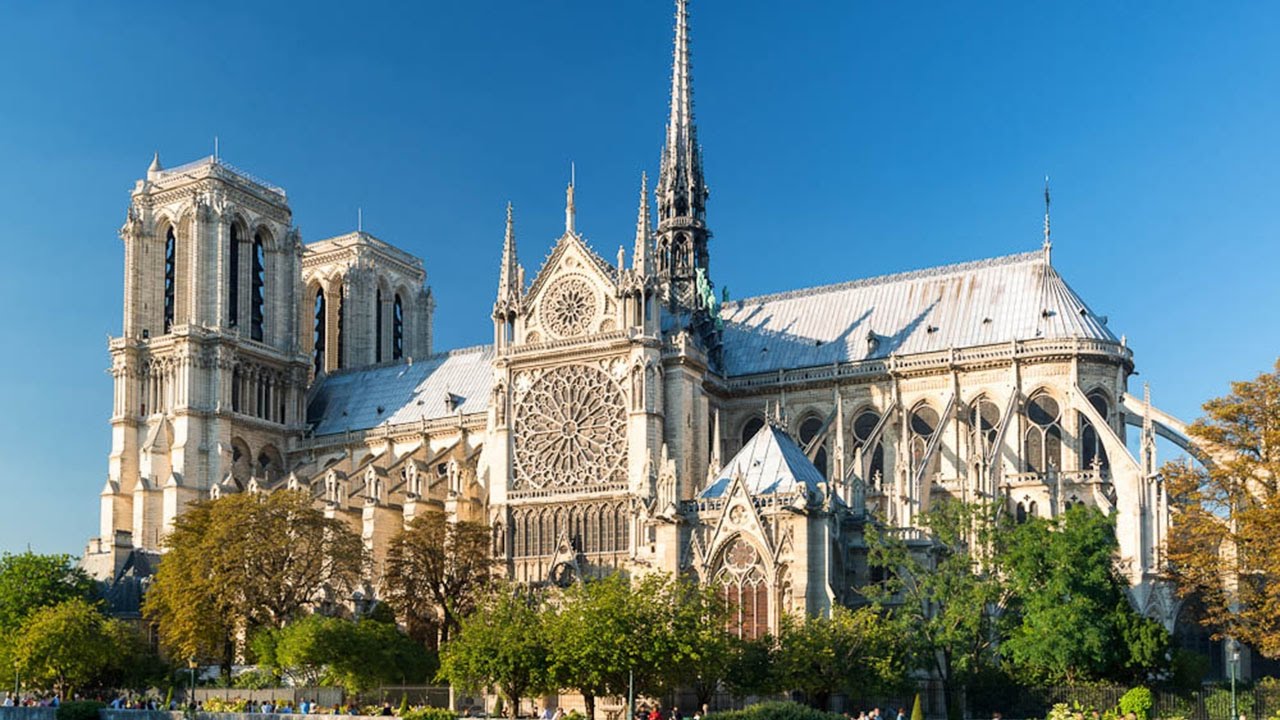
From the City of Lights to the River Dordogne, travelers will be enlightened by the religious sites and churches in France
Visitors who embark on quests of faith or recreation will find that the numerous religious sites and churches in France reflect its eclectic mix of the religions themselves. You’ll immerse yourself in painstakingly created stained glass windows, marble floors and limestone exteriors, as the country is best known for preserving some of the most beautiful churches in the world. You can also find faith outdoors. Surrounded by France’s bustling cities, green jardins and azure rivers are scenic natural sights. People venture to these places day and night to worship peacefully and to revel in the country’s historic wonders at these religious sites and churches in France.
Notre-Dame de la Garde
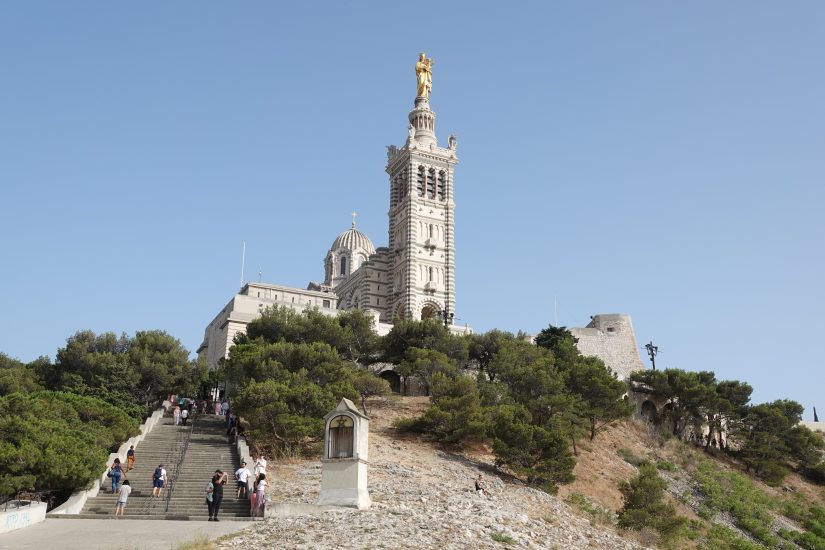
Notre Dame de la Garde
Notre-Dame de la Garde reaches its peak visitor rate every year on August 15, when travelers and locals participate in a pilgrimage to the church on Assumption Day. On any other day, it remains Marseille’s most recognized symbol, translating from French to “Our Lady of the Guard,” and aptly so; it stands proudly protecting the city at 489 feet. This basilica replaces a church first constructed in 1214 and restored in the 15 th century under the same name.
Most visitors will find that the religious center’s beauty lies in its physical details and in its cherished history. Outside of its limestone façade, Notre-Dame’s lower church boasts a rock-carved, Romanesque-style crypt, while the upper church embodies a Neo-Byzantine style with elaborate mosaics, many of which were restored after being hit by bullets in World War II. Visitors can pray in either of the two places, or take a tour up the 135-foot bell tower. It’s equipped with a belfry to support Madonna and Child – both of whom are adorned in copper gilded with gold leaf.
Grand Mosque of Paris
During World War I, about 100,000 of France’s Muslim soldiers died while fighting against Germany. This mosque was built by Northern Africans in 1922 and dedicated to Muslims in 1926 as an appreciation of their military service. In World War II, the mosque offered fake Muslim birth certificates to Algerian and European Jews to ensure protection from German persecution.
Now, this 108-foot tall, Moorish-style mosque is home to millions of Muslims. They gather at various times of the day and night for prayer services within the mosque’s white walls, mosaics and decorated archways. The serene spot also features a minaret on its left, water gardens and stone-paved courtyards. The venue is not open to visitors on Fridays, as those are holy days for practicing Muslims.
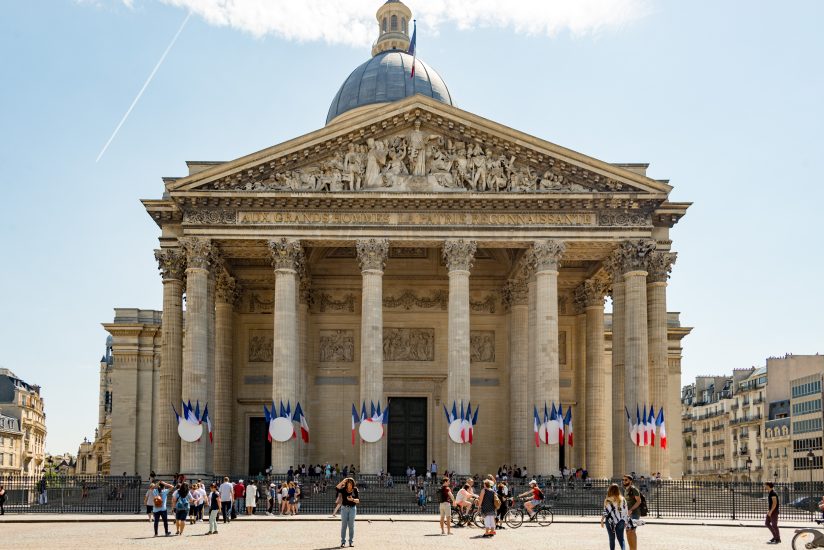
The Panthéon, though Greek for “every god,” was originally dedicated to St. Genevieve in the 1700s. This intent soon changed with the turmoil brought about by the French Revolution; the government instead selected it from among the churches in France and transformed it into a mausoleum to honor fallen soldiers. Now, the first neoclassical monument serves as a final resting place for anyone just as monumental in France’s history, such as Jean-Jacques Rousseau, Marie Curie, Victor Hugo, Voltaire, Émile Zola, Louis Braille and many more.
Its dualities of Gothic and classical, along with light and dark structures can be seen all over Paris, perhaps to invoke reminders of those who sacrificed their lives and to inspire feelings or gratitude to all who visit. The Panthéon’s ivory exterior models its namesake in Rome, with portico columns and a dome similar in structure to Bramante’s “Tempietto.”
Grande Synagogue de Lyon
Increasing numbers of Jews in France during the early 19 th century inspired the Grande Synagogue de Lyon’s conception. After several attempted construction projects on different plots of land, the synagogue opened in 1870. The synagogue played a major role in hosting Jewish refugees during World War I but was unable to do the same in World War II, as French soldiers arrested its inhabitants and sent them to concentration camps. The holy sanctuary then entered a period of deterioration and neglect after being closed for two months.
Today, the Jewish sight is far from being a land of the lost and drinking hall for the militia. The venue includes two pristine brick buildings totaling over 700 square-meter that are accompanied by a small vestibule, three arches and 12 columns symbolizing the 12 tribes of Israel. The bold efface hosts hundreds of Jewish visitors every year in holidays such as Rosh Hashanah and Yom Kippur.
Mont Saint-Michel
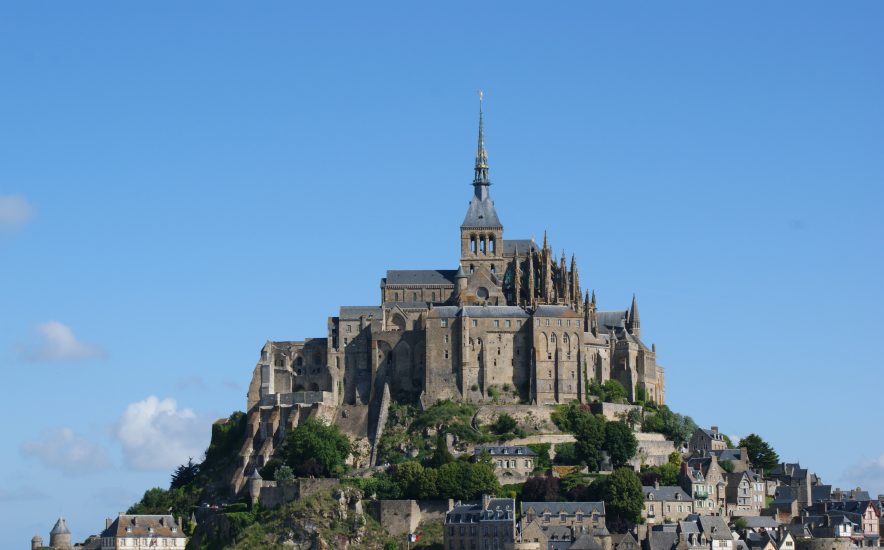
Located in Normandy, this 247-acre island worship venue lies at the mouth of the Couesnon River. Mont Saint-Michel, or “Saint Michael’s Mount,” offers visitors the chance to interact with an alternate world created in the 17 th century. The abbey embraced Romanesque styles of the time, finished off with a precariously positioned crossing supported by underground crypts and chapels. Other parts of the church consist of lava remnants from the Cambrian period and have been impacted by coastal tides and erosion. Before Louis XI turned the abbey into a prison in the Ancien Régime, it was constructed to represent the feudal system of people who inhabited it. At the top are God, the abbey and the monastery, all of which overlook the great halls, stores and housing.
Most visitors who adventure to this quaint village in southwestern France are immediately drawn to the sanctuary of the Blessed Mary and the natural wonders surrounding her, including a gorge above a tributary of the River Dordogne. Aside from earthly historical monuments and statues, churches in this town abound with complexes of monastic buildings and pilgrimage churches. The reigning church is the pilgrimage of Notre Dame, which was constructed in 1479 and reconstructed since to uphold a wooden Black Madonna.
The statute is speculated to be designed by St. Amator, the town’s founding father, who arrived in France after being persecuted in Palestine. The pilgrimage church opens at the bottom into a courtyard – the Plateau of Saint Michel. Saint-Sauveur radiates its aesthetic from the inside out. This church’s interior walls are filled with ornate paintings and inscriptions commemorating pilgrims.
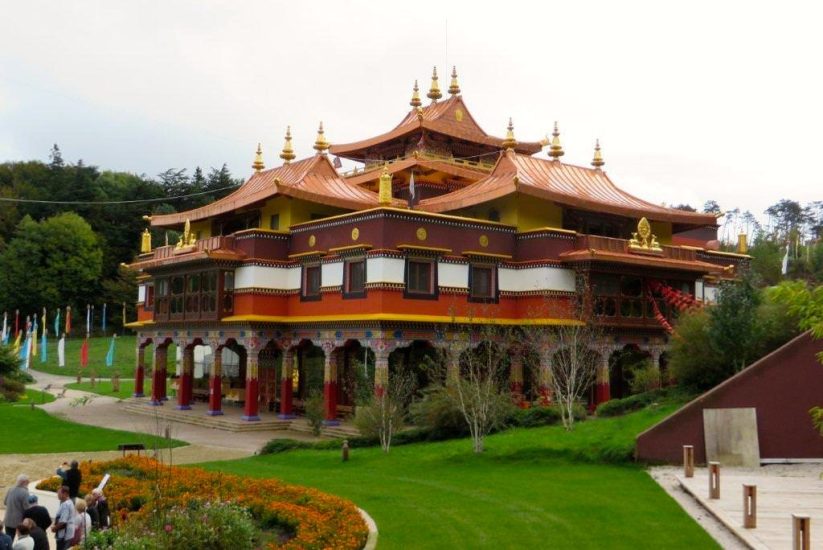
Located in the hilly northwest region of Montpellier, Lerab Ling pays homage to the art and architecture of ancient Tibetan Buddhist monasteries in the Himalayas. The temple was founded in 1992 and most notably hosted the Dalai Lama in 2000 and 2008, establishing it as a leading religious site in Tibetan Buddhist culture. Inside the temple, visitors will find a 33-foot-tall statue of the Buddha surrounded by gold furnishings, colorful paintings and 1,000 bronze Buddhas. Visitors trek to this peaceful oasis for afternoons of meditation and prayerful service. The Buddhist master, Padmasambhava, is stationed on a lake to the northeast side of the temple. Though closed to the general public most days, travelers are allowed enrich their learning in the faith on Sundays.
Armenian Apostolic Cathedral
An Armenian newspaper in Constantinople first called for the formation of an Armenian Church in France in 1902 to serve its growing community. Armenian businessman Alexander Mantachiants took on the feat with 1.540 million francs and completed the project in 1904. France now has one of the largest Armenian populations in the world, many of whom attend prayer services in this church built in their honor. It stands as one of the most prominent Armenian churches not only in France, but in the world.
Located near the Champs Élysées, the Christian church is named after St. John the Baptist. The venue is engraved with the holy seventh letter of the Armenian alphabet, which means “to be” and serves as a reference to God. Its façade is filled with ornate carvings of biblical symbols and strong columns, while the inside features historic scenes of God’s life and walls of windows for natural lighting to shine on the church’s believers.
Did you enjoy this article about religious sites and churches in France? For more information on Religious and Historical Sites in Europe visit Top 30 Pilgrimage Sites in Europe and be sure to subscribe to for FREE to Leisure Group Travel.
Latest Traveling Tribes Podcast
Featured activity, wonders center & science museum.
The museum features a variety of exhibits and activities, including a top-rated planetarium, a million-volt musical Tesla Coil show, full-size dinosaur models, a cafe, interactive kids’ activities, and a gift shop with educational resources. It offers a blend of science, history, and interactive experiences suitable for all ages.
Download Latest Issue
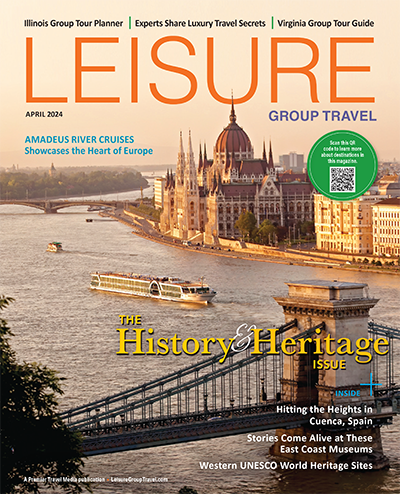
Recent from Faith Travel
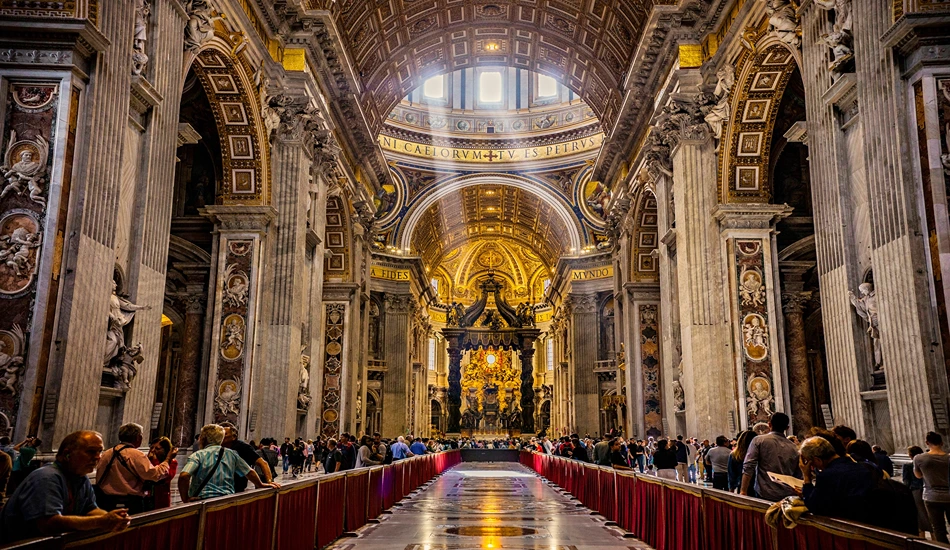
Religious Tour Experts Weigh In as Holy Pilgrimages March On
Despite persistent political conflicts, people continue making spiritual pilgrimages worldwide according to these top religious tour providers
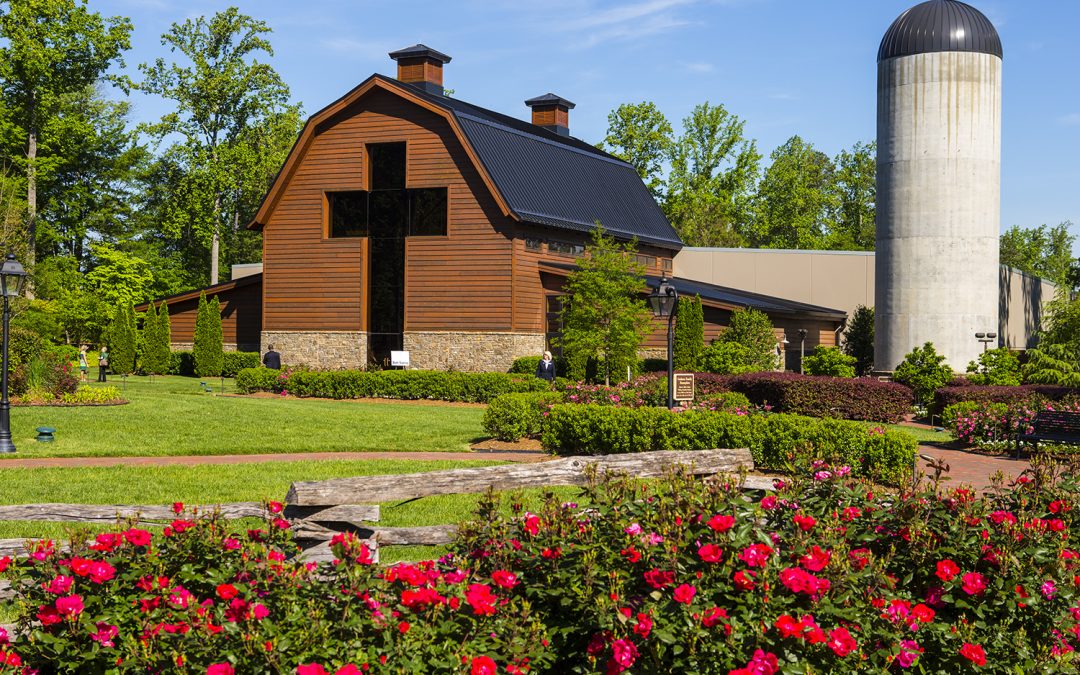
15 Top Religious Attractions in the U.S.
These religious attractions across the U.S. are of special interest to travelers of faith looking to incorporate religion into their itineraries.
Subscribe for Free

You are using an outdated browser. Please upgrade your browser to improve your experience.
- Sacred Destinations
Sacred Sites, Religious Places, Pilgrimages
- Destinations
Sacred Sites in France
- Mosquée de Lyon
- St-Maclou Church, Rouen
National Geographic content straight to your inbox—sign up for our popular newsletters here
France’s most famous pilgrimage site plans a new tourism future
Second in popularity to Rome for Catholics, Lourdes is taking lessons from the pandemic to broaden its offerings.

For the first time in its history, the Sanctuary of Our Lady of Lourdes —one of the world’s most important Catholic pilgrimage sites—was forced to close to the 20,000 souls who flock there every day.
France ’s two-month pandemic lockdown, which began on March 17, 2020, left this holy site bereft of candle-carrying pilgrims. Vast parking lots purged their tour buses, religious souvenir shops secured their shutters, nearby hotels locked their doors.
Even as the COVID-19 crisis crippled the city that usually welcomes more than 3 million visitors a year, Lourdes didn’t stop praying. In fact, the pandemic prompted an unexpected reinvention of a place so firmly rooted in conservative tradition.

Technology became a tool to connect with the world, while also “creating a desire for pilgrims to return,” says Monseigneur Olivier Ribadeau Dumas. “Because we don’t live a pilgrimage from our couch.”
During the pandemic, the church received thousands of prayer intentions daily from people around the world. Led by chaplains in multiple languages, these prayers were aired on television and social media. Feutiers —so-called fire-keepers—continued to light thousands of candles, many initiated through online purchases, whereby a candle could be illuminated, at a distance, in a devotee’s name.
The technological innovation culminated in the world’s first virtual pilgrimage, which took place in July 2020. Broadcast in 10 languages, “ Lourdes United ” drew 80 million viewers. This spark of change has ignited in the tourist-dependent town—in France, second only to Paris in terms of hotel capacity—a desire to reimagine the future. Sustainability—of environment, economy, and above all faith—is the goal.

Miracles in Massabielle
Situated near the border with Spain, the Occitan -speaking town of Lourdes landed on the world map in 1858, when Bernadette Soubirous , an uneducated and impoverished 14-year-old, saw a series of 18 apparitions of the Virgin Mary in the Massabielle Grotto. Told by “the lady” to drink and bathe from a spring, Bernadette dug in the dirt until water gushed forth. This spring was said to have healing powers, and soon drew the sick and the suffering.
( Here’s how the Virgin Mary became the world’s most powerful woman .)
Bernadette’s visions were later confirmed by the Vatican , and she was canonized as a saint in 1933. Seventy miracles have officially been recognized at Lourdes by the Catholic Church since 1862, the most recent occurring in 2008 (and required a decade to confirm). To mark the centennial of the apparitions, the underground Basilica of Saint Pius X was constructed to accommodate 25,000 people—second only in size to the Vatican’s Saint Peter’s.
For generations of pious French families, Lourdes has been a fundamental part of their faith, a destination as much for honeymoons as for healing. But Lourdes’s fame spread well beyond French borders, and even inscribed in international popular culture. Czech-born Jewish author Franz Viktor Werfel, having escaped the Nazis by sheltering for several weeks in Lourdes, trumpeted the tale in the bestselling novel The Song of Bernadette (1941), later transformed into an Oscar-winning Hollywood movie .

Indeed the majority of Lourdes’ pilgrims come from abroad, lending the city a cosmopolitan vibe. Lourdes is home to 25 nationalities, including a Tamil community originally from Sri Lanka. Even non-Catholics are drawn to the spirituality they sense here, the sight of thousands of people coming together in optimistic, hopeful togetherness. Because above all, Lourdes embraces the masses.
“It is a place of the people’s piety, not a place for intellectuals,” explains Ribadeau Dumas. “We welcome people who don’t have words for expressing their faith. Here they can, because it’s the heart that expresses itself in the fundamental gestures of Lourdes: touching the rock, drinking the water, walking in the procession with a lighted candle.”
( Pilgrimages could be the next post-COVID travel trend .)
Rethinking tourism
Over time, Lourdes became dependent on the 300 million euros generated annually by these pilgrimages, the city’s economy linked as tightly to religious tourism as the beads of a rosary. The development of the French railroad directly contributed to the city’s growth as a destination; specialized pilgrim trains equipped with hospital beds were launched. The tourism model was soon set in stone: Most pilgrims arrive in large groups organized by tour operators during a season that runs from April through October. The negotiated hotel rates are cheap, with meals often included.
This funnel of pilgrims has shaped the character of the town, a cityscape molded by mass tourism and marked by faded souvenir shops. In fact, it almost looked like the destination’s best days were behind it. Lourdes had seen a steady decline in visitors over the past decade.

When the sanctuary suffered a loss of visitors during the pandemic, the city buckled, decimated by unemployment and a loss of revenue. The pandemic exposed the perils of an economy wholly dependent on religious tourism.
After the initial two-month quarantine, visitors only numbered 800,000 for the entire year of 2020, and the visitor profile—independent travelers—was completely different from that of the usual tour groups.
“The pandemic invited us to rethink our pastoral actions,” says Ribadeau Dumas. To welcome this new type of visitor with no knowledge of what to expect, the sanctuary changed its approach. Historically, pilgrims are grouped with their own guides and priests who lead them through the experience. For individuals, the sanctuary created a “Pilgrim for the Day” program, which includes background information, a Mass, and a guided visit, among other things.
“We need a larger inclusion of the type of people we welcome," Ribadeau Dumas continues. “My responsibility, within this epoch marked by a de-Christianization of our country and our society, is to envision what’s necessary to do, so that in 2030 Lourdes can still fulfill its mission.”

Government leaders, too, have seized upon the need for visitor diversification. New mayor Thierry Lavit, who has a distant family link with Bernadette Soubirous, perceives an opportunity for the city because of the health crisis. “It’s like hitting a giant reset button,” he says.
( Here’s how travelers can help combat overtourism .)
Because the system had been working for years, there was no reason to change. In essence, the city—built to accommodate mass tourism—had been frozen in time. Now the government’s “Avenir Lourdes” plan—still in its early stages—sets in motion an ambitious 10-year blueprint to rebuild the destination by modernizing and attracting new visitors in a sustainable way. Aiding the plan’s eventual implementation is the massive 140 million-euro rescue package earmarked by the French state.
In February, Lourdes launched an electric bike- and car-sharing program with adjacent townships. The night train line (eliminated in 2016), an affordable and sustainable means of transportation, will run again beginning this December. A wide-scale greening program has begun with the Peyramale square, which used to house the giant glass tourist office, now moved a few blocks away. Next on the agenda is pedestrianizing large swaths of the city and cleaning up the riverside quays.
While the sanctuary remains the principle destination, other attractions will draw a different clientele. Among them, a reconfigured “medieval” walking path would bring tourists to the upper town, featuring the ancient fortified castle currently being restored, where Charlemagne besieged and defeated an occupying Moorish chief in A.D. 778.
“I call Lourdes ‘Sleeping Beauty,’” Lavit says. “You have to believe, mobilize, do everything to wake her up.”
The pandemic’s big sleep has inspired necessary change in Lourdes, while restoring its historical function as a place of prayer and hope. Photographer Séverine Sajous—who is distantly related to Bernadette Soubirous—now sees her native region with a new perspective.
“I grew up in a non-practicing family and rediscovering Lourdes raised questions for me about my spirituality,” says Sajous, whose photographs appear in this article. “For me, this place—emptied of the usual crowds during the pandemic—was distilled to its original purpose and message, at the same time replenishing the spirit.”

Mary Winston Nicklin is a freelance writer and editor based in Paris and Virginia. Find her on Twitter .
Séverine Sajous is a photographer based in Barcelona, Spain. Her work centers on the human condition, focused most recently on migration and refugee issues. Follow her on Instagram .
Related Topics
- RELIGIOUS TRAVEL
- PILGRIMAGES
- CULTURAL TOURISM
- CULTURAL CONSERVATION
- PEOPLE AND CULTURE
- MEDIEVAL PERIOD
You May Also Like

These are some of Europe’s most sacred sites

How to plan your pilgrimage to Montenegro‘s sacred spaces
Free bonus issue.

10 whimsical ways to experience Scotland

Meet Sara-la-Kali, the patron saint of displaced people

Can tourism help protect the iconic Mont-Saint-Michel?

5 ways to make travel more meaningful in 2023

Take a tour of Northern Ireland—with a little help from the ‘Derry Girls’
- Environment
- Perpetual Planet
History & Culture
- History & Culture
- History Magazine
- Mind, Body, Wonder
- Paid Content
- Terms of Use
- Privacy Policy
- Your US State Privacy Rights
- Children's Online Privacy Policy
- Interest-Based Ads
- About Nielsen Measurement
- Do Not Sell or Share My Personal Information
- Nat Geo Home
- Attend a Live Event
- Book a Trip
- Inspire Your Kids
- Shop Nat Geo
- Visit the D.C. Museum
- Learn About Our Impact
- Support Our Mission
- Advertise With Us
- Customer Service
- Renew Subscription
- Manage Your Subscription
- Work at Nat Geo
- Sign Up for Our Newsletters
- Contribute to Protect the Planet
Copyright © 1996-2015 National Geographic Society Copyright © 2015-2024 National Geographic Partners, LLC. All rights reserved
Religious Sites in France, Europe
Religious sites in france.
- Churches & Cathedrals
- Points of Interest & Landmarks
- Historic Sites
- Monuments & Statues
- Sacred & Religious Sites
- 5.0 of 5 bubbles
- 4.0 of 5 bubbles & up
- 3.0 of 5 bubbles & up
- 2.0 of 5 bubbles & up
- 5th Arr. - Panthéon
- 16th Arr. - Passy
- Val-de-Grâce
- 14th Arr. - Observatoire
- Budget-friendly
- Good for a Rainy Day
- Good for Big Groups
- Good for Kids
- Good for Couples
- Hidden Gems
- Honeymoon spot
- Adventurous
- Good for Adrenaline Seekers
- Things to do ranked using Tripadvisor data including reviews, ratings, photos, and popularity.
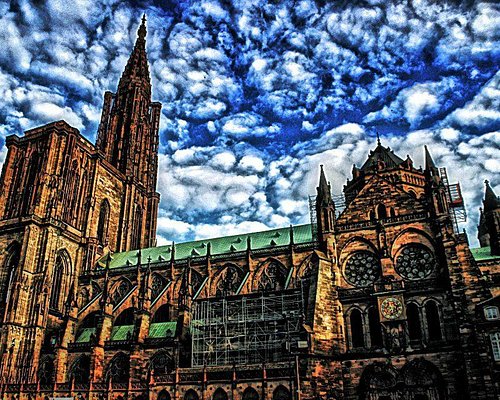
1. Cathedrale Notre Dame de Strasbourg

2. Basilique Notre Dame de la Garde

3. Abbaye du Mont-Saint-Michel
4. Cathedrale Notre-Dame de Reims
5. Cathedrale Notre-Dame d'Amiens
6. Sanctuaire Notre Dame de Lourdes
7. Saint Germain des Pres Quarter
8. Cathedrale Notre-Dame
9. Basilique Saint-Sernin

10. Saint Catherine's Church
11. Abbaye de Fontfroide
12. Cathedrale de la Major

13. Basilica Cathedral of Saint-Denis

14. Cathedrale Ste-Croix

15. St. Andre Cathedral

16. Abbaye de Fontenay

17. Eglise Saint-Jean-Baptiste

18. Église Saint-Joseph

19. Church of Les Jacobins

20. Abbaye Notre-Dame de Senanque

21. Grotte de Massabielle
22. Cathedrale Saint-Corentin
23. Cathedrale Notre-Dame de Laon
24. Basilique de Vézelay

25. Abbaye de Jumieges

26. Cathédrale Saint-Jean-Baptiste de Lyon
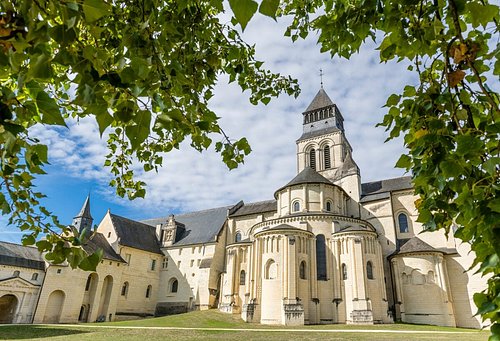
27. Abbaye royale de Fontevraud

28. Sanctuaire du Mont Sainte Odile
29. Abbaye Saint Victor
30. Cathedrale Notre-Dame

What travelers are saying
Catholic Itineraries »
France », catholic pilgrimages in france.
Our Catholic tours to France begin as we set out on a life-changing pilgrimage to the Marion Shrines of France, we’ll be reminded that the Blessed Virgin Mary often chose young and simple Christians upon whom to bestow rare spiritual experiences and miracles. This beautiful Holy Land will serve up many unforgettable gifts: magnificent basilicas, cathedrals and convents; renowned works of art depicting scenes from the Bible, the Trinity, and other religious themes; holy shrines commemorating Eucharist miracles and markers honoring the Saints who played important roles in the history of Christianity in France.
Life Changing pilgrimage to Lourdes, Lisieux and Paris
At the grotto of Massabielle outside Lourdes, we’ll visit the Shrine of Lourdes where 14 year-old Bernadette Soubirous had the first of 18 visions of what she termed “a small young lady” (ua petita damisela) standing in a niche in the rock. In lovely Lisiex, we’ll visit the home of St. Therese, the Little Flower of Jesus, who at age 15 became a nun in the enclosed Carmelite community of Lisieux, Normandy. (The impact of her posthumous publications, including her memoir, the Story of a Soul, make her one of the greatest saints of the 20th century.) We’ll see vibrant, beautiful Paris, “The City of Light”, and thrill at such sights as the Notre Dame Cathedral and the Chapel of Our Lady of the Miraculous Medal, site of three apparitions of the Virgin Mary in 1830.
And we, like pilgrims from other times, will find that the masses, meditations and holy communions we celebrate along the way will draw us together as a community, will enrich our lives immeasurably and will remind us of our blessings and the call to stewardship as followers of Jesus Christ.
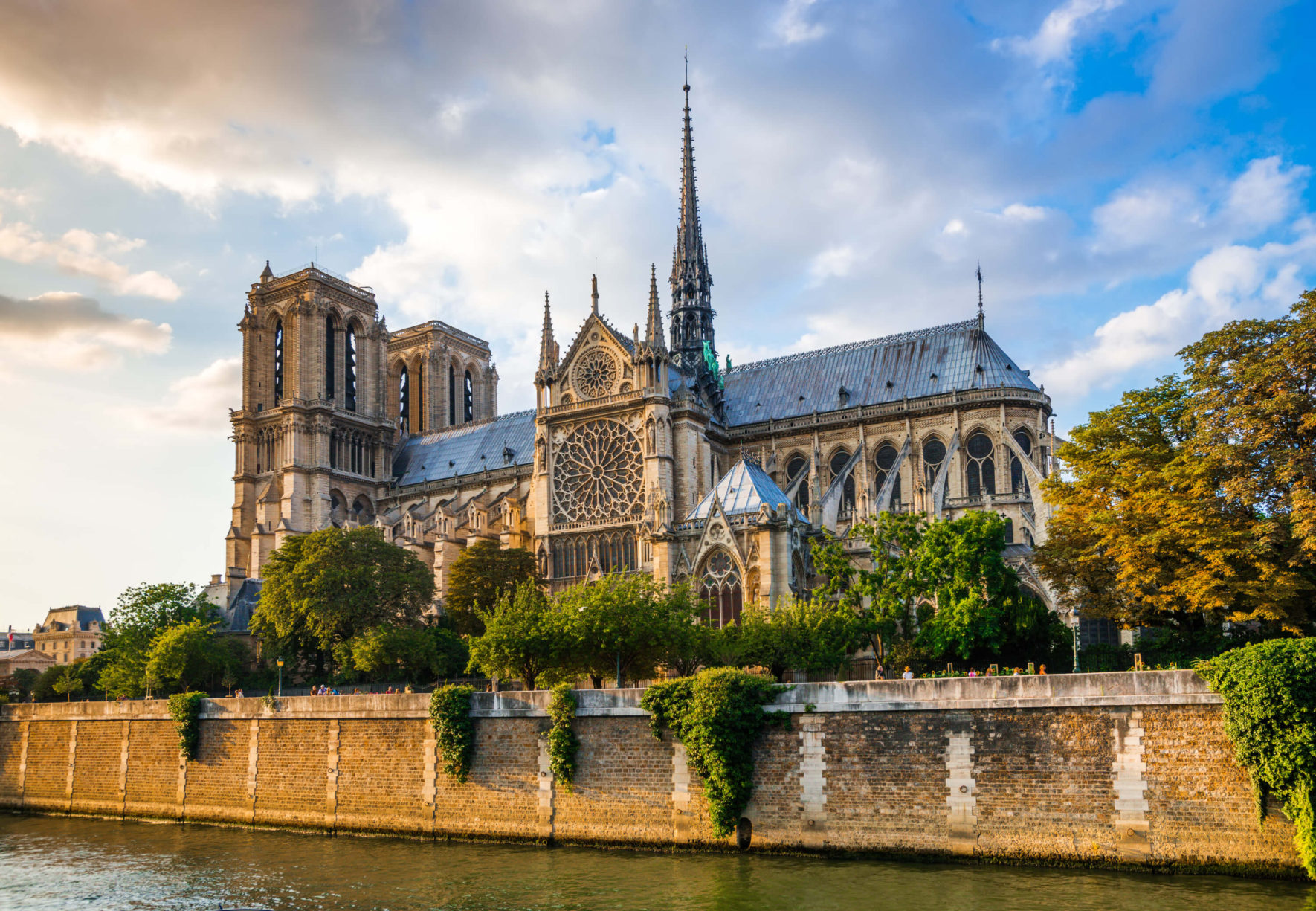
| France
Marian shrines – portugal, spain & france- 13 days/ 11 nights, extraordinary faith & miraculous lives: a pilgrimage to france- 10 days/ 8 nights, a spiritual journey to the shrines & cathedrals of france- 10 days/ 8 nights, in the footsteps of the saints- 12 days/ 11 nights, examen the call: pilgrimage to spain and france- 11 days/ 9 nights, marian shrines & the way of st. james- 10 days/ 8 nights.
Religious tourism in Europe: pilgrimage sites, sacred journeys, and cultural heritage
Join millions on sacred journeys to Europe’s pilgrimage sites, where ancient traditions meet modern seekers in a quest for meaning.
Pilgrimage is one of the fastest growing movements in the world, with more than 330 million people going on pilgrimage every year. [1] In contemporary Europe, the renewed popularity of pilgrimage stands as a testament to the human pursuit of spiritual fulfilment despite prevailing currents of secularisation and declining religious observance. [2]
Reflecting on the Camino pilgrimage—a time-honoured Christian journey tracing its origins from France to the revered destination of Santiago de Compostela in north-western Spain—we witness a remarkable evolution. During the early 1980s, only a few thousand pilgrims trod its paths. However, by 2019, the annual tally had undergone a remarkable revival, attracting nearly 350,000 individuals to embark on this sacred journey. [3]
For writer and journalist Peter Stanford, the current trend represents a process of repurposing rather than resurrection. Regardless of whether their motivation stems from faith, a connection to nature, or a simple desire for cultural exploration, all modern-day pilgrims are immersed in a profound search for meaning. It is this fundamental quest for significance that lies at the core of pilgrimage, distinguishing it from conventional tourism. [4]
Modern pilgrims: motivations and perspectives
Pilgrimage routes have a unique characteristic: they are born from a deep religious calling, typically involving visits to sacred destinations or acts of penance. They can be seen as laying the groundwork for the modern phenomenon of tourism. However, as time has progressed, the motivations driving these journeys have undergone significant shifts. Today, alongside traditional religious pilgrimages, we observe the emergence of secular and spiritual pilgrimages. [5]
Professor Noga Collins-Kreiner from the University of Haifa suggests that pilgrimage is entering a phase of “rejuvenation,” wherein it transcends its solely religious roots and adopts new dimensions, particularly emphasising personal spirituality. [6]
Pilgrimage routes and destinations
One of Europe’s most significant pilgrimage routes is the Camino de Santiago. [7] It is not merely a singular path but rather a network of routes spanning across a vast region encompassing France, Spain, and Portugal. Its origins trace back to the 9th century when the tomb of the Apostle St. James was unearthed in Galicia, establishing it as one of the foremost pilgrimage routes of the Middle Ages. [8]
Another notable pilgrimage path, the Via Francigena, [9] spans 1,800 km from Canterbury to Rome, mirroring the journey undertaken by Archbishop Sigeric in 990 AD to meet Pope John XV and receive the pallium investiture. Since receiving recognition as a Cultural Itinerary from the Council of Europe in 1994, the Via Francigena route has experienced a steady growth in the number of pilgrims and walkers embarking on the journey. By 2015, this figure had reached 40,000 individuals per year. [10]
In the context of Europe, while pilgrimage sites with Christian origins often enjoy great renown and recognition, it is important to note that pilgrimage destinations do not have an exclusively Christian background. Furthermore, the rich and diverse tapestry of European pilgrimage sites also encompasses locations with different religious or secular origins.
The Hill of Tara stands as a prime example of a pilgrimage site with Pagan [11] origins. Situated in the Boyne Valley within County Meath, Ireland, this site holds profound religious and civic significance in Pagan Ireland. Renowned for its rich history and ancient monuments, the Hill of Tara has been a focal point of religious, cultural, and political activity for over 5,000 years. Today, it remains a popular destination for tourists and scholars intrigued by Irish history and culture. [12]
Interfaith dialogue and shared pilgrimage
Exploring the rich tapestry of European pilgrimage routes reveals diverse themes and networks, from historical to religious and environmental. Within this context, interfaith dialogue and shared pilgrimage experiences hold significant importance, reflecting the dynamic cultural landscape of Europe.
Embedded within the diverse fabric of European pilgrimage routes, the European Cultural Routes program was established in 1987 by the Council of Europe, coinciding with the Declaration of Santiago de Compostela. [13] Among its inaugural recognitions was the ‘Ways of Pilgrimage to Santiago de Compostela’, symbolising a profound nexus of historical, religious, and environmental themes. This route, annually traversed by tens of thousands of pilgrims, serves as a focal point for interfaith dialogue and shared pilgrimage experiences, embodying the dynamic cultural landscape of Europe. [14]
Emerging networks are being established along either new or existing paths, encompassing a variety of themes including religious, historical, and awareness-raising routes. Examples range from religious networks like the sites associated with St. Michael [15] across Europe, to historical paths such as the Wool and Silk Road, [16] as well as awareness-raising trails like the Way of the Transformed Lands. [17]
Through her research, anthropologist and professor Catrien Notermans has encountered instances of non-believing tourists lighting candles for saints, Muslims extending invitations to Christian pilgrims to dine in their mosques, and women bringing their menstrual blood to a Catholic altar in a cave. These are examples of a growing trend in contemporary European pilgrimage, marked by interfaith dialogue and shared pilgrimage. [18]
Another interesting topic is the rise of green pilgrimage. The European Green Pilgrimage Network (EGPN) [19] started from the Green Pilgrimage Network, a global group of pilgrim cities committed to eco-friendly pilgrimage. Its goal is to reduce the environmental impact of pilgrimage and to encourage environmental care as a religious duty. Its website provides guidance on several essential aspects to consider when incorporating eco-friendly practices into a pilgrimage city, place, or route. The network includes pilgrimage sites and religious groups across Europe, from Canterbury in the United Kingdom to Vadstena in Sweden, and from Trondheim in Norway to Etchmiadzin in Armenia.
As pilgrimage experiences a revitalisation, it welcomes new dimensions and motivations, leading to a rise in interfaith dialogue and shared pilgrimage endeavours. This trend promotes understanding and unity among various religious and cultural groups. Additionally, initiatives like the European Green Pilgrimage Network underscore the growing acknowledgement of environmental sustainability within pilgrimage practices, enhancing the spiritual journey for modern-day pilgrims.
Talía Jiménez Romero
To all news items ->
Learn more about religion and society on the EARS Dashboard
[1] European Green Pilgrimage Network
[2] Gender, Nation and Religion in European Pilgrimage
[3] Secular pilgrims: why ancient trails still pack a spiritual punch
[5] The rejuvenation of European pilgrimage routes
[6] The rejuvenation of European pilgrimage routes
[7] Camino de Santiago
[8] The rejuvenation of European pilgrimage routes
[9] Via Francigena
[10] The rejuvenation of European pilgrimage routes
[11] Paganism in Europe: A contemporary revival unveiled
[12] The hill of Tara
[13] The rejuvenation of European pilgrimage routes
[14] The Cultural Routes of the Council of Europe
[15] Itinéraire Européen Saint-Michel
[16] Via della Lana e della Seta
[17] Il Cammino nelle Terre Mutate
[18] Gender, Nation and Religion in European Pilgrimage
[19] European Green Pilgrimage Network (EGPN)

Related articles

Privacy Overview

France Religious Tour. Visit important sights in a pilgrimage to Lourdes!
- Europe Religious Tours Offers
- Excursions Included
- Family friendly
FRANCE RELIGIOUS TOUR
PRICES START FROM ONLY £650
We can arrange various group departures during the year
CONTACT US TODAY
In pilgrimage, God and man seek each other and meet spontaneously and mysteriously. Pilgrimage is actually your response to God and thanks for reaching a chosen and blessed place. Throughout the ages, the Holy Places have attracted numerous pilgrims, who have always fulfilled with great emotion and joy their thoughts of pilgrimage to the footsteps of Him, who discovered His love and gave us eternal life through His Resurrection. The organic link between man’s response to God and the journey to these Holy Places is FAITH. God bless you all!
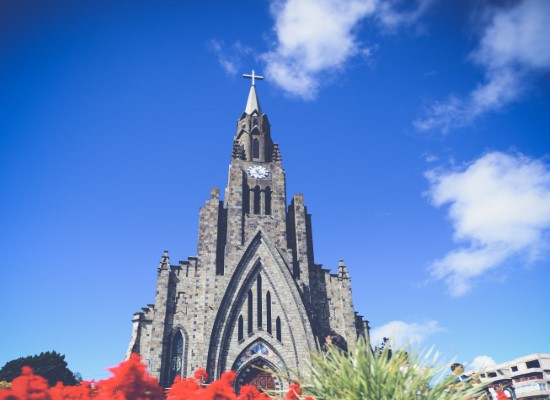
World Lifetime Journeys in partnership with Travelstonehenge offers you the opportunity to participate in several religious and cultural pilgrimages through different countries in Israel and Europe. The program of these pilgrimages was established with the help and consultation of several priests (Romano-Catholic, Greek-Catholic, Orthodox, Anglican, Evangelical) who will also be participating along with the other tourists.
The study was made very carefully so that during the entire duration of the pilgrimages the participants could reach the most important points of religious, cultural and tourist interest in the respective area. We also announce that daily spiritual and religious programs, conducted by the accompanying priests, will be held in the most well-known cathedrals and churches on the itinerary. At each pilgrimage you will benefit from a tour guide from our agency, an English speaker, who will accompany you along the way. Our guide is at your disposal regarding any problems that will arise during the trip. Before you go on a pilgrimage, we recommend that you read and view the links below for each pilgrimage.
This can be a great and unforgettable religious pilgrimage in France!
ITINERARY HERE
Day 1: welcome to paris.

Day 2: Notre Dame Cathedral- Sainte Chappelle- Louvre Museum
Day 3: versailles.
Breakfast. Today we will take a short trip to Versailles. Someone said that “seeing Paris without visiting the Versailles Palace is like going to the sea and not getting into the water.” Almost all of today we will dedicate ourselves to this special place. The Palace of Versailles was the residence of the kings of France starting with Louis XIV and continuing with Louis XV and XVI. It was an important symbol of the French monarchy. It has become a museum since 1837, at the same time being an important tourist destination, not only of Paris but also of France. The Palace is also famous for the fact that in the Hall of Mirrors the Treaty of Versailles was signed, which officially ended the First World War. I do not tell you more, the rest you will find out from the tour guide who will accompany you and through the audio guide that will be made available at the entrance. I’m just pointing out: The Mirror Hall, the Royal Bedroom, the Reception Hall, the Great Battles Gallery, the Palace Gardens.
Day 4: Tarbes-Lourdes
Day 5: lourdes sanctuary, day 6: wax museum - st. bernadette museum, day 7: fly back to the uk.
After breakfast, we clear the rooms and store our luggage in a hotel room. Holy Mass celebrated by the priest of the group. Free time for the last shopping. We board our luggage by bus and head to Tarbes airport where we will fly to London Luton Airport. At Luton airport, after customs formalities, we embark on a bus that will take us back to London.

WHAT IS INCLUDED
Bus ticket London – Paris;
Plane ticket Paris – Lourdes;
Plane ticket Lourdes – London;
Hand luggage (carry-on bag) in the cabin with maximum dimensions 40x30x20 cm and a check-in bag of maximum 10 kg / person with dimensions 55x40x20 cm; – airport charges;
Transfers and bus transport according to the schedule;
6 nights accommodation at 3 and 4 stars hotels with two and three beds rooms (of your choice);
Accompanying English speaking tour guide throughout the pilgrimage period;
A priest – spiritual guide;
Visits according to the program;
Pilgrim’s brochure with written daily schedules; The entrance fee of the bus/coach in various cities; Insurance in case of insolvency or bankruptcy of the travel agency.
WHAT IS NOT INCLUDED
Single room add-on £150 / person – if you want to be accommodated alone in one room;
Lunch (for those who want that);
Travel medical insurance for 7 days;
The entrance fees to various tourist objectives (where payment is required);
Services other than those in the program; Personal expenses; Tips for bus drivers (max £ 5) – optional.
OFFER TERMS AND CONDITIONS
Registration deadline for trips scheduled between SEPTEMBER – DECEMBER 2020: JUNE 1ST, 2020
Required documents: Passport valid for at least 6 months from the date of departure for the pilgrimage.
Registration conditions: When registering, the travel document (valid passport) is required to conclude the contract with the pilgrim.
Payment will be made as follows: 50% upon registration The remaining 50%, minimum 60 days before departure.
Price is calculated for a group of minimum 40 persons.
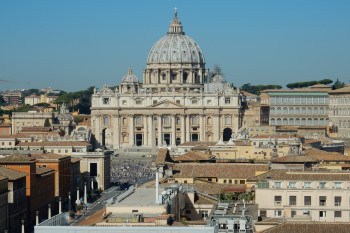
IMPORTANT INFO
Please note that the price “From” shown at this holiday package/tour is for the included services that are described and it’s for guidance only. The final price will depend on your departure dates that you choose. In some situations we will be able to offer you different promotions that are active during the time you are ready to book and the final price might be lower than the one shown above. Please enquire with us if interested in this holiday and we will be happy to provide you with a free no obligation Quote.
Book your next Holiday with us and we give you the best recommendations on what to do and see. All our Holidays and Offers are subject to availability. They are obtained from our partners and suppliers. We carefully choose who we work with, so we can give you the maximum satisfaction. Terms and Conditions Apply. All prices are correct at the time of publishing the holiday or offer. Price From is valid for the cheapest holidays we can get throughout the season. Travel with World Lifetime Journeys!
THANK YOU FOR CHOOSING WORLD LIFETIME JOURNEYS!
Breakfast. The day begins with Île de la Cité, where we will visit two landmarks: Notre Dame Cathedral – the most important Gothic monument in France and Sainte Chapelle – the chapel built by King Louis IX to house the Savior’s thorny crown. Next is the Louvre Museum, one of the oldest and richest museums in the world and the Tuileries gardens. We then move to the Bastille monument, the site of the former terrifying prison of the 14th century, then to the Sacre Coeur Cathedral, built in the Byzantine Roman style and we end the day in the Montmartre neighbourhood – the district of artists and writers. Accommodation and dinner.
We return to Paris in the evening, where we serve dinner and enjoy a well-deserved rest.
Breakfast. 8:00 – departure to the airport where we will embark for TARBES – LOURDES. Accommodation and one hour rest. We will visit the Sanctuary of the Blessed Virgin Mary. In the evening we will participate in the international procession with candles accompanied by the prayer of the Rosary. Dinner at the hotel restaurant.
Breakfast. Optional – bathing in the sacred water; The Lourdes Sanctuary is the most famous pilgrimage site in the world, famous for its miraculous healing and spring water (believed to possess healing properties). We will visit the home of Saint Bernadette Soubirous. At 5:00 pm we will take the Way of The Cross under the guidance of the priest. Dinner. In the evening, participation in the international procession with candles accompanied by the prayer of the Rosary.
Breakfast. Attending the Holy Mass celebrated by the priest of the group. Then we visit the Wax Museum, where we can admire wax figurines representing the life of Saint Bernadette, the life of Jesus and a wonderful panorama of the sanctuary of the Virgin Mary, which hosts about 100,000 pilgrims daily. St. Bernadette Museum and then free time for shopping. Evening dinner and participation in the international procession with candles accompanied by the prayer of the Holy Rosary.
Sharing is caring!
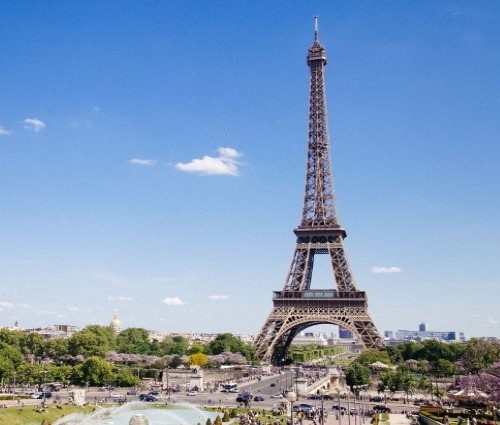
Tour Reviews
There are no reviews yet.
Leave a Review
Cancel reply.
By using this form you agree with the storage and handling of your data by this website. *
I agree to be signed up for the newsletter! Yes please, I would like to hear from you about your travel offers, services, products etc.
You May Also Like

Hotel Mlini **** in Mlini is a nice Mediterranean holiday spot near Dubrovnik

DoubleTree by Hilton in Nungwi, Zanzibar

Mont-Saint-Michel , Wonder of the West
Inspiration
Normandy Cultural Heritage Spiritual Tourism Cities

Reading time: 0 min Published on 2 February 2024, updated on 15 April 2024
From every angle, Mont-Saint-Michel is a wonder, almost a mirage. Its reflection, in the splendid bay of the same name, doubles the illusion. Behold the abbey, an architectural jewel and its gardens. Come and listen to the religious hymns of monks and nuns. Observe, from above, the exceptional view of the Mont-Saint-Michel Bay.
One of the most visited sites in France
Classified as a UNESCO World Heritage Site since 1979, Mont-Saint-Michel is one of the most visited sites in France! Every year, 2.5 million people from all over the world come to discover the sacred Mount. Among them, tourists and pilgrims, in search of discovery or spirituality.
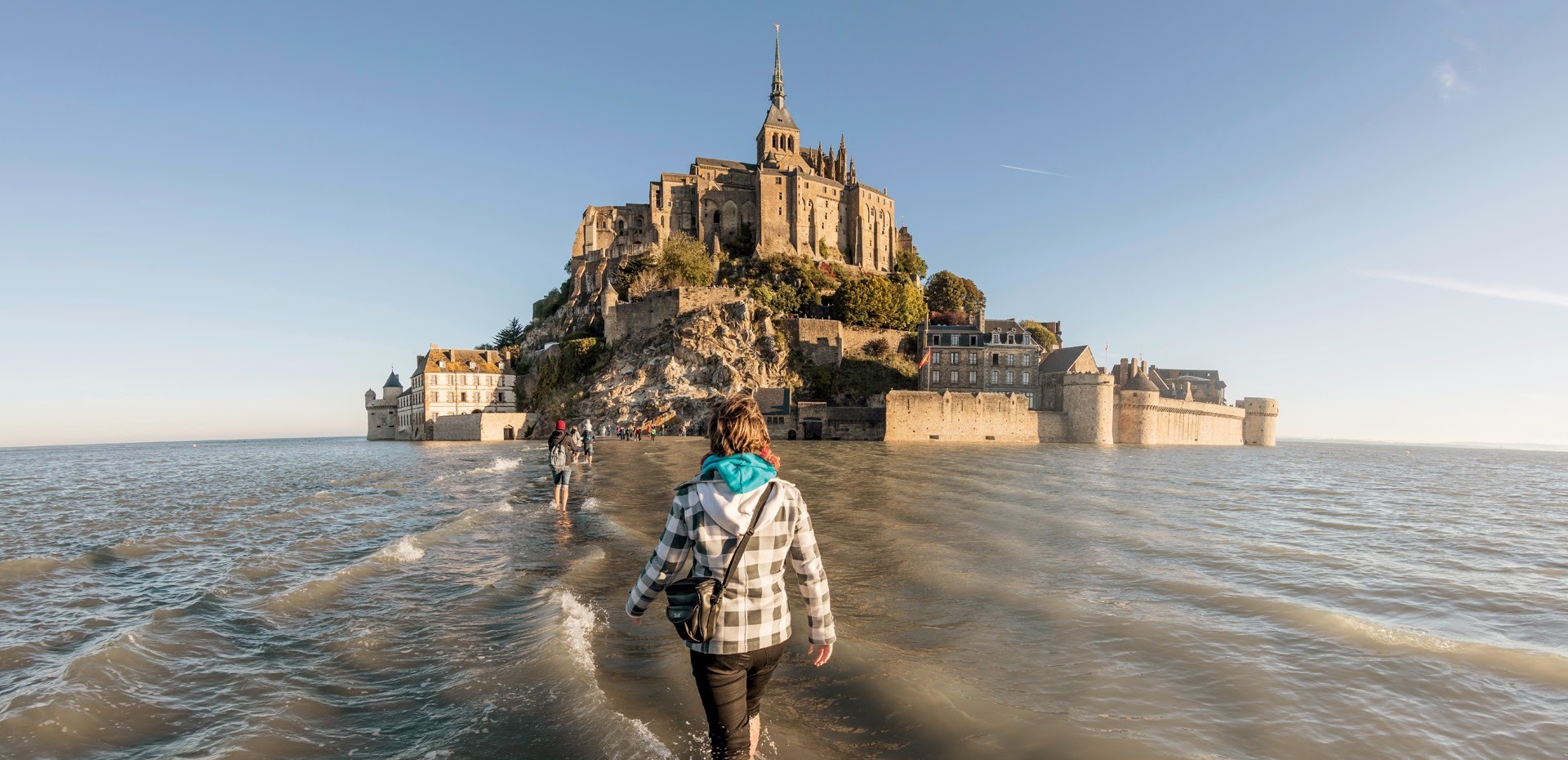
Mont-Saint-Michel, a sacred place steeped in history
Mont-Saint-Michel owes its existence to Archangel Saint Michel (hence its name), bishop of Avranches. At the request of the Saint, the bishop had a sanctuary built in 709 on Mount Tomb.
In 966, at the request of the Duke of Normandy this time, a Benedictine community took over the rock, on which a Benedictine abbey was built.
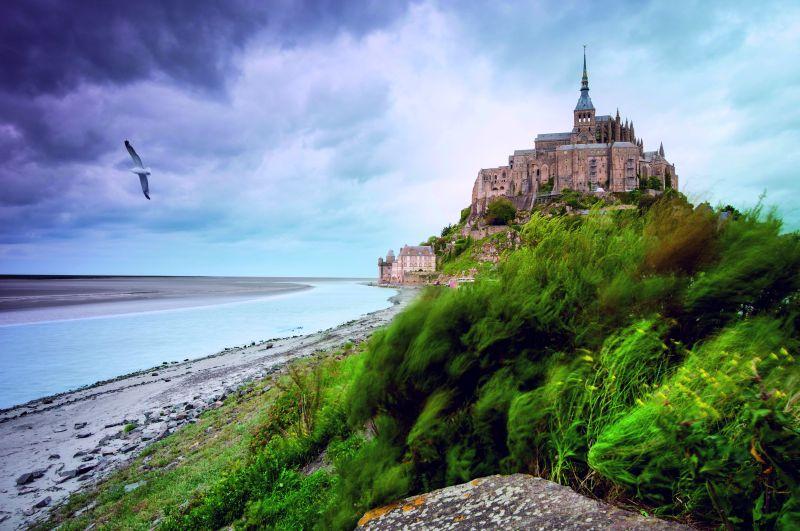
A most fabulous medieval construction site
Gradually, over the centuries, the complex continued to be built: the Romanesque abbey church and monastery buildings were built during the 11th and 12th centuries. And finally, the buildings of the Wonder (including the cloister and the refectory) were built during the 13th and 16th century.
Not to mention the protective military constructions in the 14th century (which helped to preserve the mount and its village from the Hundred Years War).
All of those constructions were a miracle : brought back from the Chausey Islands , the granite blocks were carved and then hoisted to the top of the mountain.
Ultimate religious site
Throughout the centuries, Mont-Saint-Michel has always been a renowned religious site . It was, along with Rome and Santiago de Compostela, one of the most important pilgrimages of the Medieval West.
Its primary vocation are prayers and welcomings since 2001 with the presence of the Brothers and Sisters of the Monastic Fraternities of Jerusalem. It is therefore quite natural that Mont-Saint-Michel is now one of the 13 Sanctuary Cities of France.
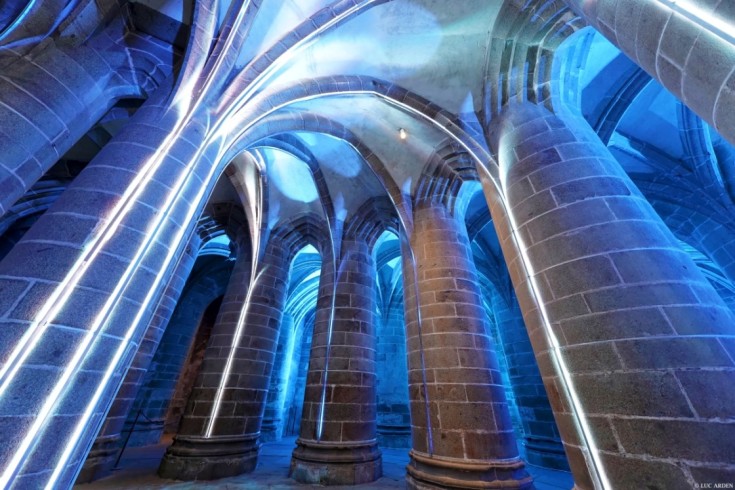
The must-see attractions of Mont-Saint-Michel
Visit the museums:
- Historical or the museum of the sea and ecology.
- Discover the Tiphaine dwelling, the historic home of the knight Bertrand du Guesclin (constable of the armies of the King of France);
- Admire the parish church, the pilgrim's house and its religious library.
- Cross the Mont-Saint-Michel Bay with a guide.
Beware Adventurers! Venturing alone is prohibited and very dangerous. The quicksand and rising waters have been no good for many pilgrims in the past... It is not for nothing that the mountain was called the "Mont-Saint-Michel at the risk of the sea’’.
Are you ready to discover this beautiful world heritage?
Visit Mont-Saint-Michel (External link) Prepare your stay in Normandy (External link)

- Visit the Mont Saint Michel
FACEBOOK - Mont-Saint-Michel TWITTER - @mt_saint_michel

Visiting the Mont-Saint-Michel: what is there to see?
This is a must-see French landmark and it’s worth allowing enough time to visit its accompanying museums, hotels, restaurants and boutiques. In addition to the abbey itself, don’t miss:
The Musée de la Mer et de l’Écologie , housing a collection of 250 ancient boat models where you can learn about the Mont Saint-Michel Maritime Character Restoration project
The Musée Historique , charting 1,000 years of history with its collection of ancient weapons, medieval instruments of torture, Louis XI’s iron cell and the oubliettes
The Logis Tiphaine , the former home of Knight Bertrand du Guesclin – 14th-century constable of the armies of the French king – and his wife Tiphaine de Raguenel, a famous astrologer who used to predict the world’s fate by the stars.
Contact Office de Tourisme Corps de Garde des Bourgeois 50170 Le Mont Saint-Michel
- Visitez le Mont Saint-Michel
- Horaires des marées
- Visitez le barrage du Mont-Saint-Michel
- L'Abbaye du Mont Saint-Michel, horaires des offices
- Découvrez les Villes Sanctuaires en France
Find out more: - 6 mysteries surrounding Mont-Saint-Michel - How to spend a perfect family day out at Mont-Saint-Michel - All you need to know about the Mont-Saint-Michel

By Redaction France.fr
The magazine of the destination unravels an unexpected France that revisits tradition and cultivates creativity. A France far beyond what you can imagine…
Visit Alençon

Normandy: Visit the Omaha Beach American Cemetery & Memorial in Colleville-sur-Mer

Destination: Etretat

Visit Honfleur, Romantic Normandy

Monet & Friends - Life, Light & Colour

Adventurous Things to do in France
Alps - Mont Blanc
Live the impressionist experience and the emotions that inspired artists in Normandy
Visit the jeanne d’arc museum in normandy.


Religions In France – What You Need To Know
By: Author Christine Rogador
Posted on Published: July 10, 2023 - Last updated: July 17, 2023
The French people’s religious beliefs have influenced their history, society, and government.
In French society, the Catholic Church has always played a key role.
However, as time has passed, religious diversity has increased. Many new faiths have arisen to represent the dynamic nature of contemporary French culture .
Today, we will explore the religions in France, their historical background, and their impact on the French population.
Things you'll find in this article
Catholicism and Other Christian Religions
People with no religion in france, islam in france, judaism in france, other religions in france, religions in france – what you need to know.
In France, Catholicism has been the dominant religion for centuries. Throughout the ages, it was essential in influencing the development of French institutions, culture, and politics.
The French Catholic Church’s relationship with the state has been fraught, with periods of close partnership and periods of friction and conflict.
Around 47% of the people living in France consider themselves to be Catholic or Christian.
Yet, in recent decades, both religious participation and affiliation have been on the decline. Although a sizable portion of the population identifies as Catholic, polls show that only a fraction of those people engage in religious practices like weekly Mass attendance.
In comparison to Catholicism, Protestantism is less widespread in France. Early converts to Protestantism can be traced back to the 16th-century Reformation.
Today, a wide variety of Evangelical, Reformed, and Lutheran churches may be found across France. French Protestants make up a sizable minority of the country’s total population, however, they’re still outnumbered by Catholics.
French Protestants make up a smaller share of the population than Catholics do. It’s worth noting, though, that Protestantism as a whole is incredibly varied, with many distinct sects and interpretations. Even among Protestants, there is a range in terms of how seriously people take their faith.
France is home to a wide variety of Christian traditions beyond only Catholicism and Protestantism.
Some examples of these are Anglicans and Orthodox Christians, although there are many other Christian denominations as well.
Despite their smaller numbers in comparison to Catholicism and Protestantism, these other Christian groups help to make France a more religiously diverse country.
In France, those who identify as “no religion” people are those with no affiliation with any particular religious tradition.
This group’s numbers have been rising rapidly in metropolitan France during the past decade. About a third of the population in metropolitan France (those between the ages of 18 and 59) has no religion, according to studies.
Many reasons, including secularization, increased individualism, and shifting perspectives on the role of religion in society, have contributed to the rise of religious apathy. Many people in this category might consider themselves atheists, agnostics, or simply not religious.
In France, where lacité is a guiding principle, the idea of “no religion” fits in well.
Lacité, a core principle of the French Republic, advocates for the secularization of public life and protects the separation of church and state. The rising number of people who say they are atheists or agnostics reflects a social shift toward secularism and the public display of religious freedom.
While the increasing number of French people who no longer identify with any religion presents challenges to established churches, it also emphasizes the need to protect people’s right to believe or not believe what they choose. The lacité principle provides a foundation for a pluralistic and welcoming society in which people are free to follow or not follow any particular religious tradition.
Islam is the second largest religion after Catholicism, forming 4℅of the population.
After WWII, many Muslims emigrated to France from the Maghreb region, which includes Algeria, Morocco, and Tunisia which were occupied by France during the war.
Thanks to the contributions of these new arrivals, France now has one of the greatest Muslim populations in all of Europe.
Islam is more than a religion to people of the Muslim faith; it is also a significant element of their historical and cultural heritage. It forms their beliefs, customs, and sense of community.
For some people, Islam comes to represent their entire way of life, from the language they speak to the food they eat to the music they listen to.
There is a wide range of religious practices and understanding among France’s Muslim population.
Some Muslims are quite religious, while others consider themselves to be secular Muslims since they only identify with the cultural aspects of Islam and not the religion itself.
This variety is a reflection of the great variety of opinions, customs, and experiences found among France’s Muslim population.
The historical context of migration, the diversity within the Muslim community, and the complex processes of cultural and religious identity are all key to understanding the role of Islam in France.
Inspiring continuing dialogues and negotiations among various religious, cultural, and secular elements in French society, the experiences of Muslims in France continue to alter the country’s social fabric.
The influence and popularity of Buddhism in France have skyrocketed since the turn of the millennium. The country has one of the largest Buddhist groups in a Western country, about 2% of the population. The estimates range from one million strict devotees to five million people who are affected by Buddhist beliefs.
It is interesting to note that many French Buddhists do not consider themselves to be primarily “religious.”
French Buddhism, according to the Paris-based Institute of Science and Theology of Religions, is characterized by a “missionary nature” and is presently experiencing a process of “inculturation.”
This might be considered a new stage in Buddhism’s development, analogous to the adaptations that took place in China and Japan.
As a result, it’s feasible that a distinct form of the doctrine, sometimes called “French Buddhism,” would arise.
The European headquarters of the Fo Guang Shan monastic order, a major Buddhist sect, relocated to France in 2012. It was the largest Buddhist temple in Europe at the time, and its construction was a sign of Buddhism’s growing popularity there.
The growth of infrastructure and support for Buddhist communities in France is seen in the construction of Buddhist institutions. The spiritual practice, meditation, and propagation of Buddhist teachings all take place primarily in these places.
French Buddhism, with its vast number of adherents and process of “inculturation,” has the potential to affect the future of Buddhist practice and doctrine in the Western world.
While France is home to the EU’s largest Jewish population, the Holocaust had a tremendous effect on its history. A large number of Jews were persecuted and deported from the country, causing devastating loss and upheaval.
The Jewish population of France, however, has proven its endurance by actively protecting and celebrating its cultural traditions.
Today, the Jewish community forms 1% of the religious population in France.
Synagogues, Jewish community centers, and Jewish schools all play crucial roles in facilitating Jewish socialization, religious practice, and the transmission of Jewish values and ideas. Celebrations, memorials, and intellectual discussions can all take place in these areas.
France’s Jewish population has indeed faced difficulties like antisemitism on occasion, but measures have been taken to guarantee their protection.
The French government has taken action to prevent hate crimes and discrimination. This is a sign that it is serious about protecting the safety and civil liberties of France’s Jewish inhabitants.
Like any other religious group, the Jews of France are a diverse and complex bunch. Some members of the community may be more religiously observant than others.
Others may have different understandings of Jewish law and participate less actively in Jewish institutions.
However, they can come together since they are all dedicated to keeping their traditions alive.
About 5℅ of France’s religious population adheres to “other religions,” a broad category that includes many other faiths and philosophies.
Among these are Hinduism, Sikhism, Baha’ faith, Paganism, and New Age.
Hinduism’s prominence in France is largely attributable to the influx of people from South Asia.
In several cities around France, Hindus have access to temples and cultural centers where they can pray and interact with others from their faith.
Sikhism is practiced by a small but increasing number of French citizens, most of whom are of Punjabi heritage.
Sikhs in France have access to spiritual counseling, religious ceremonies, and community support thanks to the proliferation of Gurdwaras (Sikh temples) around the country.
There are adherents of the Bahá’ Faith in France as well as other countries. The faith stresses the need for worldwide peace and cooperation and the inherent oneness of all religions.
France is home to a sizable Pagan population that practices a wide variety of polytheistic and earth-based spiritualities. Nature worship, seasonal festivals, and polytheism are all common features of Pagan practices.
The diversified and spiritually diverse New Age movement has also gained adherents in France. Many New Age philosophies draw on tenets from other faiths as well as holistic practices and introspective spiritual questing.
Although these faiths make up a relatively tiny percentage of the total religious landscape in France, they enrich the country’s religious diversity and offer new avenues for those in search of meaning and expression in their lives.
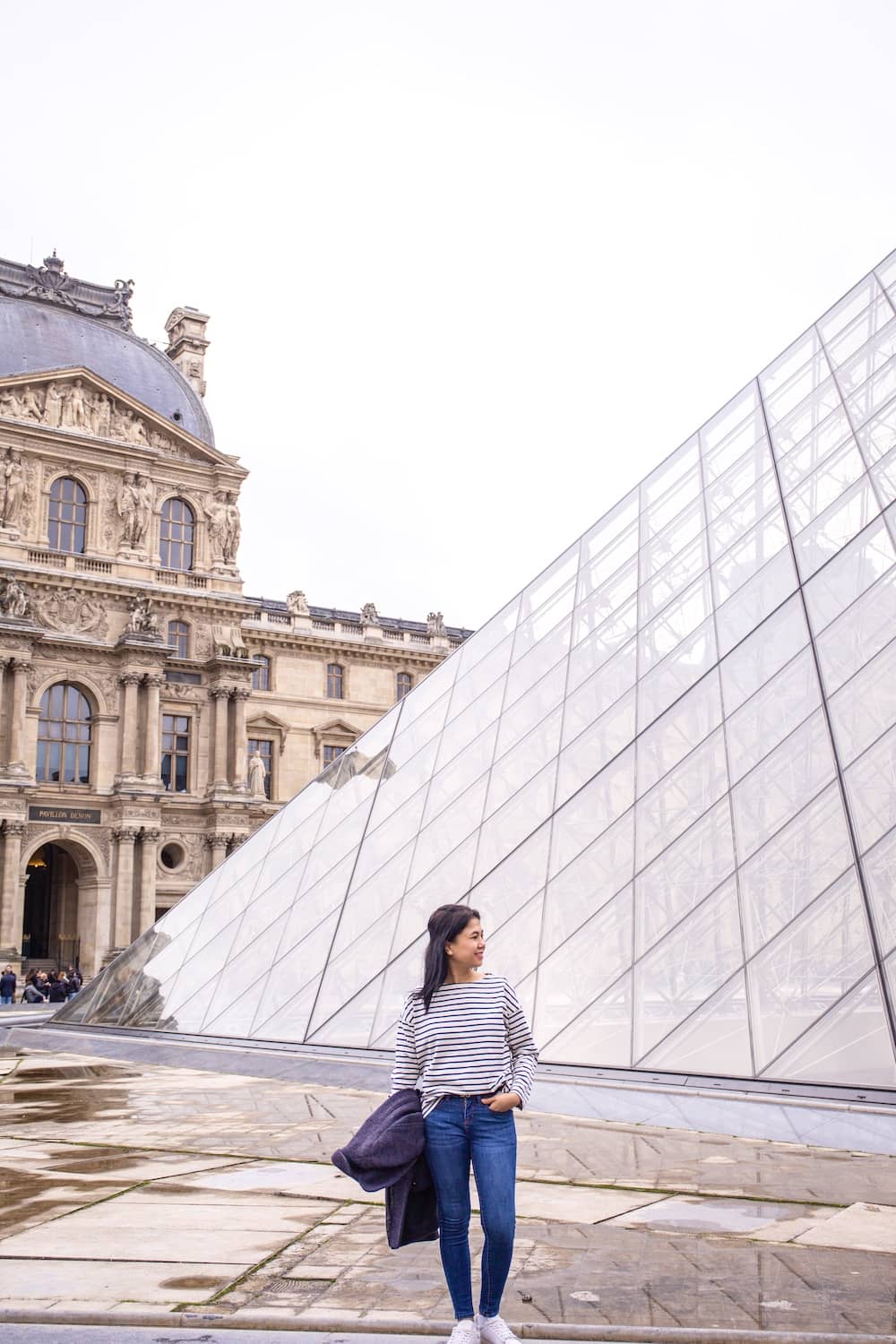
Hi, I’m Christine – a full-time traveler and career woman. Although I’m from the Philippines, my location independent career took me to over 40 countries and lived in 4 continents in the last 10 years, including France. A self-proclaimed Francophile, I love everything France.
Sharing is caring!
- Skip to primary navigation
- Skip to main content
- Skip to primary sidebar
- Skip to footer
TravelAwaits
Our mission is to serve the 50+ traveler who's ready to cross a few items off their bucket list.
The World’s Most Popular Religious Destinations

Phattana Stock / Shutterstock
- Activities and Interests
- Destinations
- History and Culture
- Mexico and Caribbean
- Mexico City
- Middle East
- Religious Sites
- Saudi Arabia
- Vatican City
There are areas of the world where churches and temples attract more visitors than a soccer match. These are some of the most popular religious sites around the globe. How many have you visited?

Sony Herdiana / Shutterstock
1. Mecca, Saudi Arabia
Mecca is the holiest city in the religion of Islam. It’s located on the Arabian Peninsula 210 miles to the south of Medina. An average of 13 million people visit Mecca every year, nearly all of them Muslims. Devout Muslims are encouraged to make the journey to Mecca (the Hajj ) at least once in their lives if they are able, but many make the trip every year. The final month of the Islamic calendar is the busiest. Approximately two million Muslims come to celebrate Hajj . Mecca’s holiness derives from the fact that it was the birthplace of the prophet Muhammad and the site of his first revelation about the Quran.
Sadly, non-Muslims are not allowed inside the city of Mecca; failure to observe this rule will lead to fines or deportation. However, non-Muslims are allowed in Medina, another of Islam’s holiest cities.

Bill Perry / Shutterstock
2. The Wailing Wall, Jerusalem, Israel
Israeli police estimate that over 11 million people visited Jerusalem’s Old City and the Wailing Wall (Western Wall) in 2016. That’s quite the increase from the mere three million people who visited in 2003. Followers of the Jewish faith are the most frequent visitors, with some making more than one trip a year. The wall is also a holy site for Muslims, so control of the wall has long been a subject of contention between the two groups.
The Wailing Wall is a place of prayer that has long been sacred to Jewish people. The original wall dates back to the second century B.C., when it was part of the Second Temple of Jerusalem. The temple was destroyed by the Romans in A.D. 70, and the wall is today all that remains. The extant section of the Wailing Wall connects to a larger wall that encircles the Muslim Dome of the Rock. The Wailing Wall that stands today measures 160 feet long and is 60 feet tall.

Mihai-Bogdan Lazar / Shutterstock
3. Senso-Ji Temple And Meiji Shrine, Tokyo, Japan
The Senso-ji Temple sees about 30 million annual visitors; it’s a must-see for any traveler passing through Tokyo. Senso-ji was built in A.D. 628 and is the city’s oldest temple. The five-story pagoda glows with accent lighting in the evening. During the day, street vendors sell food to tourists on the temple’s Nakamise Street. The Senso-ji Temple is a hot spot during New Year celebrations, consistently ranking in the top 10 for temple attendance during the new year.
Not far from the Senso-ji Temple is the Meiji Shrine, located in Shibuya, Tokyo. Construction began in 1915 and was finished in 1916. The shrine is dedicated to the spirit of the Emperor Meiji and his wife, Empress Shoken. It was erected in an iris garden where the emperor and empress often spent time. The original structure was destroyed during World War II, but it has since been restored. The new building stands in a 170-acre forest. The surrounding evergreen glade contains over 365 different species of trees, all of which were donated by people from different parts of Japan.

cesc_assawin / Shutterstock
4. Vatican City, Italy
Visited by nearly 4.2 million people annually, Vatican City in Italy is a place of pilgrimage for many devout Catholics. The Vatican is an independent city-state located in the middle of Rome. The city’s beauty and history attract tourists and architecture buffs in droves. Vatican City is home to the pope and is considered the spiritual center of the Catholic Church. Saint Peter’s Basilica is a focal point for both worship and sightseeing. It was designed by several well-known architects, including Michelangelo and Bernini. Saint Peter’s is regarded by many as the holiest of Catholic shrines.

Gurgen Bakhshetyan / Shutterstock
5. Notre-Dame Cathedral, Paris, France
Notre-Dame Cathedral is another tourist magnet and site of pilgrimage for Catholics. Located in Paris, Notre-Dame is the most-visited attraction in France and the 13th-most-visited tourist destination in the world. Annual visitors to Notre-Dame are estimated to number 13.7 million. The cathedral is considered one of the finest examples of French Gothic architecture, combining naturalistic sculptures and glowing stained glass with earlier Romanesque architecture.

WitR / Shutterstock
6. Basilica Of Our Lady Of Guadalupe, Mexico City, Mexico
Approximately 20 million people visit the Basilica of Our Lady of Guadalupe every year. The basilica was constructed on the site where Catholics believe the Virgin Mary appeared to an Aztec peasant named Juan Diego in December of 1531. Juan Diego’s tilma, which bears the miraculous likeness of Our Lady of Guadalupe, has been displayed inside the basilica for centuries.
In 1921, a bomb was planted in a flower vase in the basilica, and much of the building’s interior was damaged; the tilma, however, remained unscathed. The Old Basilica was closed for many years following the incident. It still stands, but it’s now joined by its neighbor, the New Basilica, which can hold up to 50,000 people for Mass.

hecke61 / Shutterstock
7. Kashi Vishwanath Temple, Varanasi, India
The Kashi Vishwanath Temple in India is located on the western bank of the river Ganges. The river itself is thought to have healing powers, and the temple is one of the most famous in the Hindu religion. It is dedicated to the Shaiva philosophy — a metaphysical concept of a supreme being or Brahman. The Kashi Vishwanath temple attracts 22 million visitors a year — 3,000 people each day on average. On busy days, nearly 10,000 pass through its doors. The current structure was built in 1780.
The best part about places of religious pilgrimage is that they tend to feature stunning architecture and a vibrant social scene. Taking in the architecture is just a bonus to soaking in the history of these sites — or the spiritual significance, if you’re religiously inclined.


IMAGES
VIDEO
COMMENTS
Last Updated on: 29th December 2023, 01:06 pm A Pilgrimage to France is a must-do for Christians interested in the history of their faith.France is home to some of the world's most beautiful cathedrals, monasteries, and shrines.A Catholic pilgrimage to France allows the pilgrim to visit a huge variety of sites with spiritual meaning from antiquity through to those with connection to quite ...
Mont-Saint-Michel is a unique and fascinating pilgrimage location that offers visitors a glimpse into the history and culture of France. With its stunning Gothic architecture, breathtaking views, and rich history, it is a must-visit destination for anyone interested in the Catholic faith and the history of France. 6. Basilica of Saint-Denis.
The rich Catholic history of France is reflected in the many shrines throughout the country. Known as Gaul during the time of Roman rule, Christianity came to France in the early 2nd Century and took root despite persecution. Much of the great architecture and learning of the middle ages took place in France under the auspices of the Catholic ...
The term sanctuary comes from the Latin Sanctus, meaning Saint. The Association's 19 shrines are all spiritual places and linked to the Roman Catholic faith. In the past, pilgrims travelled to worship the relics of saints or because the sites themselves were remarkable, due to extraordinary spiritual experiences.Today, they are welcoming centres for believers and non-believers alike, who are ...
The religious city of Lisieux draws vast numbers of Catholic visitors. In fact, it is considered the second most important pilgrimage site in France, thanks to its 19th-century saint, Thérèse Martin. Thérèse's popularity also explains Lisieux's extravagant 20th-century hillside basilica, which outdoes its medieval cathedral and is often ...
Photo + text by Marie Eloise Enriquez from France Travel Guides. Located 50 miles southwest of Paris, the Chartres Cathedral, also known as Cathedrale Notre-Dame de Chartres/Cathedral of our Lady in Chartres, is also another pilgrimage site in France that you should visit. It was built and inspired by Gothic architecture.
Once an important Roman colony, Toulouse is full of religious and historical treasures. The Basilica of St. Sernin is one of the finest Romanesque churches in France. St. Thomas Aquinas is buried in the Eglise des Jacobins in Toulouse. The city is also the proud home of 20 historical pipe organs (more than any other city in France).
Lourdes is in south west France, bordering on the Pyrenees. The city rose relatively late to become the second most-visited Christian pilgrimage site in Europe after Rome. Now it attracts around five million pilgrims a year and comes top of many people's list of the great sacred sites of France. In 1858, the peasant girl Bernadette Soubirous ...
February 24, 2024. Normandy, located in the northwest region of France, is a destination rich in history and spirituality, offering visitors a variety of significant religious sites. When exploring religious tourism in Normandy, pilgrims are invited to immerse themselves in centuries of tradition and devotion while witnessing the historical ...
Notre Dame du Haut, Ronchamp, eastern France. And here we have it, the quirky one. Designed by internationally renowned Franco-Swiss architect Charles-Édouard Jeanneret, otherwise known as Le ...
Notre-Dame de la Garde. Notre Dame de la Garde. Notre-Dame de la Garde reaches its peak visitor rate every year on August 15, when travelers and locals participate in a pilgrimage to the church on Assumption Day. On any other day, it remains Marseille's most recognized symbol, translating from French to "Our Lady of the Guard," and aptly ...
Sacred Sites in France. Abbaye aux Dames, Caen. Abbaye aux Hommes, Caen. Aix-En-Provence Cathedral. Albi Cathedral. Alet les Bains Abbey. Amiens Cathedral. Amphithéatre des Trois Gaules, Lyon. Angers Cathedral.
The technological innovation culminated in the world's first virtual pilgrimage, which took place in July 2020. Broadcast in 10 languages, " Lourdes United " drew 80 million viewers. This ...
1. Cathedrale Notre Dame de Strasbourg. 15,271. Points of Interest & Landmarks • Religious Sites. Mairie Sud. By blanchea007. The intricate details of the sculptures tell a story of centuries of dedication and artistic brilliance. See tours. 2023.
Pilgrimage and religious tourism in Lourdes, in Midi-Pyrénées. Lourdes, a world bastion of spirituality, welcomes over 5 million visitors from over 140 countries every year. With 189 hotels, Lourdes is the second biggest hotel town in France. Lourdes is also a small Pyrenean town with a very rich cultural and natural heritage.
Yet the best pilgrimages in France remain vibrant with visitors and are well maintained, and the lines between religious tourism and walking holidays have become somewhat blurred in recent years. France is both the source of many routes to Santiago de Compostela as well as the home nation to a number of world renowned pilgrimage sites.
1440 South Priest Drive, Suite 102 Tempe, Arizona 85281 (877) 732-4845 480-894-8407
Join millions on sacred journeys to Europe's pilgrimage sites, where ancient traditions meet modern seekers in a quest for meaning. Pilgrimage is one of the fastest growing movements in the world, with more than 330 million people going on pilgrimage every year. [1] In contemporary Europe, the renewed popularity of pilgrimage stands as a testament to the human pursuit of spiritual fulfilment ...
Save up to 40% on France Religious Tours 2024/2025. Welcome to France, a country synonymous with elegance, history, and a rich tapestry of cultural experiences. Nestled in the heart of Europe, France is a destination that captivates the heart of every traveler, offering a unique blend of old-world charm and contemporary sophistication. From the ...
The Palace of Versailles was the residence of the kings of France starting with Louis XIV and continuing with Louis XV and XVI. It was an important symbol of the French monarchy. It has become a museum since 1837, at the same time being an important tourist destination, not only of Paris but also of France.
It is therefore quite natural that Mont-Saint-Michel is now one of the 13 Sanctuary Cities of France. The must-see attractions of Mont-Saint-Michel. Visit the museums: Historical or the museum of the sea and ecology. Discover the Tiphaine dwelling, the historic home of the knight Bertrand du Guesclin (constable of the armies of the King of France);
About 5℅ of France's religious population adheres to "other religions," a broad category that includes many other faiths and philosophies. Among these are Hinduism, Sikhism, Baha' faith, Paganism, and New Age. Hinduism's prominence in France is largely attributable to the influx of people from South Asia.
Religious tourism is one of the oldest forms of tourism (Rinschede, 1992), and represents a significant, evolving, growing, and increasingly diverse sector of the global tourism market (Sharpley, 2009). ... Looking for Mary Magdalene: Alternative pilgrimage and ritual creativity at Catholic shrines in France (2012) N.L. Frey Pilgrim stories: On ...
5. Notre-Dame Cathedral, Paris, France. Notre-Dame Cathedral is another tourist magnet and site of pilgrimage for Catholics. Located in Paris, Notre-Dame is the most-visited attraction in France and the 13th-most-visited tourist destination in the world. Annual visitors to Notre-Dame are estimated to number 13.7 million.
262K Followers, 61 Following, 2,890 Posts - Louvre Abu Dhabi (@louvreabudhabi) on Instagram: "A universal museum #LouvreAbuDhabi Open Tuesday - Sunday: 10.00 - Midnight Galleries & exhibitions close at 18.30(20.30 on Fri - Sun) Closed on Monday"